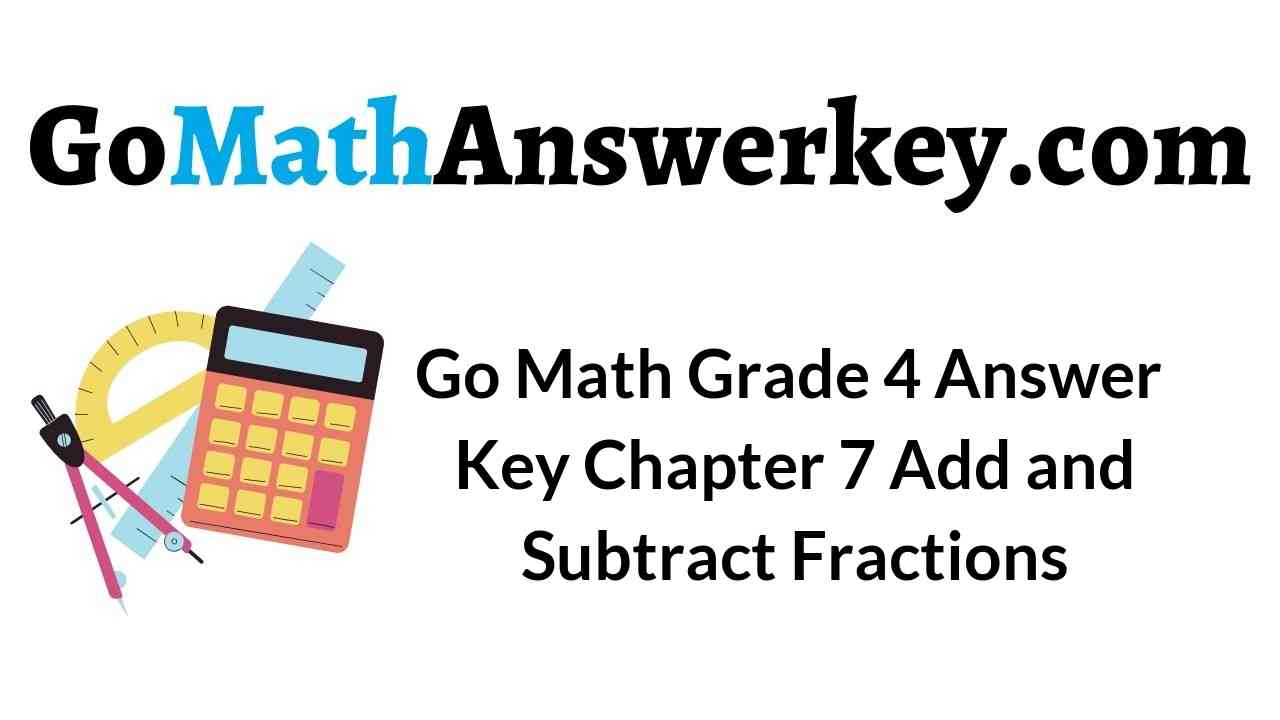Go Math Grade 4 Chapter 7 Answer Key Pdf: Download Go Math Grade 4 Answer Key Chapter 7 Add and Subtract Fractions pdf for free. Get the steps to add and subtract the fractions in our Go Math Grade 4 Answer Key. Here we discuss the different possible models students use to find the correct way to solve the fractions.
Add and Subtract Fractions Go Math Grade 4 Chapter 7 Answer Key Pdf
Students master their understanding if they understand the concepts of adding and subtracting fractions. Check out the below links to get the clear cut explanation for all the questions with images. Get the ability to write the fractions as sum and subtractions.
Lesson: 1 – Add and Subtract Parts of a Whole
Lesson: 2 – Add and Subtract Parts of a Whole
Lesson: 3 – Add and Subtract Parts of a Whole
Lesson: 4 – Add and Subtract Parts of a Whole
Lesson: 5 – Add Fractions Using Models
- Add Fractions Using Models – Page No 401
- Add Fractions Using Models – Lesson Check – Page No 402
- Add Fractions Using Models – Lesson Check – Page No 405
- Add Fractions Using Models – Lesson Check – Page No 406
Lesson: 6 – Subtract Fractions Using Models
Lesson: 7 – Subtract Fractions Using Models
Lesson: 8 – Add and Subtract Fractions
Lesson: 9 – Add and Subtract Fractions
Lesson: 10 – Add and Subtract Fractions
Lesson: 11 – Rename Fractions and Mixed Numbers
- Rename Fractions and Mixed Numbers – Page No. 421
- Rename Fractions and Mixed Numbers – Lesson Check – Page No. 422
Lesson: 12 – Rename Fractions and Mixed Numbers
Lesson: 13 – Add and Subtract Mixed Numbers
- Add and Subtract Mixed Numbers – Page No. 427
- Add and Subtract Mixed Numbers – Lesson Check – Page No. 428
Lesson: 14 – Add and Subtract Mixed Numbers
Lesson: 15 – Record Subtraction with Renaming
- Record Subtraction with Renaming – Page No. 433
- Record Subtraction with Renaming – Lesson Check – Page No. 434
Lesson: 16 – Record Subtraction with Renaming
Lesson: 17 – Fractions and Properties of Addition
- Fractions and Properties of Addition – Page No. 439
- Fractions and Properties of Addition – Lesson Check – Page No. 440
- Fractions and Properties of Addition – Lesson Check – Page No. 443
- Fractions and Properties of Addition – Lesson Check – Page No. 444
Lesson: 18 – Fractions and Properties of Addition
- Fractions and Properties of Addition – Page No. 445
- Fractions and Properties of Addition – Lesson Check – Page No. 446
Lesson: 19 – Fractions and Properties of Addition
- Fractions and Properties of Addition – Page No. 447
- Fractions and Properties of Addition – Page No. 448
Lesson: 20 – Fractions and Properties of Addition
- Fractions and Properties of Addition – Page No. 449
- Fractions and Properties of Addition – Page No. 450
Lesson: 21 – Fractions and Properties of Addition
- Fractions and Properties of Addition – Page No. 451
- Fractions and Properties of Addition – Page No. 452
Lesson: 22 – Fractions and Properties of Addition
- Fractions and Properties of Addition – Page No. 457
- Fractions and Properties of Addition – Page No. 458
Add and Subtract Parts of a Whole Page No – 389
Use the model to write an equation.
Question 1:
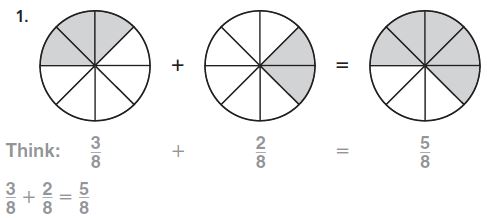
Answer: 3/8 + 2/8 = 5/8
Explanation:
By seeing the above 3 figures we can say that the fraction of the shaded part of the first circle is 3/8, the fraction of the second figure is 2/8
By adding the 2 fractions we get the fraction of the third circle.
3/8 + 2/8 = 5/8
Question 2:
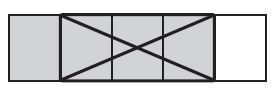
Answer: 4/5 – 3/5 = 1/5
Explanation:
The fraction of the shaded part for the above rectangle is 4/5
The fraction of the box is 3/5
The equation for the above figure is 4/5 – 3/5 = 1/5
Question 3:

Answer: 1/4 + 2/4 = 3/4
Explanation:
The name of the fraction for the shaded part of first figure is 1/4
The name of the fraction for the shaded part of second figure is 1/4
The name of the fraction for the shaded part of third figure is 3/4
So, The equation for the above figure is 1/4 + 2/4 = 3/4
Question 4:

Answer: \(\frac { 2 }{ 6 } +\frac { 3 }{ 6 } =\frac { 5 }{ 6 } \)
Explanation:
The name of the fraction for the shaded part of first figure is 2/6
The name of the fraction for the shaded part of second figure is 3/6
The name of the fraction for the shaded part of third figure is 5/6
So, The equation for the above figure is \(\frac { 2 }{ 6 } +\frac { 3 }{ 6 } =\frac { 5 }{ 6 } \)
Question 5:

Answer: \(\frac { 3 }{ 5 } -\frac { 2 }{ 5 } =\frac { 1 }{ 5 } \)
Explanation:
The name of the fraction for the shaded part of figure is 3/5
The name of the fraction for the shaded part of closed box is 2/5
So, The equation for the above figure is \(\frac { 3 }{ 5 } -\frac { 2 }{ 5 } =\frac { 1 }{ 5 } \)
Question 6:
Jake ate \(\frac { 4 }{ 8 } \) of a pizza. Millie ate \(\frac { 3}{ 8 } \) of the same pizza. How much of the pizza was eaten by Jake and Millie?
Answer: 7/8 of pizza
Explanation:
Given that,
Jake ate \(\frac { 4 }{ 8 } \) of a pizza.
Millie ate \(\frac { 3}{ 8 } \) of the same pizza.
To find how much of the pizza was eaten by Jake and Millie
We have to add both the fractions
\(\frac { 4 }{ 8 } \) + \(\frac { 3 }{ 8 } \) = \(\frac { 7 }{ 8 } \)
Thus the fraction of the pizza eaten by Jake and Millie is \(\frac { 7 }{ 8 } \)
Question 7:
Kate ate \(\frac { 1 }{ 4 } \) of her orange. Ben ate \(\frac { 2 }{ 4 } \) of his banana. Did Kate and Ben eat \(\frac { 1 }{ 4 } +\frac { 2}{ 4 } =\frac { 3}{ 4 } \) of their fruit?
Answer: No, one whole refers to orange and the other whole to a banana.
Add and Subtract Parts of a Whole Page No – 390
Question 1:
A whole pie is cut into 8 equal slices. Three of the slices are served. How much of the pie is left?
(a) \(\frac { 1 }{ 8 } \)
(b) \(\frac { 3 }{ 8 } \)
(c) \(\frac { 5 }{ 8} \)
(d)\(\frac { 7 }{ 8 } \)
Answer: \(\frac { 5 }{ 8} \)
Explanation:
Given,
A whole pie is cut into 8 equal slices. Three of the slices are served.
The fraction of 8 slices is 8/8.
Out of which 3/8 are served.
8/8 – 3/8 = 5/8
Therefore \(\frac { 5 }{ 8} \) of the pie is left.
Thus the correct answer is option c.
Question 2:
An orange is divided into 6 equal wedges. Jody eats 1 wedge. Then she eats 3 more wedges. How much of the orange did Jody eat?
(a) \(\frac { 1 }{ 6} \)
(b) \(\frac { 4}{ 6 } \)
(c) \(\frac { 5}{ 6 } \)
(d) \(\frac { 6}{ 6} \)
Answer: \(\frac { 4}{ 6 } \)
Explanation:
Given,
An orange is divided into 6 equal wedges.
Jody eats 1 wedge.
Then she eats 3 more wedges.
The fraction of orange that Jody eat is \(\frac { 4}{ 6 } \).
Thus the correct answer is option b.
Question 3:
Which list of distances is in order from least to greatest?
(a) \(\frac { 1 }{ 8 } \) Mile, \(\frac { 3 }{ 16 } \) Mile, \(\frac { 3 }{ 4 } \) Mile
(b) \(\frac { 3 }{ 4 } \) Mile, \(\frac { 1 }{ 8 } \) Mile, \(\frac { 3 }{ 16 } \) Mile
(c) \(\frac { 1 }{ 8} \) Mile, \(\frac { 3 }{ 4 } \) Mile, \(\frac { 3 }{ 16 } \) Mile
(d)\(\frac { 3 }{ 16 } \) Mile, \(\frac { 1 }{ 8 } \) Mile, \(\frac { 3 }{ 4 } \) Mile
Answer: \(\frac { 1 }{ 8 } \) Mile, \(\frac { 3 }{ 16 } \) Mile, \(\frac { 3 }{ 4 } \) Mile
Explantion:
Compare the three fractions 1/8, 3/4 and 3/16
Make the common denominators.
1/8 × 2/2 = 2/16
3/4 × 4/4 = 12/16
The fractions are 2/16, 12/16 and 3/16
The numerator with the highest number will be the greatest.
The fractions from least to greatest is \(\frac { 1 }{ 8 } \) Mile, \(\frac { 3 }{ 16 } \) Mile, \(\frac { 3 }{ 4 } \) Mile.
Thus the correct answer is option d.
Question 4:
Jeremy walked 6/8 of the way to school and ran the rest of the way. What fraction, in simplest form, shows the part of the way that Jeremy walked?
(a) \(\frac { 1 }{ 4 } \)
(b) \(\frac { 3 }{ 8 } \)
(c) \(\frac { 1 }{ 2} \)
(d)\(\frac { 3 }{ 4 } \)
Answer: \(\frac { 3 }{ 4 } \)
Explanation:
Given,
Jeremy walked 6/8 of the way to school and ran the rest of the way.
The simplest form of 6/8 is 3/8.
The simplest form of part of the way that Jeremy walked is 3/8.
Thus the correct answer is option b.
Question 5:
An elevator starts on the 100th floor of a building. It descends 4 floors every 10 seconds. At what floor will the elevator be 60 seconds after it starts?
(a) 60th floor
(b) 66th floor
(c) 72nd floor
(d) 76th floor
Answer: 76th floor
Explanation:
Given,
An elevator starts on the 100th floor of a building.
It descends 4 floors every 10 seconds.
4 floors – 10 seconds
? – 60 seconds
60 × 4/10 = 240/10 = 24 floors
100 – 24 = 76th floor
Thus the correct answer is option d.
Question 6:
For a school play, the teacher asked the class to set up chairs in 20 rows with 25 chairs in each row. After setting up all the chairs, they were 5 chairs short. How many chairs did the class set up?
(a) 400
(b) 450
(c) 495
(d) 500
Answer: 495
Explanation:
Given,
For a school play, the teacher asked the class to set up chairs in 20 rows with 25 chairs in each row.
After setting up all the chairs, they were 5 chairs short.
20 × 25 = 500
500 – 5 = 495
Therefore the class set up 495 chairs.
Thus the correct answer is c.
Add and Subtract Parts of a Whole Page No – 393
Question 1:
Write \(\frac { 3 }{ 4 }\) as a sum of unit fractions.

\(\frac { 3 }{ 4 } = \)
Answer:
The sum of the unit fraction for 3/4 is 1/4 + 1/4 + 1/4
Explanation:
A unit fraction is a rational number written as a fraction where the numerator is one and the denominator is a positive integer. The sum of the unit fraction for 3/4 is 1/4 + 1/4 + 1/4.
Write the fraction as a sum of unit fractions.
Question 2:

\(\frac { 5 }{ 6 } = \)
Answer:
The sum of the unit fraction for 5/6 is 1/6 + 1/6 + 1/6 + 1/6 + 1/6
Explanation:
A unit fraction is a rational number written as a fraction where the numerator is one and the denominator is a positive integer. The sum of the unit fraction for 5/6 is 1/6 + 1/6 + 1/6 + 1/6 + 1/6
Question 3:

\(\frac { 2 }{ 3 } = \)
Answer:
The sum of the unit fraction for 2/3 is 1/3 + 1/3.
Explanation:
A unit fraction is a rational number written as a fraction where the numerator is one and the denominator is a positive integer. The sum of the unit fraction for 2/3 is 1/3 + 1/3.
Question 4:
\(\frac { 4 }{ 12 } = \)
Answer:
The sum of the unit fraction for 4/12 is 1/12 + 1/12 + 1/12 + 1/12
Explanation:
A unit fraction is a rational number written as a fraction where the numerator is one and the denominator is a positive integer. The sum of the unit fraction for 4/12 is 1/12 + 1/12 + 1/12 + 1/12
Question 5:
\(\frac { 6 }{ 8 } = \)
Answer:
The sum of the unit fraction for 6/8 is 1/8 + 1/8 + 1/8 + 1/8 + 1/8 + 1/8
Explanation:
A unit fraction is a rational number written as a fraction where the numerator is one and the denominator is a positive integer. The sum of the unit fraction for 6/8 is 1/8 + 1/8 + 1/8 + 1/8 + 1/8 + 1/8
Question 6:
\(\frac { 8 }{ 10 } = \)
Answer:
The sum of the unit fraction for 8/10 is 1/10 + 1/10 + 1/10 + 1/10 + 1/10 + 1/10 + 1/10 + 1/10
Explanation:
A unit fraction is a rational number written as a fraction where the numerator is one and the denominator is a positive integer. The sum of the unit fraction for 8/10 is 1/10 + 1/10 + 1/10 + 1/10 + 1/10 + 1/10 + 1/10 + 1/10
Question 7:
\(\frac { 6 }{ 6 } = \)
Answer:
The sum of the unit fraction for 6/6 is 1/6 + 1/6 + 1/6 + 1/6 + 1/6 + 1/6
Explanation:
A unit fraction is a rational number written as a fraction where the numerator is one and the denominator is a positive integer. The sum of the unit fraction for 6/6 is 1/6 + 1/6 + 1/6 + 1/6 + 1/6 + 1/6
Question 8:
Compare Representations How many different ways can you write a fraction that has a numerator of 2 as a sum of fractions? Explain.
Answer:
Let’s say we have the fraction 2/9.
We can split this one fraction into two by modifying the numerator, like so: 2/9 = 1/9 + 1/9
This works because since both fractions have a numerator of 9, you can easily add the numerators to give 2, and that will give 2/9 in return. However, you can’t separate the denominators.
2/9 is not equal to 2/6 + 2/3
2/9 = 1/9 + 1/9
2/9 = 0.5/9 + 1.5/9 (which simplifies to 1/18 + 3/18, also giving 2/9)
2/9 = 0.5/9 + 0.5/9 + 0.5/9 + 0.5/9 = 1/18 + 1/18 + 1/18 + 1/18
I basically split it up into more and more fractions that add up to give 2/9. So, in short, there are infinitely many ways to do it.
Add and Subtract Parts of a Whole Page No – 394
Question 9:
Holly’s garden is divided into 5 equal sections. She will fence the garden into 3 areas by grouping some equal sections together. What part of the garden could each fenced area be?

a. What information do you need to use?
Answer:
We need the information about the equal sections and fence the garden into 3 areas by grouping some equal sections together.
b. How can writing an equation help you solve the problem?
Answer: The equation helps to find what part of the garden could each fenced area be.
Explanation:
If you write an equation with 3 addends whose sum is 5/5, you could find the possible sizes of each fenced area. The size of each section is 1/5. Each addend represents the size of a fenced area.
c. How can drawing a model help you write an equation?
Answer: If you draw a model that shows 5 fifth-size parts representing the sections, you can see how to group the parts into 3 areas in different ways.
d. Show how you can solve the problem.
Answer:

Question 9:
Complete the sentence.
The garden can be fenced into ______, ______, and ______ parts or ______, ______, and ______ parts.
Answer: 3/5, 1/5 and 1/5 parts or 2/5, 2/5 and 1/5 parts
Add and Subtract Parts of a Whole Page No – 395
Question 1:

Answer: 1/5 + 1/5 + 1/5 + 1/5
Explanation:
The sum of the unit fractions for 4/5 is 1/5 + 1/5 + 1/5 + 1/5.
Question 2:
\(\frac { 3 }{ 8 }= \)
Answer: 1/8 + 1/8 + 1/8
Explanation:
The sum of the unit fractions for 3/8 is 1/8 + 1/8 + 1/8
Question 3:
\(\frac { 6 }{ 12 }= \)
Answer: 1/12 + 1/12 + 1/12 + 1/12 + 1/12 + 1/12
Explanation:
The sum of the unit fractions for 6/12 is 1/12 + 1/12 + 1/12 + 1/12 + 1/12 + 1/12
Question 4:
\(\frac { 4 }{ 4 }= \)
Answer: 1/4 + 1/4 + 1/4 + 1/4
Explanation:
The sum of the unit fractions for 4/4 is 1/4 + 1/4 + 1/4 + 1/4
Question 5:
\(\frac { 7 }{ 10 }= \)
Answer: 1/10 + 1/10 + 1/10 + 1/10 + 1/10 + 1/10 + 1/10
Explanation:
The sum of the unit fractions for 7/10 is 1/10 + 1/10 + 1/10 + 1/10 + 1/10 + 1/10 + 1/10
Question 6:
\(\frac { 6 }{ 6 } =\)
Answer: 1/6 + 1/6 + 1/6 + 1/6 + 1/6 + 1/6
Explanation:
The sum of the unit fractions for 6/6 is 1/6 + 1/6 + 1/6 + 1/6 + 1/6 + 1/6
Question 7:
Miguel’s teacher asks him to color \(\frac { 4 }{ 8 }\) of his grid. He must use 3 colors: red, blue, and green. There must be more green sections than red sections. How can Miguel color the sections of his grid to follow all the rules?
Answer: 1/8 red, 1/8 blue, and 2/8 green
Explanation:
If there are 8 tiles, coloring \(\frac { 4 }{ 8 }\) means coloring 4 tiles. Using those three colors, we could use each 1 time with 1 leftover. Since we must have more green, we would use it twice; this would give us 2 green, 1 red and 1 blue.
Since the grid is not necessarily 8 squares, we must account for this by saying 2/8 green, 1/8 red, and 1/8 blue.
Question 8:
Petra is asked to color \(\frac { 6 }{ 6 }\) of her grid. She must use 3 colors: blue, red, and pink. There must be more blue sections than red sections or pink sections. What are the different ways Petra can color the sections of her grid and follow all the rules?
Answer: 3/6 blue, 2/6 red, 1/6 pink
Explanation:
1. 3 blues, 2 red, 1 pink.
2. 3 blues, 2 pink, 1 red.
3. 4 blues, 1 red, 1 pink
The different ways in which Petra can color the sections of her grid and follow the rules are;
1. 3 blues, 2 red, 1 pink.
2. 3 blues, 2 pink, 1 red.
3. 4 blues, 1 red, 1 pink
All these three ways follows the rules that; there must be three colors an also Blue sections are more than red sections or pink sections.
Add and Subtract Parts of a Whole Page No – 396
Question 1:
Jorge wants to write \(\frac { 4 }{ 5 } \) as a sum of unit fractions. Which of the following should he write?
(a) \(\frac { 3 }{ 5 } +\frac { 1 }{ 5 } \)
(b) \(\frac { 2 }{ 5 } +\frac { 2 }{ 5 } \)
(c) \(\frac { 1 }{ 5 } +\frac { 1 }{ 5 }+\frac { 2 }{ 5 } \)
(d) \(\frac { 1 }{ 5 } +\frac { 1 }{ 5 } +\frac { 1 }{ 5 } +\frac { 1 }{ 5 } \)
Answer: \(\frac { 1 }{ 5 } +\frac { 1 }{ 5 } +\frac { 1 }{ 5 } +\frac { 1 }{ 5 } \)
Explanation:
Given,
Jorge wants to write \(\frac { 4 }{ 5 } \) as a sum of unit fractions.
The sum of the unit fraction for \(\frac { 4 }{ 5 } \) is \(\frac { 1 }{ 5 } +\frac { 1 }{ 5 } +\frac { 1 }{ 5 } +\frac { 1 }{ 5 } \)
Thus the correct answer is option d.
Question 2:
Which expression is equivalent to \(\frac { 7 }{ 8 } \) ?
(a) \(\frac { 5 }{ 8 } +\frac { 2 }{ 8}+\frac { 1 }{ 8 } \)
(b) \(\frac { 3 }{ 8 } +\frac {3 }{ 8 } +\frac { 1 }{ 8 } +\frac { 1 }{ 8 } \)
(c) \(\frac { 4 }{ 8 } +\frac { 2 }{ 8 }+\frac { 1 }{ 8 } \)
(d) \(\frac { 4 }{ 8 } +\frac { 2 }{ 8 }+\frac { 2 }{ 8 } \)
Answer: \(\frac { 4 }{ 8 } +\frac { 2 }{ 8 }+\frac { 1 }{ 8 } \)
Explanation:
The fraction equivalent to \(\frac { 7 }{ 8 } \) is \(\frac { 4 }{ 8 } +\frac { 2 }{ 8 }+\frac { 1 }{ 8 } \).
Thus the correct answer is option c.
Question 3:
An apple is cut into 6 equal slices. Nancy eats 2 of the slices. What fraction of the apple is left?
(a) \(\frac { 1 }{ 6 } \)
(b) \(\frac { 2 }{ 6 } \)
(c) \(\frac { 3 }{ 6 } \)
(d) \(\frac { 4 }{ 6 } \)
Answer: \(\frac { 4 }{ 6 } \)
Explanation:
Given,
An apple is cut into 6 equal slices. Nancy eats 2 of the slices.
6 – 2 = 4
\(\frac { 6 }{ 6 } \) – \(\frac { 2 }{ 6 } \) = \(\frac { 4 }{ 6 } \)
Thus the correct answer is option d.
Question 4:
Which of the following numbers is a prime number?
(a) 1
(b) 11
(c) 21
(d) 51
Answer: 11
Explanation:
A prime number is a natural number greater than 1 that is not a product of two smaller natural numbers.
11 is a multiple of 1 and itself.
Thus the correct answer is option b.
Question 5:
A teacher has a bag of 100 unit cubes. She gives an equal number of cubes to each of the 7 groups in her class. She gives each group as many cubes as she can. How many unit cubes are left over?
(a) 1
(b) 2
(c) 3
(d) 6
Answer: 2
Explanation:
Given,
A teacher has a bag of 100 unit cubes. She gives an equal number of cubes to each of the 7 groups in her class.
She gives each group as many cubes as she can.
100 divided by 7 is 14 r 2, so there are 2 leftover.
Thus the correct answer is option b.
Question 6:
Jessie sorted the coins in her bank. She made 7 stacks of 6 dimes and 8 stacks of 5 nickels. She then found 1 dime and 1 nickel. How many dimes and nickels does Jessie have in all?
(a) 84
(b) 82
(c) 80
(d) 28
Answer: 84
Explanation:
Given,
Jessie sorted the coins in her bank. She made 7 stacks of 6 dimes and 8 stacks of 5 nickels.
She then found 1 dime and 1 nickel.
43 dimes and 41 nickles
43 + 41 = 84
Jessie has 84 dimes and nickels in all.
Thus the correct answer is option a.
Add and Subtract Parts of a Whole Page No – 399
Question 1:
Adrian’s cat ate \(\frac { 3 }{ 5 } \) of a bag of cat treats in September and \(\frac { 1 }{ 5 } \) of the same bag of cat treats in October. What part of the bag of cat treats did Adrian’s cat eat in both months? Use the model to find the sum \(\frac { 3 }{ 5 } \)+\(\frac { 1 }{ 5 } \). How many fifth-size pieces are shown?
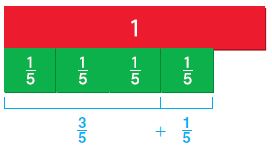
Use the model to find the sum \(\frac { 3 }{ 5 } \)+\(\frac { 1 }{ 5 } \). How many fifth-size pieces are shown? fifth-size pieces
Answer: 4/5
Explanation:
Given,
Adrian’s cat ate \(\frac { 3 }{ 5 } \) of a bag of cat treats in September and \(\frac { 1 }{ 5 } \) of the same bag of cat treats in October.
From the above figure, we can see that there are 4 fifth size pieces.
\(\frac { 3 }{ 5 } \)+\(\frac { 1 }{ 5 } \) = \(\frac { 4 }{ 5 } \).
Use the model to find the sum.
Question 2:
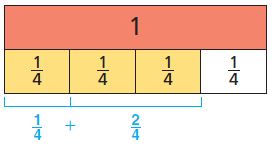
\(\frac { 1 }{ 4 } +\frac { 2 }{ 4 } =\frac { }{ } \)
Answer: 3/4
Explanation:
From the above figure, we can see that there are 3 one-fourth shaded parts.
So, \(\frac { 1 }{ 4 } +\frac { 2 }{ 4 } =\frac { 3 }{ 4 } \)
Question 3:
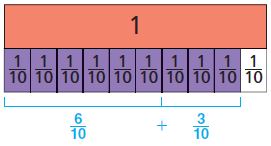
\(\frac { 6 }{ 10 } +\frac { 3 }{ 10 } =\frac { }{ } \)
Answer: 9/10
Explanation:
From the above figure, we can see that there are 9 one-tenth shaded parts.
So, \(\frac { 6 }{ 10 } +\frac { 3 }{ 10 } =\frac { 9 }{ 10 } \).
Find the sum. Use models to help.
Question 4:
\(\frac { 3 }{ 6 } +\frac { 3 }{ 6 } =\frac { }{ } \)
Answer: 6/6 = 1
Explanation:
3/6 and 3/6 has same numerators and same denominators so we have to add both the fractions.
\(\frac { 3 }{ 6 } +\frac { 3 }{ 6 } =\frac { 6 }{ 6 } \)
6/6 = 1
Question 5:
\(\frac { 1 }{ 3 } +\frac { 1 }{ 3 } =\frac { }{ } \)
Answer: 2/3
Explanation:
1/3 and 1/3 has same numerators and same denominators so we have to add both the fractions.
\(\frac { 1 }{ 3 } +\frac { 1 }{ 3 } =\frac { 2 }{ 3 } \)
Question 6:
\(\frac { 5 }{ 8 } +\frac { 2 }{ 8 } =\frac { }{ } \)
Answer: 7/8
Explanation:
Given the expressions 5/8 and 2/8.
The above fractions have the same denominators but the numerators are different.
So, \(\frac { 5 }{ 8 } +\frac { 2 }{ 8 } =\frac { 7 }{ 8 } \)
Find the sum. Use models or iTools to help.
Question 7:
\(\frac { 5 }{ 8 } +\frac { 2 }{ 8 } =\frac { }{ } \)
Answer: 7/8
Explanation:
Given the expressions 5/8 and 2/8.
The above fractions have the same denominators but the numerators are different.
So, \(\frac { 5 }{ 8 } +\frac { 2 }{ 8 } =\frac { 7 }{ 8 } \)
Question 8:
\(\frac { 2 }{ 5 } +\frac { 2 }{ 5 } =\frac { }{ } \)
Answer: 4/5
Explanation:
2/5 and 2/5 have the same numerators and same denominators so we have to add both the fractions.
\(\frac { 2 }{ 5 } +\frac { 2 }{ 5 } =\frac { 4 }{ 5 } \)
Question 9:
\(\frac { 4 }{ 6 } +\frac { 1 }{ 6 } =\frac { }{ } \)
Answer: 5/6
Explanation:
Given the fractions 4/6 and 1/6.
The above fractions have the same denominators but the numerators are different.
\(\frac { 4 }{ 6 } +\frac { 1 }{ 6 } =\frac { 5 }{ 6 } \)
Question 10:
Jason is making a fruit drink. He mixes \(\frac { 2 }{ 8 } \) quart of grape juice with \(\frac { 3 }{ 8 } \) quart of apple juice. Then he adds \(\frac { 1 }{ 8 } \) quart of lemonade. How much fruit drink does Jason make?
\(\frac { }{ } \) quart.
Answer: \(\frac { 6 }{ 8 } \) quart.
Explanation:
Given that,
Jason is making a fruit drink. He mixes \(\frac { 2 }{ 8 } \) quart of grape juice with \(\frac { 3 }{ 8 } \) quart of apple juice.
Then he adds \(\frac { 1 }{ 8 } \) quart of lemonade
Add all the three fractions to how much fruit drink Jason makes.
2/8 + 3/8 + 1/8 = \(\frac { 6 }{ 8 } \) quart.
Question 11:
A sum has five addends. Each addend is a unit fraction. The sum is 1. What are the addends?
Answer: 1/5
Explanation:
Given that,
A sum has five addends. Each addend is a unit fraction. The sum is 1.
1/5 + 1/5 + 1/5 + 1/5 + 1/5 = 5/5 = 1
Thus the addend is 1/5.
Question 12:
In a survey, \(\frac { 4 }{ 12 } \) of the students chose Friday and \(\frac { 5 }{ 12 } \) chose Saturday as their favorite day of the week. What fraction shows the students who chose Friday or Saturday as their favorite day? Shade the model to show your answer.

\(\frac { }{ } \)
Answer: \(\frac { 9 }{ 12 } \)
Explanation:
Given that,
In a survey, \(\frac { 4 }{ 12 } \) of the students chose Friday and \(\frac { 5 }{ 12 } \) chose Saturday as their favorite day of the week.
Add both the fractions 4/12 and 5/12
\(\frac { 4 }{ 12 } \) + \(\frac { 5 }{ 12 } \) = \(\frac { 9 }{ 12 } \)
Add and Subtract Parts of a Whole Page No – 400
Question 13:
Model Mathematics Jin is putting colored sand in a jar. She filled \(\frac {2 }{ 10} \) of the jar with blue sand and \(\frac { 4}{ 10} \) of the jar with pink sand. Describe one way to model the part of the jar filled with sand.
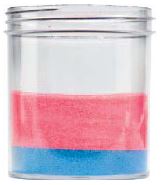
Answer: \(\frac { 4}{ 10} \)
Explanation:
the answer is 4/10 because 4/10 + 2/10= 6/10+ 4/10 = 10/10. a bit confusing
4 + 2 = 6 right the, 6 + 4 = 10 so 10/10.
Have you ever seen a stained glass window in a building or home? Artists have been designing stained glass windows for hundreds of years.

Help design the stained glass sail on the boat below.
Materials • color pencils
Look at the eight triangles in the sail. Use the guide below to color the triangles:

- \(\frac {2 }{8 } \) blue
- \(\frac {3 }{8 } \) red
- \(\frac { 2}{ 8} \) orange
- \(\frac {1 }{8 } \) yellow
Question 14:
Write an Equation Write an equation that shows the fraction of triangles that are red or blue.
Answer: \(\frac {3 }{8 } \) red
Question 15:
What color is the greatest part of the sail? Write a fraction for that color. How do you know that fraction is greater than the other fractions? Explain.
Answer: Red
Explanation:
Among all the colors Red color has the greatest part of the sail.
Add Fractions Using Models – Page No 401
Find the sum. Use fraction strips to help.
Question 1:

Answer: 3/6
Question 2:
\(\frac { 4 }{ 10 } +\frac { 5 }{ 10 } =\frac { }{ } \)
Answer: 9/10
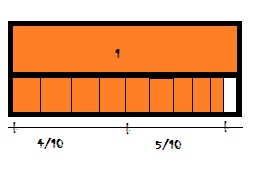
Question 3:
\(\frac { 1 }{ 3 } +\frac { 2 }{ 3 } =\frac { }{ } \)
Answer: 3/3
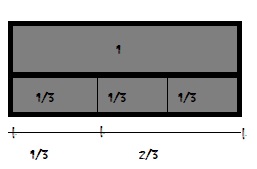
Question 4:
\(\frac { 2 }{ 4 } +\frac { 1 }{ 4 } =\frac { }{ } \)
Answer: 3/4

Question 5:
\(\frac { 2 }{ 12 } +\frac { 4 }{ 12 } =\frac { }{ } \)
Answer: 6/12
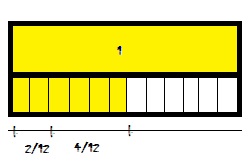
Question 6:
\(\frac { 1 }{ 6 } +\frac { 3 }{ 6 } =\frac { }{ } \)
Answer: 3/6
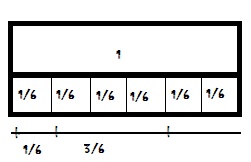
Question 7:
\(\frac { 3 }{ 12 } +\frac { 9 }{ 12 } =\frac { }{ } \)
Answer: 12/12

Question 8:
\(\frac { 3 }{ 8 } +\frac { 4 }{ 8 } =\frac { }{ } \)
Answer: 7/8

Question 9:
\(\frac { 3 }{ 4 } +\frac { 1 }{ 4 } =\frac { }{ } \)
Answer: 4/4

Question 9:
\(\frac { 1 }{ 5 } +\frac { 2 }{ 5 } =\frac { }{ } \)
Answer: 3/5
Explanation:
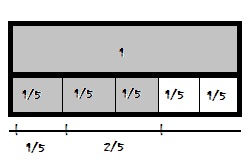
Question 10:
\(\frac { 6 }{ 10 } +\frac { 3 }{ 10 } =\frac { }{ } \)
Answer: 9/10
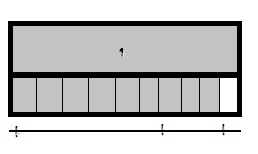
Question 11:
Lola walks \(\frac { 4 }{ 10} \) mile to her friend’s house. Then she walks \(\frac { 5 }{ 10 } \) mile to the store. How far does she walk in all?
Answer: \(\frac { 9 }{ 10 } \) mile
Explanation:
Given,
Lola walks \(\frac { 4 }{ 10} \) mile to her friend’s house.
Then she walks \(\frac { 5 }{ 10 } \) mile to the store.
\(\frac { 4 }{ 10} \) + \(\frac { 5 }{ 10 } \) = \(\frac { 9 }{ 10 } \)
Therefore she walked \(\frac { 9 }{ 10 } \) mile in all.
Question 12:
Evan eats \(\frac { 1 }{ 8 } \) of a pan of lasagna and his brother eats \(\frac { 2 }{ 8 } \) of it. What fraction of the pan of lasagna do they eat in all?
Answer: \(\frac { 3 }{ 8 } \) of the pan
Explanation:
Given,
Evan eats \(\frac { 1 }{ 8 } \) of a pan of lasagna and his brother eats \(\frac { 2 }{ 8 } \) of it.
\(\frac { 1 }{ 8 } \) + \(\frac { 2 }{ 8 } \)
= \(\frac { 3 }{ 8 } \)
Question 13:
Jacqueline buys \(\frac { 2 }{ 4 } \) yard of green ribbon and \(\frac { 1 }{ 4 } \) yard of pink ribbon. How many yards of ribbon does she buy in all?
Answer: \(\frac { 3 }{ 4 } \) yard
Explanation:
Given,
Jacqueline buys \(\frac { 2 }{ 4 } \) yard of green ribbon and \(\frac { 1 }{ 4 } \) yard of pink ribbon.
\(\frac { 2 }{ 4 } \) + \(\frac { 1 }{ 4 } \)
= \(\frac { 3 }{ 4 } \)
Thus Jacqueline bought \(\frac { 3 }{ 4 } \) yards of ribbon in all.
Question 14:
Shu mixes \(\frac { 2 }{ 3 } \) pound of peanuts with \(\frac { 1 }{ 3 } \) pound of almonds. How many pounds of nuts does Shu mix in all?
Answer: 3/3 pound
Explanation:
Given,
Shu mixes \(\frac { 2 }{ 3 } \) pound of peanuts with \(\frac { 1 }{ 3 } \) pound of almonds.
\(\frac { 2 }{ 3 } \) + \(\frac { 1 }{ 3 } \)
= \(\frac { 3 }{ 3 } \)
Therefore Shu mix \(\frac { 3 }{ 3 } \) pounds of nuts in all.
Add Fractions Using Models – Lesson Check – Page No 402
Question 1:
Mary Jane has \(\frac { 3 }{ 8 } \) of a medium pizza left. Hector has \(\frac { 2 }{ 8 } \) of another medium pizza left. How much pizza do they have altogether?
(a) \(\frac { 1 }{ 8 } \)
(b) \(\frac { 4 }{ 8 } \)
(c) \(\frac { 5 }{ 8 } \)
(d) \(\frac { 6 }{ 8 } \)
Answer: \(\frac { 5 }{ 8 } \)
Explanation:
Given,
Mary Jane has \(\frac { 3 }{ 8 } \) of a medium pizza left.
Hector has \(\frac { 2 }{ 8 } \) of another medium pizza left.
To find how much pizza do they have altogether we have to add both the fractions.
\(\frac { 3 }{ 8 } \) + \(\frac { 2 }{ 8 } \) = \(\frac { 5 }{ 8 } \)
Therefore Mary Jane and Hector has \(\frac { 5 }{ 8 } \) pizza altogether.
Thus the correct answer is option c.
Question 2:
Jeannie ate \(\frac { 1 }{ 4 } \) of an apple. Kelly ate \(\frac { 2 }{ 4 } \) of the apple. How much did they eat in all?
(a) \(\frac { 1 }{ 8 } \)
(b) \(\frac { 2 }{ 8 } \)
(c) \(\frac { 3 }{ 8 } \)
(d) \(\frac { 3 }{ 4 } \)
Answer: \(\frac { 3 }{ 4 } \)
Explanation:
Given,
Jeannie ate \(\frac { 1 }{ 4 } \) of an apple.
Kelly ate \(\frac { 2 }{ 4 } \) of the apple.
\(\frac { 1 }{ 4 } \) + \(\frac { 2 }{ 4 } \) = \(\frac { 3 }{ 4 } \)
Thus the correct answer is option d.
Question 3:
Karen is making 14 different kinds of greeting cards. She is making 12 of each kind. How many greeting cards is she making?
(a) 120
(b) 132
(c) 156
(d) 168
Answer: 168
Explanation:
Given,
Karen is making 14 different kinds of greeting cards.
She is making 12 of each kind.
To find how many greeting cards she is making we have to multiply 14 and 12.
14 × 12 = 168.
Thus the correct answer is option d.
Question 4:
Jefferson works part-time and earns $1,520 in four weeks. How much does he earn each week?
(a) $305
(b) $350
(c) $380
(d) $385
Answer: $380
Explanation:
Jefferson works part-time and earns $1,520 in four weeks.
1520 – 4 weeks
? – 1 week
1520/4 = $380
Thus the correct answer is option c.
Question 5:
By installing efficient water fixtures, the average American can reduce water use to about 45 gallons of water per day. Using such water fixtures, about how many gallons of water would the average American use in December?
(a) about 1,200 gallons
(b) about 1,500 gallons
(c) about 1,600 gallons
(d) about 2,000 gallons
Answer: about 1,500 gallons
Explanation:
Given,
By installing efficient water fixtures, the average American can reduce water use to about 45 gallons of water per day.
1 day – 45 gallons
31 days – ?
45 × 31 = 1395 gallons
The number near to 1395 is 1500 gallons.
Thus the correct answer is option b.
Question 6:
Collin is making a bulletin board and note center. He is using square cork tiles and square dry-erase tiles. One of every 3 squares will be a cork square. If he uses 12 squares for the center, how many will be cork squares?
(a) 3
(b) 4
(c) 6
(d) 8
Answer: 4
Explanation:
Given that,
Collin is making a bulletin board and note center.
He is using square cork tiles and square dry-erase tiles.
One of every 3 squares will be a cork square.
12/3 = 4
Thus the correct answer is option b.
Add Fractions Using Models – Lesson Check – Page No 405
Question 1:
Lisa needs 4/5 pound of shrimp to make shrimp salad. She has 1/5 pound of shrimp. How much more shrimp does Lisa need to make the salad?
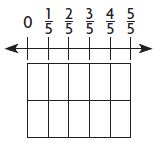
Subtract \(\frac { 4 }{ 5 } – \frac { 1 }{ 5 }\). Use the model to help.
Shade the model to show how much shrimp Lisa needs.
Then shade the model to show how much shrimp Lisa has.
Compare the difference between the two shaded rows.
\(\frac { 4 }{ 5 } – \frac { 1 }{ 5 } = \frac {■ }{ 5} \)
Lisa needs _____ pound more shrimp.
Answer: 3/5
Explanation:
Given that,
Lisa needs 4/5 pounds of shrimp to make shrimp salad. She has 1/5 pound of shrimp.
The denominators have the same numbers and numerators have different numbers.
4/5 – 3/5 = 1/5
Thus Lisa needs 1/5 pounds more shrimp.
Use the model to find the difference.
Question 2:
\(\frac { 3 }{ 6 } – \frac { 2 }{ 6 } = \frac {■ }{ 6} \)

Answer: 1/6
Explanation:
Given two fractions 3/6 and 2/6
Denominators are same but the numerators are different.
3/6 – 2/6 = 1/6
Question 3:
\(\frac { 8 }{ 10 } – \frac { 5 }{ 10 } = \frac {■ }{ 10} \)
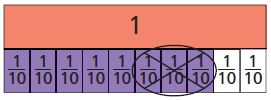
Answer: 3/10
Explanation:
Given two fractions 8/10 and 5/10
Denominators are the same but the numerators are different.
8/10 – 5/10 = 3/10
Subtract. Use models to help.
Question 4:
\(\frac { 5 }{ 8 } – \frac { 2 }{ 8 } = \frac { }{ } \)
Answer: 3/8
Explanation:
Given two fractions 5/8 and 2/8
Denominators are same but the numerators are different.
\(\frac { 5 }{ 8 } – \frac { 2 }{ 8 } = \frac { 3 }{ 8 } \)
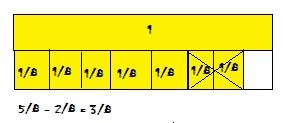
Question 5:
\(\frac { 7 }{ 12 } – \frac { 2 }{ 12 } = \frac { }{ } \)
Answer: 5/12
Explanation:
Given two fractions 7/12 and 2/12
Denominators are same but the numerators are different.
\(\frac { 7 }{ 12 } – \frac { 2 }{ 12 } = \frac { 5 }{ 12 } \)
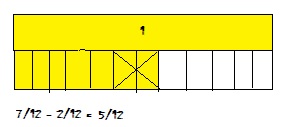
Question 6:
\(\frac { 3 }{4 } – \frac { 2 }{ 4 } = \frac { }{ } \)
Answer: 1/4
Explanation:
Given two fractions 3/4 and 2/4
Denominators are same but the numerators are different.
\(\frac { 3 }{4 } – \frac { 2 }{ 4 } = \frac { 1 }{ 4 } \)
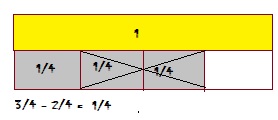
Question 7:
\(\frac { 2 }{ 3 } – \frac { 1 }{ 3 } = \frac { }{ } \)
Answer: 1/3
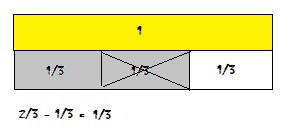
Question 8:
\(\frac { 7 }{ 8 } – \frac { 5 }{ 8 } = \frac { }{ } \)
Answer: 2/8
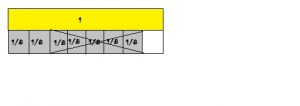
Question 9:
Explain how you could find the unknown addend in \(\frac { 2 }{ 6 } \) + _____ = 1 without using a model.
Answer: 4/6
Explanation:
1 can be written in the fraction form as 6/6
2/6 + x = 6/6
x = 6/6 – 2/6
x = 4/6
Add Fractions Using Models – Lesson Check – Page No 406
Question 10:
Mrs. Ruiz served a pie for dessert two nights in a row. The drawings below show the pie after her family ate dessert on each night. What fraction of the pie did they eat on the second night?
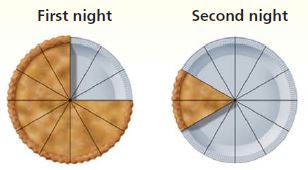
Answer: 10/12
a. What do you need to know?
Answer: We need to find the fraction of the pie did they eat on the second night.
b. How can you find the number of pieces eaten on the second night?
Answer: We can find the number of pieces eaten on the second night by dividing the number of eaten pieces by the total number of pieces.
c. Explain the steps you used to solve the problem.
Complete the sentences.
After the first night, _______ pieces were left.
After the second night, _______ pieces were left.
So, _______ of the pie was eaten on the second night.
Answer:
After the first night, 9 pieces were left.
After the second night, 2 pieces were left.
So, 10 of the pie was eaten on the second night.
Question 11:
Make Connection Between Models Judi ate \(\frac { 7}{8} \) of a small pizza and Jack ate \(\frac { 2}{ 8 } \) of a second small pizza. How much more of a pizza did Judi eat?
\(\frac { }{ } \)
Answer: \(\frac {5}{8} \)
Explanation:
Given,
Make Connection Between Models Judi ate \(\frac { 7}{8} \) of a small pizza and Jack ate \(\frac { 2}{ 8 } \) of a second small pizza.
\(\frac {7}{8} \) – \(\frac {2}{8} \) = \(\frac {5}{8} \)
Therefore Judi eat \(\frac {5}{8} \) of a pizza.
Question 12:
Keiko sewed \(\frac { 3}{4} \) yard of lace on her backpack. Pam sewed \(\frac { 1}{4} \) yard of lace on her backpack. Shade the model to show how much more lace Keiko sewed on her backpack than Pam

\(\frac { ■ }{ ■ } \)
Answer: 2/4
Explanation:
Given,
Keiko sewed \(\frac { 3}{4} \) yard of lace on her backpack. Pam sewed \(\frac { 1}{4} \) yard of lace on her backpack.
\(\frac {3}{4} \) – \(\frac {1}{4} \) = \(\frac {2}{4} \)
Subtract Fractions Using Models – Page No 407
Subtract. Use fraction strips to help.
Question 1:
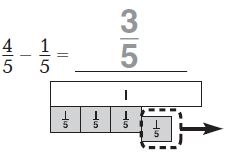
Answer: 3/5
Explanation:
Given the fraction, 4/5 and 1/5
The denominators of both the fractions are the same so subtract the numerators.
4/5 – 1/5 = 3/5
Question 2:
\(\frac { 3}{ 4 } – \frac { 1}{ 4 } = \frac { —}{ — } \)
Answer: 2/4
Explanation:
Given the fractions \(\frac { 3}{ 4 } \) and [/latex] \frac { 1}{ 4 } [/latex]
The denominators of both the fractions are the same so subtract the numerators.
\(\frac { 3}{ 4 } – \frac { 1}{ 4 } = \frac { 2 }{ 4 } \)
Question 3:
\(\frac { 5}{ 6 } – \frac { 1}{ 6 } = \frac { —}{ — } \)
Answer: 4/6
Explanation:
Given the fractions \(\frac { 5 }{ 6 } \) and [/latex] \frac { 1 }{ 6 } [/latex]
The denominators of both the fractions are the same so subtract the numerators.
\(\frac { 5}{ 6 } – \frac { 1}{ 6 } = \frac { 4 }{ 6 } \)
Question 4:
\(\frac { 7}{ 8 } – \frac { 1}{ 8 } = \frac { —}{ — } \)
Answer: 6/8
Explanation:
Given the fractions \(\frac { 7 }{ 8 } \) and [/latex] \frac { 1 }{ 8 } [/latex]
The denominators of both the fractions are the same so subtract the numerators.
\(\frac { 7}{ 8 } – \frac { 1}{ 8 } = \frac { 6 }{ 8 } \)
Question 5:
\(\frac { 1}{ 3 } – \frac { 2}{ 3 } = \frac { —}{ — } \)
Answer: 1/3
Explanation:
Given the fractions \(\frac { 1 }{ 3 } \) and [/latex] \frac { 2 }{ 3 } [/latex]
The denominators of both the fractions are the same so subtract the numerators.
\(\frac { 1}{ 3 } – \frac { 2}{ 3 } = \frac { 1}{ 3 } \)
Question 6:
\(\frac { 8}{ 10 } – \frac { 2}{ 10 } = \frac { —}{ — } \)
Answer: 6/10
Explanation:
Given the fractions \(\frac { 8 }{ 10 } \) and [/latex] \frac { 2 }{ 10 } [/latex]
The denominators of both the fractions are the same so subtract the numerators.
\(\frac { 8}{ 10 } – \frac { 2}{ 10 } = \frac { 6 }{ 10 } \)
Question 7:
\(\frac { 3}{ 4 } – \frac { 1}{ 4 } = \frac { —}{ — } \)
Answer: 2/4
Explanation:
Given the fractions \(\frac { 3 }{ 4 } \) and [/latex] \frac { 1 }{ 4 } [/latex]
The denominators of both the fractions are the same so subtract the numerators.
\(\frac { 3}{ 4 } – \frac { 1}{ 4 } = \frac { 2 }{ 4 } \)
Question 8:
\(\frac { 7}{ 6 } – \frac {5}{ 6 } = \frac { —}{ — } \)
Answer: 2/6
Explanation:
Given the fractions \(\frac { 7 }{ 6 } \) and [/latex] \frac { 5 }{ 6 } [/latex]
The denominators of both the fractions are the same so subtract the numerators.
\(\frac { 7}{ 6 } – \frac {5}{ 6 } = \frac { 2 }{ 6 } \)
Problem Solving
Use the table for 9 and 10.
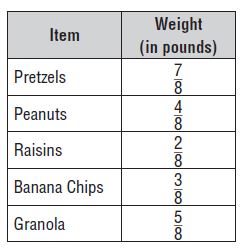
Question 9:
Ena is making trail mix. She buys the items shown in the table. How many more pounds of pretzels than raisins does she buy?
\(\frac { —}{ — } \)
Answer: 5/8 pound
Explanation:
Given that,
Ena is making trail mix.
pretzels = 7/8
Raisins = 2/8
To find the number of more pounds of pretzels than raisins she buy
we have to subtract both the fractions.
7/8 – 2/8 = 5/8
Question 10:
How many more pounds of granola than banana chips does she buy?
\(\frac { —}{ — } \)
Answer: 2/8 pound
Explanation:
Granola = 5/8
Banana Chips = 3/8
To find How many more pounds of granola than banana chips does she buy we have to subtract both the fractions.
5/8 – 3/8 = 2/8 pounds
Subtract Fractions Using Models – Page No 408
Question 1:
Lee reads for \(\frac { 3}{ 4} \) hour in the morning and \(\frac {2}{ 4} \) hour in the afternoon. How much longer does Lee read in the morning than in the afternoon?
(a) 5 hours
(b) \(\frac { 5}{ 4} \)
(c) \(\frac { 4}{ 4} \)
(d) \(\frac { 1}{ 4} \)
Answer: \(\frac { 1}{ 4} \)
Explanation:
Given,
Lee reads for \(\frac { 3}{ 4} \) hour in the morning and \(\frac {2}{ 4} \) hour in the afternoon.
\(\frac { 3}{ 4} \) – \(\frac {2}{ 4} \) = \(\frac { 1}{ 4} \)
Lee read \(\frac { 1}{ 4} \) hour in the morning than in the afternoon.
Thus the correct answer is option d.
Question 2:
Which equation does the model below represent?

(a) \(\frac { 3}{ 6} – \frac { 2}{ 6} = \frac { 1}{ 6} \)
(b) \(\frac { 2}{ 6} – \frac { 1}{ 6} = \frac { 1}{ 6} \)
(c) \(\frac { 5}{ 6} – \frac { 3}{ 6} = \frac { 2}{ 6} \)
(d) 1 – \( \frac { 3}{ 6} = \frac {3}{ 6} \)
Answer: \(\frac { 5}{ 6} – \frac { 3}{ 6} = \frac { 2}{ 6} \)
Explanation:
From the above figure we can say that \(\frac { 5}{ 6} – \frac { 3}{ 6} = \frac { 2}{ 6} \)
Thus the correct answer is option c.
Question 3:
A city received 2 inches of rain each day for 3 days. The meteorologist said that if the rain had been snow, each inch of rain would have been 10 inches of snow. How much snow would that city have received in the 3 days?
(a) 20 inches
(b) 30 inches
(c) 50 inches
(d) 60 inches
Answer: 60 inches
Explanation:
Given,
A city received 2 inches of rain each day for 3 days.
2 × 3 inches = 6 inches
The meteorologist said that if the rain had been snow, each inch of rain would have been 10 inches of snow.
6 × 10 inches = 60 inches
Therefore the city has received 60 inches of snow in 3 days.
Thus the correct answer is option d.
Question 4:
At a party there were four large submarine sandwiches, all the same size. During the party, \(\frac { 2}{ 3} \) of the chicken sandwich, \(\frac { 3}{ 4} \) of the tuna sandwich, \(\frac { 7}{ 12} \) of the roast beef sandwich, and \(\frac { 5}{ 6} \) of the veggie sandwich were eaten. Which sandwich had the least amount left?
(a) chicken
(b) tuna
(c) roast beef
(d) veggie
Answer: veggie
Explanation:
Given,
At a party there were four large submarine sandwiches, all the same size. During the party, \(\frac { 2}{ 3} \) of the chicken sandwich, \(\frac { 3}{ 4} \) of the tuna sandwich, \(\frac { 7}{ 12} \) of the roast beef sandwich, and \(\frac { 5}{ 6} \) of the veggie sandwich were eaten.
Compare the fractions \(\frac { 2}{ 3} \), \(\frac { 3}{ 4} \) , \(\frac { 7}{ 12} \) and \(\frac { 5}{ 6} \).
Among all the fractions veggie has the least fraction.
Thus the correct answer is option d.
Question 5:
Deena uses \(\frac { 3}{ 8} \) cup milk and \(\frac { 2}{ 8} \) cup oil in a recipe. How much liquid does she use in all?
(a) \(\frac {1}{ 8} \) cup
(b) \(\frac {5}{ 8} \) cup
(c) \(\frac {6}{ 8} \) cup
(d) 5 cups
Answer: \(\frac {5}{ 8} \) cup
Explanation:
Given,
Deena uses \(\frac { 3}{ 8} \) cup milk and \(\frac { 2}{ 8} \) cup oil in a recipe.
\(\frac { 3}{ 8} \) + \(\frac { 2}{ 8} \) = \(\frac {5}{ 8} \) cup
Therefore she used \(\frac {5}{ 8} \) cup of milk in all.
Thus the correct answer is option b.
Question 6:
In the car lot, \(\frac { 4}{ 12} \) of the cars are white and \(\frac { 3}{ 12} \) of the cars are blue. What fraction of the cars in the lot are either white or blue?
(a) \(\frac { 1}{ 12} \)
(b) \(\frac { 7}{ 24} \)
(c) \(\frac { 7}{ 12} \)
(d) 7
Answer: \(\frac { 7}{ 12} \)
Explanation:
Given,
In the car lot, \(\frac { 4}{ 12} \) of the cars are white and \(\frac { 3}{ 12} \) of the cars are blue.
\(\frac { 4}{ 12} \) + \(\frac { 3}{ 12} \) = \(\frac { 7}{ 12} \)
Thus the correct answer is option c.
Subtract Fractions Using Models – Page No 411
Question 1:
9 twelfth-size parts − 5 twelfth-size parts =
\(\frac { —}{ — } \)
Answer: 4/12
Explanation:
9 twelfth-size parts − 5 twelfth-size parts
9 × \(\frac { 1 }{ 12 } \) = \(\frac { 9 }{ 12 } \)
5 × \(\frac { 1 }{ 12 } \) = \(\frac { 5 }{ 12 } \)
The denominators of both the fractions are the same so subtract the numerators.
\(\frac { 9 }{ 12 } \) – \(\frac { 5 }{ 12 } \) = \(\frac { 4 }{ 12 } \)
Question 2:
\(\frac { 3}{ 12} + \frac {8}{ 12 } = \frac { —}{ — } \)
Answer: 11/12
Explanation:
Given the fractions,
\(\frac { 3 }{ 12 } \) and \(\frac { 8 }{ 12 } \)
Add both the fractions
The denominators of both the fractions are the same so add the numerators.
\(\frac { 3}{ 12} + \frac {8}{ 12 } = \frac { 11 }{ 12 } \)
Question 3:
\(\frac { 1}{ 3 } + \frac {1}{ 3 } = \frac { —}{ — } \)
Answer: 2/3
Explanation:
Given the fractions,
\(\frac { 1 }{ 3 } \) and \(\frac { 1 }{ 3 } \)
Add both the fractions
The denominators of both the fractions are the same so add the numerators.
\(\frac { 1}{ 3 } + \frac {1}{ 3 } = \frac { 2 }{ 3 } \)
Question 4:
\(\frac { 3}{ 4 } – \frac {1}{ 4 } = \frac { —}{ — } \)
Answer: 2/4
Explanation:
Given the fractions,
\(\frac { 3 }{ 4 } \) and \(\frac { 1 }{ 4 } \)
Subtract both the fractions
The denominators of both the fractions are the same so Subtract the numerators.
\(\frac { 3}{ 4 } – \frac {1}{ 4 } = \frac { 2 }{ 4 } \)
Question 5:
\(\frac { 2}{ 6 } + \frac {2}{ 6 } = \frac { —}{ — } \)
Answer: 4/6
Explanation:
Given the fractions,
\(\frac { 2 }{ 6 } \) and \(\frac { 2 }{ 6 } \)
Add both the fractions
The denominators of both the fractions are the same so add the numerators.
\(\frac { 2}{ 6 } + \frac {2}{ 6 } = \frac { 4 }{ 6 } \)
Question 6:
\(\frac { 3}{ 8 } – \frac {1}{ 8 } = \frac { —}{ — } \)
Answer: 2/8
Explanation:
Given the fractions,
\(\frac { 3 }{ 8 } \) and \(\frac { 1 }{ 8 } \)
Subtract both the fractions
The denominators of both the fractions are the same so Subtract the numerators.
\(\frac { 3}{ 8 } – \frac {1}{ 8 } = \frac { 2 }{ 8 } \)
Question 7:
\(\frac { 6}{ 10 } – \frac {2}{ 10 } = \frac { —}{ — } \)
Answer: 4/10
Explanation:
Given the fractions,
\(\frac { 6 }{ 10 } \) and \(\frac { 2 }{ 10 } \)
Subtract both the fractions
The denominators of both the fractions are the same so Subtract the numerators.
\(\frac { 6}{ 10 } – \frac {2}{ 10 } = \frac { 4 }{ 10 } \)
Question 8:
\(\frac { 1}{ 2 } – \frac {1}{2 } = \frac { —}{ — } \)
Answer: 0
Explanation:
Given the fractions,
\(\frac { 1 }{ 2 } \) and \(\frac { 1 }{ 2 } \)
Subtract both the fractions
The denominators of both the fractions are the same so Subtract the numerators.
\(\frac { 1}{ 2 } – \frac {1}{2 } \) = 0
Question 9:
\(\frac {5}{ 6 } – \frac {4}{ 6 } = \frac { —}{ — } \)
Answer: 1/6
Explanation:
Given the fractions,
\(\frac { 5 }{ 6 } \) and \(\frac { 4 }{ 6 } \)
Subtract both the fractions
The denominators of both the fractions are the same so Subtract the numerators.
\(\frac {5}{ 6 } – \frac {4}{ 6 } = \frac { 1 }{ 6 } \)
Question 10:
\(\frac { 4}{ 5 } – \frac {2}{ 5 } = \frac { —}{ — } \)
Answer: 2/5
Explanation:
Given the fractions,
\(\frac { 4 }{ 5 } \) and \(\frac { 2 }{ 5 } \)
Subtract both the fractions
The denominators of both the fractions are the same so Subtract the numerators.
\(\frac { 4}{ 5 } – \frac {2}{ 5 } = \frac { 2 }{ 5 } \)
Question 11:
\(\frac { 1}{ 4 } + \frac {1}{ 4 } = \frac { —}{ — } \)
Answer: 2/4
Explanation:
Given the fractions,
\(\frac { 1 }{ 4 } \) and \(\frac { 1 }{ 4 } \)
Add both the fractions
The denominators of both the fractions are the same so add the numerators.
\(\frac { 1}{ 4 } + \frac {1}{ 4 } = \frac { 2 }{ 4 } \)
Question 12:
\(\frac { 9}{ 10 } – \frac {5}{ 10 } = \frac { —}{ — } \)
Answer: 4/10
Explanation:
Given the fractions,
\(\frac { 9 }{ 10 } \) and \(\frac { 5 }{ 10 } \)
Subtract both the fractions
The denominators of both the fractions are the same so Subtract the numerators.
\(\frac { 9}{ 10 } – \frac {5}{ 10 } = \frac { 4 }{ 10 } \)
Question 13:
\(\frac { 1}{ 12 } + \frac {7}{ 12 } = \frac { —}{ — } \)
Answer: 8/12
Explanation:
Given the fractions,
\(\frac { 1 }{ 12 } \) and \(\frac { 7 }{ 12 } \)
Add both the fractions
The denominators of both the fractions are the same so add the numerators.
\(\frac { 1}{ 12 } + \frac {7}{ 12 } = \frac { 8 }{ 12 } \)
Question 14:
Christopher mixes \(\frac { 3}{ 8} \) gallon of red paint with \(\frac { 5}{ 8} \) gallon of blue paint to make purple paint. He uses \(\frac { 2}{8} \) gallon of the purple paint. How much purple paint is left?
\(\frac { —}{ — } \) gallon
Answer: \(\frac { 6 }{ 8 } \) gallon
Explanation:
Given,
Christopher mixes \(\frac { 3}{ 8} \) gallon of red paint with \(\frac { 5}{ 8} \) gallon of blue paint to make purple paint.
He uses \(\frac { 2}{8} \) gallon of the purple paint.
\(\frac { 3}{ 8} \) + \(\frac { 5}{ 8} \) = \(\frac { 8 }{ 8 } \)
\(\frac { 8 }{ 8 } \) – \(\frac { 2 }{ 8 } \) = \(\frac { 6 }{ 8 } \) gallon
Question 15:
A city worker is painting a stripe down the center of Main Street. Main Street is \(\frac { 8}{ 10} \) mile long. The worker painted \(\frac { 4}{ 10} \) mile of the street. Explain how to find what part of a mile is left to paint.
\(\frac { —}{ — } \) mile
Answer: \(\frac { 4 }{ 10 } \) mile
Explanation:
Given,
A city worker is painting a stripe down the center of Main Street.
Main Street is \(\frac { 8}{ 10} \) mile long.
The worker painted \(\frac { 4}{ 10} \) mile of the street.
\(\frac { 8 }{ 10 } \) – \(\frac { 4 }{ 10 } \) = \(\frac { 4 }{ 10 } \) mile
Question 16:
Sense or Nonsense? Brian says that when you add or subtract fractions with the same denominator, you can add or subtract the numerators and keep the same denominator. Is Brian correct? Explain.
Answer: correct
Explanation:
The statement of Brian is correct because when you add or subtract fractions with the same denominator, you can add or subtract the numerators and keep the same denominator.
Question 17:
The length of a rope was \(\frac { 6}{8} \) yard. Jeff cut the rope into 3 pieces. Each piece is a different length measured in eighths of a yard. What is the length of each piece of rope?
Answer: \(\frac { 2}{8} \)
Explanation:
Given,
The length of a rope was \(\frac { 6}{8} \) yard.
Jeff cut the rope into 3 pieces. Each piece is a different length measured in eighths of a yard.
Divide \(\frac { 6}{8} \) into 3 pieces.
\(\frac { 6}{8} \) ÷ 3 = \(\frac { 2}{8} \)
Question 18:
For 18a–18d, choose Yes or No to show if the sum or difference is correct.
a. \(\frac { 3}{ 5 } – \frac {1}{ 5 } = \frac {4 }{5 } \)
(i) yes
(ii) no
Answer: no
Explanation:
The denominators of both the fractions are the same so Subtract the numerators.
\(\frac { 3}{ 5 } – \frac {1}{ 5 } = \frac {2 }{5 } \)
Thus the above statement is not correct.
b. \(\frac { 1}{ 4 } – \frac {2}{4 } = \frac {3 }{8 } \)
(i) yes
(ii) no
Answer: no
Explanation:
The denominators of both the fractions are the same so Subtract the numerators.
\(\frac { 1}{ 4 } – \frac {2}{4 } = \frac {1 }{4 } \)
Thus the above statement is not correct.
c. \(\frac { 5}{ 8} – \frac {4}{ 8 } = \frac {1 }{8 } \)
(i) yes
(ii) no
Answer: yes
Explanation:
The denominators of both the fractions are the same so Subtract the numerators.
\(\frac { 5}{ 8} – \frac {4}{ 8 } = \frac {1 }{8 } \)
Thus the above statement is correct.
d. \(\frac { 4}{ 9 } – \frac {2}{ 9 } = \frac {6 }{9 } \)
(i) yes
(ii) no
Answer: no
Explanation:
The denominators of both the fractions are the same so Subtract the numerators.
d. \(\frac { 4}{ 9 } – \frac {2}{ 9 } = \frac {2 }{9 } \)
Thus the above statement is not correct.
Sense or Nonsense? – Page No. 412
Question 19.
Harry says that \(\frac{1}{4}\) + \(\frac{1}{8}\) = \(\frac{2}{8}\). Jane says \(\frac{1}{4}\) + \(\frac{1}{8}\) = \(\frac{3}{8}\).
Whose answer makes sense? Whose answer is nonsense? Explain your reasoning. Draw a model to help.

Type below:
___________
Answer: Jane’s Answer Makes Sense. Because the numerators are the same but the denominators are different. So, in order to add the fractions first, they have to make the denominators equal.
1/4 + 1/8 = 2/8 + 1/8 = 3/8
Add and Subtract Fractions – Page No. 413
Find the sum or difference.
Question 1.
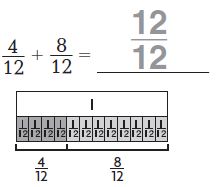
Answer: 12/12
Explanation:
The denominators of both the fractions are the same so add the numerators.
\(\frac{4}{12}\) + \(\frac{8}{12}\)
= \(\frac{12}{12}\)
Question 2.
\(\frac{3}{6}-\frac{1}{6}\) = \(\frac{□}{□}\)
Answer: 2/6
Explanation:
The denominators of both the fractions are the same so Subtract the numerators.
\(\frac{3}{6}\) – \(\frac{1}{6}\)
= \(\frac{2}{6}\)
Question 3.
\(\frac{4}{5}-\frac{3}{5}\) = \(\frac{□}{□}\)
Answer: 1/5
Explanation:
The denominators of both the fractions are the same so Subtract the numerators.
\(\frac{4}{5}\) – \(\frac{3}{5}\)
= \(\frac{1}{5}\)
Question 4.
\(\frac{6}{10}+\frac{3}{10}\) = \(\frac{□}{□}\)
Answer: 9/10
Explanation:
The denominators of both the fractions are the same so add the numerators.
\(\frac{6}{10}+\frac{3}{10}\) = \(\frac{9}{10}\)
Question 5.
1 – \(\frac{3}{8}\) = \(\frac{□}{□}\)
Answer: 5/8
Explanation:
The denominators of both the fractions are the same so Subtract the numerators.
1 – \(\frac{3}{8}\)
= \(\frac{8}{8}\) – \(\frac{3}{8}\)
= \(\frac{5}{8}\)
Question 6.
\(\frac{1}{4}+\frac{2}{4}\) = \(\frac{□}{□}\)
Answer: 3/4
Explanation:
The denominators of both the fractions are the same so add the numerators.
\(\frac{1}{4}+\frac{2}{4}\) = \(\frac{3}{4}\)
Question 7.
\(\frac{9}{12}-\frac{5}{12}\) = \(\frac{□}{□}\)
Answer: 4/12
Explanation:
The denominators of both the fractions are the same so Subtract the numerators.
\(\frac{9}{12}-\frac{5}{12}\) = \(\frac{4}{12}\)
Question 8.
\(\frac{5}{6}-\frac{2}{6}\) = \(\frac{□}{□}\)
Answer: 3/6
Explanation:
The denominators of both the fractions are the same so Subtract the numerators.
\(\frac{5}{6}-\frac{2}{6}\) = \(\frac{3}{6}\)
Question 9.
\(\frac{2}{3}+\frac{1}{3}\) = \(\frac{□}{□}\)
Answer: 3/3 = 1
Explanation:
The denominators of both the fractions are the same so add the numerators.
\(\frac{2}{3}+\frac{1}{3}\) = \(\frac{3}{3}\) = 1
Problem Solving
Use the table for 10 and 11.
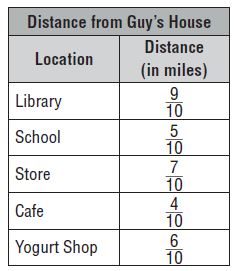
Question 10.
Guy finds how far his house is from several locations and makes the table shown. How much farther away from Guy’s house is the library than the cafe?
\(\frac{□}{□}\)
Answer: \(\frac{5}{10}\) mile
Explanation:
The distance from Guy’s house to the library is \(\frac{9}{10}\) mile
The distance from Guy’s house to the cafe is \(\frac{4}{10}\) mile
To find how much farther away from Guy’s house is the library than the cafe subtract both the fractions.
\(\frac{9}{10}\) – \(\frac{4}{10}\) = \(\frac{5}{10}\) mile
Question 11.
If Guy walks from his house to school and back, how far does he walk?
\(\frac{□}{□}\)
Answer: 10/10 mile
Explanation:
The distance from Guy’s house to school = \(\frac{5}{10}\) mile
From school to house \(\frac{5}{10}\) mile
\(\frac{5}{10}\) + \(\frac{5}{10}\) = \(\frac{10}{10}\) mile
Add and Subtract Fractions – Lesson Check – Page No. 414
Question 1.
Mr. Angulo buys \(\frac{5}{8}\) pound of red grapes and \(\frac{3}{8}\)pound of green grapes. How many pounds of grapes did Mr. Angulo buy in all?
Options:
a. \(\frac{1}{8}\) pound
b. \(\frac{2}{8}\) pound
c. 1 pound
d. 2 pounds
Answer: 1 pound
Explanation:
Given that,
Mr. Angulo buys \(\frac{5}{8}\) pound of red grapes and \(\frac{3}{8}\)pound of green grapes.
\(\frac{5}{8}\) + \(\frac{3}{8}\)
= \(\frac{8}{8}\)
= 1
Thus the correct answer is option c.
Question 2.
Which equation does the model below represent?
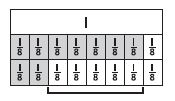
Options:
a. \(\frac{7}{8}\) + \(\frac{2}{8}\) = \(\frac{9}{8}\)
b. \(\frac{5}{8}\) – \(\frac{2}{8}\) = \(\frac{3}{8}\)
c. \(\frac{8}{8}\) – \(\frac{5}{8}\) = \(\frac{3}{8}\)
d. \(\frac{7}{8}\) – \(\frac{2}{8}\) = \(\frac{5}{8}\)
Answer: \(\frac{7}{8}\) – \(\frac{2}{8}\) = \(\frac{5}{8}\)
Explanation:
By seeing the above figure we can say that, the equation of the model is
\(\frac{7}{8}\) – \(\frac{2}{8}\) = \(\frac{5}{8}\)
Thus the correct answer is option d.
Spiral Review
Question 3.
There are 6 muffins in a package. How many packages will be needed to feed 48 people if each person has 2 muffins?
Options:
a. 4
b. 8
c. 16
d. 24
Answer: 16
Explanation:
There are 6 muffins in a package.
Number of people = 48
48/6 = 8
Also given that each person gets 2 muffins.
8 × 2 = 16
Thus the correct answer is option c.
Question 4.
Camp Oaks gets 32 boxes of orange juice and 56 boxes of apple juice. Each shelf in the cupboard can hold 8 boxes of juice. What is the least number of shelves
needed for all the juice boxes?
Options:
a. 4
b. 7
c. 11
d. 88
Answer: 11
Explanation:
Given,
Camp Oaks gets 32 boxes of orange juice and 56 boxes of apple juice.
Each shelf in the cupboard can hold 8 boxes of juice.
First, add the boxes of orange juice and apple juice.
32 + 56 = 88 boxes of juice
Now divide 88 by 8
88/8 = 11
Thus the correct answer is option c.
Question 5.
A machine makes 18 parts each hour. If the machine operates 24 hours a day, how many parts can it make in one day
Options:
a. 302
b. 332
c. 362
d. 432
Answer: 432
Explanation:
Given,
A machine makes 18 parts each hour.
Multiply the number of parts with the number of hours.
18 × 24 = 432 parts in a day.
Thus the correct answer is option d.
Question 6.
Which equation does the model below represent?

Options:
a. \(\frac{5}{6}\) – \(\frac{4}{6}\) = \(\frac{1}{6}\)
b. \(\frac{4}{5}\) – \(\frac{1}{5}\) = \(\frac{3}{5}\)
c. \(\frac{5}{5}\) – \(\frac{4}{5}\) = \(\frac{1}{5}\)
d. \(\frac{6}{6}\) – \(\frac{4}{6}\) = \(\frac{2}{6}\)
Answer: \(\frac{5}{6}\) – \(\frac{4}{6}\) = \(\frac{1}{6}\)
Explanation:
By observing the figure we can say that the equation is \(\frac{5}{6}\) – \(\frac{4}{6}\) = \(\frac{1}{6}\).
Thus the correct answer is option a.
Add and Subtract Fractions – Page No. 415
Choose the best term from the box.
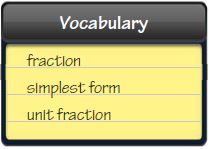
Question 1.
A ___________ always has a numerator of 1.
________________
Answer: unit fraction
Explanation:
A unit fraction is a rational number written as a fraction where the numerator is one and the denominator is a positive integer.
Write the fraction as a sum of unit fractions.
Question 2.
Type below:
____________
Answer: 1/3 + 1/3 + 1/3
Explanation:
A unit fraction is a rational number written as a fraction where the numerator is one and the denominator is a positive integer. The unit fraction of 3/3 is 1/3 + 1/3 + 1/3
Question 3.
Type below:
____________
Answer: 1/12 + 1/12 + 1/12 + 1/12
A unit fraction is a rational number written as a fraction where the numerator is one and the denominator is a positive integer. The unit fraction of 4/12 is 1/12 + 1/12 + 1/12 + 1/12.
Use the model to write an equation.
Question 4.

Type below:
_________
Answer: 1/5
Explanation:
By using the above model we can write the equation
3/5 – 2/5 = 1/5
Question 5.

Type below:
_________
Answer: 4/6
Explanation:
By using the above model we can write the equation
5/6 – 1/6 = 4/6
Use the model to solve the equation.
Question 6.
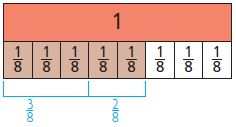
\(\frac{3}{8}+\frac{2}{8}\) = \(\frac{□}{□}\)
Answer: 5/8
Explanation:
The denominators of both the fractions are the same so add the numerators.
\(\frac{3}{8}+\frac{2}{8}\) = \(\frac{5}8}\)
Question 7.
\(\frac{4}{10}+\frac{5}{10}\) = \(\frac{□}{□}\)
Answer: 9/10
Explanation:
The denominators of both the fractions are the same so add the numerators.
\(\frac{4}{10}+\frac{5}{10}\) = \(\frac{9}{10}\)
Find the sum or difference.
Question 8.
\(\frac{9}{12}-\frac{7}{12}\) = \(\frac{□}{□}\)
Answer: 2/12
Explanation:
The denominators of both the fractions are the same so subtract the numerators.
\(\frac{9}{12}-\frac{7}{12}\) = \(\frac{2}{12}\)
Question 9.
\(\frac{2}{3}+\frac{1}{3}\) = \(\frac{□}{□}\)
Answer: 3/3
Explanation:
The denominators of both the fractions are the same so add the numerators.
\(\frac{2}{3}+\frac{1}{3}\) = \(\frac{3}{3}\)
Question 10.
\(\frac{1}{5}+\frac{3}{5}\) = \(\frac{□}{□}\)
Answer: 4/5
Explanation:
The denominators of both the fractions are the same so add the numerators.
\(\frac{1}{5}+\frac{3}{5}\) = \(\frac{4}{5}\)
Question 11.
\(\frac{2}{6}+\frac{2}{6}\) = \(\frac{□}{□}\)
Answer: 4/6
Explanation:
The denominators of both the fractions are the same so add the numerators.
\(\frac{2}{6}+\frac{2}{6}\) = \(\frac{4}{6}\)
Question 12.
\(\frac{4}{4}-\frac{2}{4}\) = \(\frac{□}{□}\)
Answer: 2/4
Explanation:
The denominators of both the fractions are the same so subtract the numerators.
\(\frac{4}{4}-\frac{2}{4}\) = \(\frac{2}{4}\)
Question 13.
\(\frac{7}{8}-\frac{4}{8}\) = \(\frac{□}{□}\)
Answer: 3/8
Explanation:
The denominators of both the fractions are the same so subtract the numerators.
\(\frac{7}{8}-\frac{4}{8}\) = \(\frac{3}{8}\)
Add and Subtract Fractions – Page No. 416
Question 14.
Tyrone mixed \(\frac{7}{12}\) quart of red paint with \(\frac{1}{12}\) quart of yellow paint. How much paint does Tyrone have in the mixture?
\(\frac{□}{□}\) quart
Answer: 8/12 quart
Explanation:
Given that,
Tyrone mixed \(\frac{7}{12}\) quart of red paint with \(\frac{1}{12}\) quart of yellow paint.
Add both the fraction of paints.
\(\frac{7}{12}\) + \(\frac{1}{12}\) = \(\frac{8}{12}\) quart
Therefore Tyrone has \(\frac{8}{12}\) quart in the mixture.
Question 15.
Jorge lives \(\frac{6}{8}\) mile from school and \(\frac{2}{8}\) mile from a ballpark. How much farther does Jorge live from school than from the ballpark?
\(\frac{□}{□}\) mile
Answer: 4/8 mile
Explanation:
Given,
Jorge lives \(\frac{6}{8}\) mile from school and \(\frac{2}{8}\) mile from a ballpark.
Subtract both the fractions.
\(\frac{6}{8}\) – \(\frac{2}{8}\) = \(\frac{4}{8}\)
Therefore Jorge live \(\frac{4}{8}\) mile from school than from the ballpark.
Question 16.
Su Ling started an art project with 1 yard of felt. She used \(\frac{2}{6}\) yard on Tuesday and \(\frac{3}{6}\) yard on Wednesday. How much felt does Su Ling have left?
\(\frac{□}{□}\) yard
Answer: 1/6 yard
Explanation:
Given,
Su Ling started an art project with 1 yard of felt.
She used \(\frac{2}{6}\) yard on Tuesday and \(\frac{3}{6}\) yard on Wednesday.
\(\frac{3}{6}\) – \(\frac{2}{6}\) = \(\frac{1}{6}\) yard
Therefore, Su Ling \(\frac{1}{6}\) yard left.
Question 17.
Eloise hung artwork on \(\frac{2}{5}\) of a bulletin board. She hung math papers on \(\frac{1}{5}\) of the same bulletin board. What part of the bulletin board has artwork or math papers?
\(\frac{□}{□}\)
Answer: 3/5
Explanation:
Given,
Eloise hung artwork on \(\frac{2}{5}\) of a bulletin board.
She hung math papers on \(\frac{1}{5}\) of the same bulletin board.
\(\frac{2}{5}\) + \(\frac{1}{5}\) = \(\frac{3}{5}\)
\(\frac{3}{5}\) part of the bulletin board has artwork or math papers.
Add and Subtract Fractions – Page No. 419
Write the unknown numbers. Write mixed numbers above
the number line and fractions greater than one below the number line.
Question 1.

Type below:
___________
Answer:

Write the mixed number as a fraction.
Question 2.
1 \(\frac{1}{8}\) = \(\frac{□}{□}\)
Answer: 9/8
Explanation:
Given the expression,
1 \(\frac{1}{8}\)
Convert from the mixed fraction to the improper fraction.
1 \(\frac{1}{8}\) = (1 × 8 + 1)/8 = 9/8
Question 3.
1 \(\frac{3}{5}\) = \(\frac{□}{□}\)
Answer: \(\frac{8}{5}\)
Explanation:
Given the expression,
1 \(\frac{3}{5}\)
Convert from the mixed fraction to the improper fraction.
1 \(\frac{3}{5}\) = (5 × 1 + 3)/5 = \(\frac{8}{5}\)
Question 4.
1 \(\frac{2}{3}\) = \(\frac{□}{□}\)
Answer: 5/3
Explanation:
Given the expression,
1 \(\frac{2}{3}\)
Convert from the mixed fraction to the improper fraction.
1 \(\frac{2}{3}\) = (3 × 1 + 2)/3 = \(\frac{5}{3}\)
Write the fraction as a mixed number.
Question 5.
\(\frac{11}{4}\) = _____ \(\frac{□}{□}\)
Answer: 2 \(\frac{3}{4}\)
Explanation:
Given the expression,
\(\frac{11}{4}\)
Convert from the improper fraction to the mixed fraction.
\(\frac{11}{4}\) = 2 \(\frac{3}{4}\)
Question 6.
\(\frac{6}{5}\) = _____ \(\frac{□}{□}\)
Answer: 1 \(\frac{1}{5}\)
Explanation:
Given the expression,
\(\frac{6}{5}\)
Convert from the improper fraction to the mixed fraction.
\(\frac{6}{5}\) = 1 \(\frac{1}{5}\)
Question 7.
\(\frac{13}{10}\) = _____ \(\frac{□}{□}\)
Answer: 1 \(\frac{3}{10}\)
Explanation:
Given the expression,
\(\frac{13}{10}\)
Convert from the improper fraction to the mixed fraction.
\(\frac{13}{10}\) = 1 \(\frac{3}{10}\)
Write the mixed number as a fraction.
Question 8.
2 \(\frac{7}{10}\) = \(\frac{□}{□}\)
Answer: \(\frac{27}{10}\)
Explanation:
Given the expression,
2 \(\frac{7}{10}\)
Convert from the mixed fraction to the improper fraction.
2 \(\frac{7}{10}\) = \(\frac{27}{10}\)
Question 9.
3 \(\frac{2}{3}\) = \(\frac{□}{□}\)
Answer: \(\frac{11}{3}\)
Explanation:
Given the expression,
3 \(\frac{2}{3}\)
Convert from the mixed fraction to the improper fraction.
3 \(\frac{2}{3}\) = \(\frac{11}{3}\)
Question 10.
4 \(\frac{2}{5}\) = \(\frac{□}{□}\)
Answer: \(\frac{22}{5}\)
Explanation:
Given the expression,
4 \(\frac{2}{5}\)
Convert from the mixed fraction to the improper fraction.
4 \(\frac{2}{5}\) = \(\frac{22}{5}\)
Use Repeated Reasoning Algebra Find the unknown numbers.
Question 11.
\(\frac{13}{7}\) = 1 \(\frac{■}{7}\)
■ = _____
Answer: 1 \(\frac{6}{7}\)
Explanation:
Given the expression,
\(\frac{13}{7}\)
Convert from the mixed fraction to the improper fraction.
\(\frac{13}{7}\) = 1 \(\frac{6}{7}\)
Question 12.
■ \(\frac{5}{6}\) = \(\frac{23}{6}\)
■ = _____
Answer: 3
Explanation:
Given the expression,
■ \(\frac{5}{6}\) = \(\frac{23}{6}\)
■ \(\frac{5}{6}\) × 6 = 23
■ × = 23 – 5
■ = 18/6
■ = 3
Question 13.
\(\frac{57}{11}\) = ■ \(\frac{■}{11}\)
_____ \(\frac{□}{□}\)
Answer: 5 \(\frac{2}{11}\)
Explanation:
Given the expression,
\(\frac{57}{11}\) = ■ \(\frac{■}{11}\)
Convert from the improper fraction to the mixed fraction.
\(\frac{57}{11}\) = 5 \(\frac{2}{11}\)
Question 14.
Pen has \(\frac{1}{2}\)-cup and \(\frac{1}{8}\)-cup measuring cups. What are two ways he could measure out 1 \(\frac{3}{4}\) cups of flour?
Type below:
_________________
Answer: 3 \(\frac{1}{2}\)-cups and 2 \(\frac{1}{8}\)-cup
Explanation:
Pen has \(\frac{1}{2}\)-cup and \(\frac{1}{8}\)-cup measuring cups.
1 \(\frac{3}{4}\) = \(\frac{1}{2}\) + \(\frac{1}{2}\) + \(\frac{1}{2}\) + \(\frac{1}{8}\) + \(\frac{1}{8}\)
= 1 \(\frac{3}{4}\) = 3 \(\frac{1}{2}\)-cups + 2 \(\frac{1}{8}\)-cup
Question 15.
Juanita is making bread. She needs 3 \(\frac{1}{2}\) cups of flour. Juanita only has a \(\frac{1}{4}\)-cup measuring cup. How many \(\frac{1}{4}\) cups of flour will Juanita use to prepare the bread?
_____ \(\frac{1}{4}\) cups of flour
Answer: 14 \(\frac{1}{4}\) cups of flour
Explanation:
Juanita is making bread. She needs 3 \(\frac{1}{2}\) cups of flour. Juanita only has a \(\frac{1}{4}\)-cup measuring cup.
3 \(\frac{1}{2}\) = \(\frac{1}{4}\) + \(\frac{1}{4}\) + \(\frac{1}{4}\) + \(\frac{1}{4}\) + \(\frac{1}{4}\) + \(\frac{1}{4}\) + \(\frac{1}{4}\) + \(\frac{1}{4}\) + \(\frac{1}{4}\) + \(\frac{1}{4}\) + \(\frac{1}{4}\) + \(\frac{1}{4}\) + \(\frac{1}{4}\)
Therefore she needs 14 \(\frac{1}{4}\) cups of flour.
Add and Subtract Fractions – Page No. 420
Use the recipe to solve 16–18.
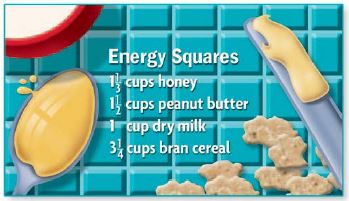
Question 16.
Reason Quantitatively Cal is making energy squares. How many \(\frac{1}{2}\) cups of peanut butter are used in the recipe?
_____ \(\frac{1}{2}\) cups of peanut butter
Answer: 3 \(\frac{1}{2}\) cups of peanut butter
Explanation:
Given that 1 \(\frac{1}{2}\) cups of peanut butter are used in the recipe.
We have to find how many \(\frac{1}{2}\) cups of peanut butter are used in the recipe.
\(\frac{1}{2}\) + \(\frac{1}{2}\) + \(\frac{1}{2}\)
Therefore 3 \(\frac{1}{2}\) cups of peanut butter are used in the recipe.
Question 17.
Suppose Cal wants to make 2 times as many energy squares as the recipe makes. How many cups of bran cereal should he use? Write your answer as a mixed number and as a fraction greater than 1 in simplest form.
Type below:
____________
Answer:
Take the amount of bran Cal is using and multiply it by 2
Given that 3 \(\frac{1}{4}\) cups of bran cereal is used in the recipe.
3 \(\frac{1}{4}\) × 2
= \(\frac{13}{4}\) × 2
= \(\frac{13}{2}\)
= 6 \(\frac{1}{2}\)
Thus 6 \(\frac{1}{2}\) cups of bran cereal he should use.
Question 18.
Cal added 2 \(\frac{3}{8}\) cups of raisins. Write this mixed number as a fraction greater than 1 in the simplest form.
\(\frac{□}{□}\)
Answer: \(\frac{19}{8}\)
Explanation:
Given,
Cal added 2 \(\frac{3}{8}\) cups of raisins.
Convert from the mixed fraction to the improper fraction.
2 \(\frac{3}{8}\) = \(\frac{19}{8}\)
Question 19.
Jenn is preparing brown rice. She needs 1 \(\frac{1}{2}\) cups of brown rice and 2 cups of water. Jenn has only a \(\frac{1}{8}\)– cup measuring cup. How many \(\frac{1}{8}\) cups each of rice and water will Jenn use to prepare the rice?
brown rice: ________ \(\frac{1}{8}\) cups
water: _________ \(\frac{1}{8}\) cups
Answer:
Number of water cups = 16
Number of brown rice cups = 12
Explanation:
Brown rice needed = 1 1/2 cups = 3/2 cups
Water needed = 2 cups
Measuring cups = 1/8
No. of cups used of water = 2/1/8 = 16
No. of cups used of rice = 3/2/1/8 = 12 cups
Question 20.
Draw a line to show the mixed number and fraction that have the same value.

Type below:
____________
Answer:
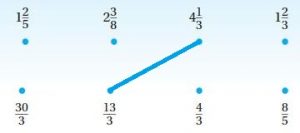
Rename Fractions and Mixed Numbers – Page No. 421
Write the mixed number as a fraction.
Question 1.
2 \(\frac{3}{5}\)

Question 2.
4 \(\frac{1}{3}\)
\(\frac{□}{□}\)
Answer: \(\frac{13}{3}\)
Explanation:
\(\frac{3}{3}\) + \(\frac{3}{3}\) + \(\frac{3}{3}\) + \(\frac{3}{3}\) + \(\frac{1}{3}\) = \(\frac{13}{3}\)
Question 3.
1 \(\frac{2}{5}\)
\(\frac{□}{□}\)
Answer: \(\frac{7}{5}\)
Explanation:
\(\frac{5}{5}\) + \(\frac{2}{5}\) = \(\frac{7}{5}\)
Question 4.
3 \(\frac{3}{2}\)
\(\frac{□}{□}\)
Answer: \(\frac{9}{2}\)
Explanation:
\(\frac{2}{2}\) + \(\frac{2}{2}\) + \(\frac{2}{2}\) + \(\frac{2}{2}\) + \(\frac{1}{2}\) = \(\frac{9}{2}\)
Question 5.
4 \(\frac{1}{8}\)
\(\frac{□}{□}\)
Answer: \(\frac{33}{8}\)
Explanation:
\(\frac{8}{8}\) + \(\frac{8}{8}\) + \(\frac{8}{8}\) + \(\frac{8}{8}\) + \(\frac{1}{8}\) = \(\frac{33}{8}\)
Question 6.
1 \(\frac{7}{10}\)
\(\frac{□}{□}\)
Answer: \(\frac{17}{10}\)
Explanation:
\(\frac{10}{10}\) + \(\frac{7}{10}\) = \(\frac{17}{10}\)
Question 7.
5 \(\frac{1}{2}\)
\(\frac{□}{□}\)
Answer: \(\frac{11}{2}\)
Explanation:
\(\frac{2}{2}\) + \(\frac{2}{2}\) + \(\frac{2}{2}\) + \(\frac{2}{2}\) + \(\frac{2}{2}\) + \(\frac{1}{2}\) = \(\frac{11}{2}\)
Question 8.
2 \(\frac{3}{8}\)
\(\frac{□}{□}\)
Answer: \(\frac{19}{8}\)
Explanation:
\(\frac{8}{8}\) + \(\frac{8}{8}\) + \(\frac{3}{8}\)
Write the fraction as a mixed number.
Question 9.
\(\frac{31}{6}\)
______ \(\frac{□}{□}\)
Answer: 5 \(\frac{1}{6}\)
Explanation:
\(\frac{6}{6}\) + \(\frac{6}{6}\) + \(\frac{6}{6}\) + \(\frac{6}{6}\) + \(\frac{6}{6}\) + \(\frac{1}{6}\)
1 + 1 + 1 + 1 + 1 + \(\frac{1}{6}\) = 5 \(\frac{1}{6}\)
Question 10.
\(\frac{20}{10}\)
______ \(\frac{□}{□}\)
Answer: 2
Explanation:
\(\frac{10}{10}\) + \(\frac{10}{10}\) = 1 + 1 = 2
Question 11.
\(\frac{15}{8}\)
______ \(\frac{□}{□}\)
Answer: 1 \(\frac{7}{8}\)
Explanation:
\(\frac{8}{8}\) + \(\frac{7}{8}\)
1 + \(\frac{7}{8}\) = 1 \(\frac{7}{8}\)
Question 12.
\(\frac{13}{6}\)
______ \(\frac{□}{□}\)
Answer: 2 \(\frac{1}{6}\)
Explanation:
\(\frac{6}{6}\) + \(\frac{6}{6}\) + \(\frac{1}{6}\)
= 1 + 1 + \(\frac{1}{6}\) = 2 \(\frac{1}{6}\)
Question 13.
\(\frac{23}{10}\)
______ \(\frac{□}{□}\)
Answer: 2 \(\frac{3}{10}\)
Explanation:
\(\frac{10}{10}\) + \(\frac{10}{10}\) + \(\frac{3}{10}\)
1 + 1 + \(\frac{3}{10}\) = 2 \(\frac{3}{10}\)
Question 14.
\(\frac{19}{5}\)
______ \(\frac{□}{□}\)
Answer: 3 \(\frac{4}{5}\)
Explanation:
\(\frac{5}{5}\) + \(\frac{5}{5}\) + \(\frac{5}{5}\) + \(\frac{4}{5}\)
1 + 1 + 1 + \(\frac{4}{5}\) = 3 \(\frac{4}{5}\)
Question 15.
\(\frac{11}{3}\)
______ \(\frac{□}{□}\)
Answer: 3 \(\frac{2}{3}\)
Explanation:
\(\frac{3}{3}\) + \(\frac{3}{3}\) + \(\frac{3}{3}\) + \(\frac{2}{3}\)
= 1 + 1 + 1 \(\frac{2}{3}\)
= 3 \(\frac{2}{3}\)
Question 16.
\(\frac{9}{2}\)
______ \(\frac{□}{□}\)
Answer: 4 \(\frac{1}{2}\)
Explanation:
\(\frac{2}{2}\) + \(\frac{2}{2}\) + \(\frac{2}{2}\) + \(\frac{2}{2}\) + \(\frac{1}{2}\)
= 1 + 1 + 1 + 1 + \(\frac{1}{2}\)
= 4 \(\frac{1}{2}\)
Question 17.
A recipe calls for 2 \(\frac{2}{4}\) cups of raisins, but Julie only has a \(\frac{1}{4}\) -cup measuring cup. How many \(\frac{1}{4}\) cups does Julie need to measure out 2 \(\frac{2}{4}\) cups of raisins?
She needs ______ \(\frac{1}{4}\) cups
Answer: 10 \(\frac{1}{4}\) cups
Explanation:
Given,
A recipe calls for 2 \(\frac{2}{4}\) cups of raisins, but Julie only has a \(\frac{1}{4}\) -cup measuring cup.
\(\frac{4}{4}\) + \(\frac{4}{4}\) + \(\frac{1}{4}\) + \(\frac{1}{4}\)
= 10 \(\frac{1}{4}\) cups
Question 18.
If Julie needs 3 \(\frac{1}{4}\) cups of oatmeal, how many \(\frac{1}{4}\) cups of oatmeal will she use?
She will use ______ \(\frac{1}{4}\) cups of oatmeal
Answer: 13 \(\frac{1}{4}\) cups of oatmeal
Explanation:
\(\frac{4}{4}\) + \(\frac{4}{4}\) + \(\frac{1}{4}\) + \(\frac{1}{4}\) + \(\frac{1}{4}\)
= 13 \(\frac{1}{4}\)
Therefore Julie needs 13 \(\frac{1}{4}\) cups of oatmeal.
Rename Fractions and Mixed Numbers – Lesson Check – Page No. 422
Question 1.
Which of the following is equivalent to \(\frac{16}{3}\) ?
Options:
a. 3 \(\frac{1}{5}\)
b. 3 \(\frac{2}{5}\)
c. 5 \(\frac{1}{3}\)
d. 5 \(\frac{6}{3}\)
Answer: 5 \(\frac{1}{3}\)
Explanation:
Convert from improper fraction to the mixed fraction.
\(\frac{16}{3}\) = \(\frac{3}{3}\) + \(\frac{3}{3}\) + \(\frac{3}{3}\) + \(\frac{3}{3}\) + \(\frac{3}{3}\) + \(\frac{1}{3}\)
= 5 \(\frac{1}{3}\)
Thus the correct answer is option c.
Question 2.
Stacey filled her \(\frac{1}{2}\)cup measuring cup seven times to have enough flour for a cake recipe. How much flour does the cake recipe call for?
Options:
a. 3 cups
b. 3 \(\frac{1}{2}\) cups
c. 4 cups
d. 4 \(\frac{1}{2}\) cups
Answer: 3 \(\frac{1}{2}\) cups
Explanation:
Given,
Stacey filled her \(\frac{1}{2}\)cup measuring cup seven times to have enough flour for a cake recipe.
\(\frac{2}{2}\) + \(\frac{2}{2}\) + \(\frac{2}{2}\) + \(\frac{1}{2}\)
1 + 1 + 1 + \(\frac{1}{2}\)
= 3 \(\frac{1}{2}\) cups
Thus the correct answer is option b.
Spiral Review
Question 3.
Becki put some stamps into her stamp collection book. She put 14 stamps on each page. If she completely filled 16 pages, how many stamps did she put in the book?
Options:
a. 224
b. 240
c. 272
d. 275
Answer: 224
Explanation:
Becki put some stamps into her stamp collection book.
She put 14 stamps on each page.
If she completely filled 16 pages
Multiply 14 with 16 pages.
14 × 16 = 224 pages
Thus the correct answer is option a.
Question 4.
Brian is driving 324 miles to visit some friends. He wants to get there in 6 hours. How many miles does he need to drive each hour?
Options:
a. 48 miles
b. 50 miles
c. 52 miles
d. 54 miles
Answer: 54 miles
Explanation:
Brian is driving 324 miles to visit some friends. He wants to get there in 6 hours.
Divide the number of miles by hours.
324/6 = 54 miles
Thus the correct answer is option d.
Question 5.
During a bike challenge, riders have to collect various colored ribbons. Each \(\frac{1}{2}\) mile they collect a red ribbon, each \(\frac{1}{8}\) mile they collect a green ribbon, and each \(\frac{1}{4}\) mile they collect a blue ribbon. Which colors of ribbons will be collected at the \(\frac{3}{4}\) mile marker?
Options:
a. red and green
b. red and blue
c. green and blue
d. red, green, and blue
Answer: green and blue
Explanation:
Given,
During a bike challenge, riders have to collect various colored ribbons.
Each \(\frac{1}{2}\) mile they collect a red ribbon, each \(\frac{1}{8}\) mile they collect a green ribbon, and each \(\frac{1}{4}\) mile they collect a blue ribbon.
Green and Blue colors of ribbons will be collected at the \(\frac{3}{4}\) mile marker.
Thus the correct answer is option c.
Question 6.
Stephanie had \(\frac{7}{8}\) pound of bird seed. She used \(\frac{3}{8}\) pound to fill a bird feeder. How much bird seed does Stephanie have left?
Options:
a. \(\frac{3}{8}\) pound
b. \(\frac{4}{8}\) pound
c. 1 pound
d. \(\frac{10}{8}\) pound
Answer: \(\frac{4}{8}\) pound
Explanation:
Given,
Stephanie had \(\frac{7}{8}\) pound of bird seed.
She used \(\frac{3}{8}\) pound to fill a bird feeder.
\(\frac{7}{8}\) – \(\frac{3}{8}\) = \(\frac{4}{8}\) pound
Thus the correct answer is option b.
Rename Fractions and Mixed Numbers – Page No. 425
Write the sum as a mixed number with the fractional part less than 1.
Question 1.
1 \(\frac{1}{6}\)
+3 \(\frac{3}{6}\)
———————–
_______ \(\frac{□}{□}\)
Answer: 4 \(\frac{2}{3}\)
Explanation:
1 \(\frac{1}{6}\)
+3 \(\frac{3}{6}\)
4 \(\frac{4}{6}\) = 4 \(\frac{2}{3}\)
Question 2.
1 \(\frac{4}{5}\)
+7 \(\frac{2}{5}\)
———————–
_______ \(\frac{□}{□}\)
Answer: 9 \(\frac{1}{5}\)
Explanation:
1 \(\frac{4}{5}\)
+7 \(\frac{2}{5}\)
8 \(\frac{6}{5}\) = 9 \(\frac{1}{5}\)
Question 3.
2 \(\frac{1}{2}\)
+3 \(\frac{1}{2}\)
———————–
_______
Answer: 6
Explanation:
2 \(\frac{1}{2}\)
+3 \(\frac{1}{2}\)
5 \(\frac{2}{2}\) = 6
Find the difference.
Question 4.
3 \(\frac{7}{12}\)
-2 \(\frac{5}{12}\)
———————–
_______ \(\frac{□}{□}\)
Answer: 1 \(\frac{1}{6}\)
Explanation:
3 \(\frac{7}{12}\)
-2 \(\frac{5}{12}\)
1 \(\frac{2}{12}\) = 1 \(\frac{1}{6}\)
Question 5.
4 \(\frac{2}{3}\)
-3 \(\frac{1}{3}\)
———————–
_______ \(\frac{□}{□}\)
Answer: 1 \(\frac{1}{3}\)
Explanation:
4 \(\frac{2}{3}\)
-3 \(\frac{1}{3}\)
1 \(\frac{1}{3}\)
Question 6.
6 \(\frac{9}{10}\)
-3 \(\frac{7}{10}\)
———————–
_______ \(\frac{□}{□}\)
Answer: 3 \(\frac{1}{5}\)
Explanation:
6 \(\frac{9}{10}\)
-3 \(\frac{7}{10}\)
3 \(\frac{2}{10}\)
Write the sum as a mixed number with the fractional part less than 1.
Question 7.
7 \(\frac{4}{6}\)
+4 \(\frac{3}{6}\)
———————–
_______ \(\frac{□}{□}\)
Answer: 12 \(\frac{1}{6}\)
Explanation:
7 \(\frac{4}{6}\)
+4 \(\frac{3}{6}\)
12 \(\frac{1}{6}\)
Question 8.
8 \(\frac{1}{3}\)
+3 \(\frac{2}{3}\)
———————–
_______ \(\frac{□}{□}\)
Answer: 12
Explanation:
8 \(\frac{1}{3}\)
+3 \(\frac{2}{3}\)
11 \(\frac{3}{3}\) = 12
Question 9.
5 \(\frac{4}{8}\)
+3 \(\frac{5}{8}\)
———————–
_______ \(\frac{□}{□}\)
Answer: 9 \(\frac{1}{8}\)
Explanation:
5 \(\frac{4}{8}\)
+3 \(\frac{5}{8}\)
9 \(\frac{1}{8}\)
Question 10.
5 \(\frac{5}{12}\)
+4 \(\frac{2}{12}\)
———————–
_______ \(\frac{□}{□}\)
Answer: 9 \(\frac{7}{12}\)
Explanation:
5 \(\frac{5}{12}\)
+4 \(\frac{2}{12}\)
9 \(\frac{7}{12}\)
Find the difference.
Question 11.
5 \(\frac{7}{8}\)
-2 \(\frac{3}{8}\)
———————–
_______ \(\frac{□}{□}\)
Answer: 3 \(\frac{1}{2}\)
Explanation:
5 \(\frac{7}{8}\)
-2 \(\frac{3}{8}\)
3 \(\frac{1}{2}\)
Question 12.
5 \(\frac{7}{12}\)
-4 \(\frac{1}{12}\)
———————–
_______ \(\frac{□}{□}\)
Answer: 1 \(\frac{1}{2}\)
Explanation:
5 \(\frac{7}{12}\)
-4 \(\frac{1}{12}\)
1 \(\frac{1}{2}\)
Question 13.
3 \(\frac{5}{10}\)
-1 \(\frac{3}{10}\)
———————–
_______ \(\frac{□}{□}\)
Answer: 2 \(\frac{1}{5}\)
Explanation:
3 \(\frac{5}{10}\)
-1 \(\frac{3}{10}\)
2 \(\frac{1}{5}\)
Question 14.
7 \(\frac{3}{4}\)
-2 \(\frac{2}{4}\)
———————–
_______ \(\frac{□}{□}\)
Answer: 5 \(\frac{1}{4}\)
Explanation:
7 \(\frac{3}{4}\)
-2 \(\frac{2}{4}\)
5 \(\frac{1}{4}\)
Practice: Copy and Solve Find the sum or difference.
Question 15.
\(1 \frac{3}{8}+2 \frac{7}{8}\) = _______ \(\frac{□}{□}\)
Answer: 4 \(\frac{1}{4}\)
Explanation:
First add the whole numbers
1 + 2 = 3
3/8 + 7/8 = 10/8
Convert from improper fraction to the mixed fraction
10/8 = 5/4 = 1 1/4
3 + 1 1/4 = 4 1/4
Question 16.
\(6 \frac{5}{8}\) – 4 = _______ \(\frac{□}{□}\)
Answer: 2 \(\frac{5}{8}\)
Explanation:
\(6 \frac{5}{8}\) – 4
Subtract the whole numbers
6 – 4 = 2
= 2 \(\frac{5}{8}\)
Question 17.
\(9 \frac{1}{2}+8 \frac{1}{2}\) = _______
Answer: 18
Explanation:
9 \(\frac{1}{2}\)
+ 8 \(\frac{1}{2}\)
18
Question 18.
\(6 \frac{3}{5}+4 \frac{3}{5}\) = _______ \(\frac{□}{□}\)
Answer: 11 \(\frac{1}{5}\)
Explanation:
6 \(\frac{3}{5}\)
+ 4 \(\frac{3}{5}\)
11 \(\frac{1}{5}\)
Question 19.
\(8 \frac{7}{10}-\frac{4}{10}\) = _______ \(\frac{□}{□}\)
Answer: 8 \(\frac{3}{10}\)
Explanation:
8 \(\frac{7}{10}\)
– \(\frac{4}{10}\)
8 \(\frac{3}{10}\)
Question 20.
\(7 \frac{3}{5}-6 \frac{3}{5}\) = _______
Answer: 1
Explanation:
7 \(\frac{3}{5}\)
+ 6 \(\frac{3}{5}\)
1
Rename Fractions and Mixed Numbers – Page No. 426
Solve. Write your answer as a mixed number.
Question 21.
Make Sense of Problems The driving distance from Alex’s house to the museum is 6 \(\frac{7}{10}\) miles. What is the round-trip distance?
_______ \(\frac{□}{□}\) miles
Answer: 13 \(\frac{2}{5}\) miles
Explanation:
Given that,
The driving distance from Alex’s house to the museum is 6 \(\frac{7}{10}\) miles.
To find the round-trip distance we have to multiply the driving distance with 2.
6 \(\frac{7}{10}\) × 2 = 13 \(\frac{4}{10}\)
= 13 \(\frac{2}{5}\) miles
Question 22.
The driving distance from the sports arena to Kristina’s house is 10 \(\frac{9}{10}\) miles. The distance from the sports arena to Luke’s house is 2 \(\frac{7}{10}\) miles. How much greater is the driving distance between the sports arena and Kristina’s house than between the sports arena and Luke’s house?
_______ \(\frac{□}{□}\) miles
Answer: 8 \(\frac{1}{5}\) miles
Explanation:
Given,
The driving distance from the sports arena to Kristina’s house is 10 \(\frac{9}{10}\) miles.
The distance from the sports arena to Luke’s house is 2 \(\frac{7}{10}\) miles.
10 \(\frac{9}{10}\) – 2 \(\frac{7}{10}\)
First, subtract the whole numbers and then subtract the fractions
10 – 2 = 8
\(\frac{9}{10}\) – \(\frac{7}{10}\) = \(\frac{1}{5}\)
= 8 \(\frac{1}{5}\) miles
Question 23.
Pedro biked from his house to the nature preserve, a distance of 23 \(\frac{4}{5}\) miles. Sandra biked from her house to the lake, a distance of 12 \(\frac{2}{5}\) miles. How many miles less did Sandra bike than Pedro?
_______ \(\frac{□}{□}\) miles
Answer: 11 \(\frac{2}{5}\) miles
Explanation:
Pedro biked from his house to the nature preserve, a distance of 23 4/5 miles. Converting 23 4/5 miles to an improper fraction, it becomes 119/5 miles.
Sandra biked from her house to the lake, a distance of 12 2/5 miles.
Converting 12 2/5 miles to an improper fraction, it becomes 62/5 miles.
Therefore, the difference in the number of miles biked by Sandra and Pedro is
119/5 – 62/5 = 57/5 = 11 2/5 miles
Question 24.
During the Martinez family trip, they drove from home to a ski lodge, a distance of 55 \(\frac{4}{5}\) miles, and then drove an additional 12 \(\frac{4}{5}\) miles to visit friends. If the family drove the same route back home, what was the distance traveled during their trip?
_______ \(\frac{□}{□}\) miles
Answer: 68 \(\frac{3}{5}\) miles
Explanation:
Given,
During the Martinez family trip, they drove from home to a ski lodge, a distance of 55 \(\frac{4}{5}\) miles, and then drove an additional 12 \(\frac{4}{5}\) miles to visit friends.
55 \(\frac{4}{5}\) + 12 \(\frac{4}{5}\) = 67 \(\frac{8}{5}\) = 68 \(\frac{3}{5}\) miles
Question 25.
For 25a–25d, select True or False for each statement.
a. 2 \(\frac{3}{8}\) + 1 \(\frac{6}{8}\) is equal to 4 \(\frac{1}{8}\).
i. True
ii. False
Answer: True
Explanation:
Given the statement 2 \(\frac{3}{8}\) + 1 \(\frac{6}{8}\) is equal to 4 \(\frac{1}{8}\).
First add the whole numbers
2 + 1 = 3
\(\frac{3}{8}\) + \(\frac{6}{8}\) = \(\frac{9}{8}\)
Convert the improper fraction to the mixed fraction.
\(\frac{9}{8}\) = 1 \(\frac{1}{8}\)
3 +1 \(\frac{1}{8}\) = 4 \(\frac{1}{8}\).
Thus the above statement is true.
Question 25.
b. 1 \(\frac{1}{6}\) + 1 \(\frac{4}{12}\) is equal to 2 \(\frac{2}{12}\).
i. True
ii. False
Answer: False
Explanation:
1 \(\frac{1}{6}\) + 1 \(\frac{4}{12}\) is equal to 2 \(\frac{2}{12}\).
First add the whole numbers
1 + 1 = 2
\(\frac{1}{6}\) = \(\frac{2}{12}\)
\(\frac{2}{12}\) + \(\frac{4}{12}\) = \(\frac{6}{12}\)
= 2 \(\frac{6}{12}\)
Thus the above statement is false.
Question 25.
c. 5 \(\frac{5}{6}\) – 2 \(\frac{4}{6}\) is equal to 1 \(\frac{3}{6}\).
i. True
ii. False
Answer: False
Explanation:
5 \(\frac{5}{6}\) – 2 \(\frac{4}{6}\) is equal to 1 \(\frac{3}{6}\).
5 – 2 = 3
\(\frac{5}{6}\) – \(\frac{4}{6}\) = \(\frac{1}{6}\)
= 3 \(\frac{1}{6}\)
Thus the above statement is false.
Question 25.
d. 5 \(\frac{5}{8}\) – 3 \(\frac{2}{8}\) is equal to 2 \(\frac{3}{8}\).
i. True
ii. False
Answer: True
Explanation:
5 \(\frac{5}{8}\) – 3 \(\frac{2}{8}\) is equal to 2 \(\frac{3}{8}\)
First, subtract the whole numbers
5 – 3 = 2
\(\frac{5}{8}\) – \(\frac{2}{8}\) = \(\frac{3}{8}\)
= 2 \(\frac{3}{8}\)
Thus the above statement is true.
Add and Subtract Mixed Numbers – Page No. 427
Find the sum. Write the sum as a mixed number, so the fractional part is less than 1.
Question 1.
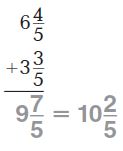
Question 2.
4 \(\frac{1}{2}\)
+2 \(\frac{1}{2}\)
_______ \(\frac{□}{□}\)
Answer: 7
4 \(\frac{1}{2}\)
+2 \(\frac{1}{2}\)
6 \(\frac{2}{2}\) = 6 + 1 = 7
Question 3.
2 \(\frac{2}{3}\)
+3 \(\frac{2}{3}\)
_______ \(\frac{□}{□}\)
Answer: 6 \(\frac{1}{3}\)
Explanation:
2 \(\frac{2}{3}\)
+3 \(\frac{2}{3}\)
5 \(\frac{4}{3}\)
= 5 + 1 \(\frac{1}{3}\)
= 6 \(\frac{1}{3}\)
Question 4.
6 \(\frac{4}{5}\)
+7 \(\frac{4}{5}\)
_______ \(\frac{□}{□}\)
Answer: 14 \(\frac{3}{5}\)
Explanation:
6 \(\frac{4}{5}\)
+7 \(\frac{4}{5}\)
13 \(\frac{8}{5}\)
13 + 1 \(\frac{3}{5}\)
= 14 \(\frac{3}{5}\)
Question 5.
9 \(\frac{3}{6}\)
+2 \(\frac{2}{6}\)
_______ \(\frac{□}{□}\)
Answer: 11 \(\frac{5}{6}\)
Explanation:
9 \(\frac{3}{6}\)
+2 \(\frac{2}{6}\)
11 \(\frac{5}{6}\)
Question 6.
8 \(\frac{4}{12}\)
+3 \(\frac{6}{12}\)
_______ \(\frac{□}{□}\)
Answer: 11 \(\frac{10}{12}\)
Explanation:
8 \(\frac{4}{12}\)
+3 \(\frac{6}{12}\)
11 \(\frac{10}{12}\)
Question 7.
4 \(\frac{3}{8}\)
+1 \(\frac{5}{8}\)
_______ \(\frac{□}{□}\)
Answer: 6
Explanation:
4 \(\frac{3}{8}\)
+1 \(\frac{5}{8}\)
5 \(\frac{8}{8}\)
= 5 + 1 = 6
Question 8.
9 \(\frac{5}{10}\)
+6 \(\frac{3}{10}\)
_______ \(\frac{□}{□}\)
Answer: 15 \(\frac{8}{10}\)
Explanation:
9 \(\frac{5}{10}\)
+6 \(\frac{3}{10}\)
15 \(\frac{8}{10}\)
Find the difference.
Question 9.
6 \(\frac{7}{8}\)
-4 \(\frac{3}{8}\)
_______ \(\frac{□}{□}\)
Answer: 2 \(\frac{4}{8}\)
Explanation:
6 \(\frac{7}{8}\)
-4 \(\frac{3}{8}\)
2 \(\frac{4}{8}\)
Question 10.
4 \(\frac{2}{3}\)
-3 \(\frac{1}{3}\)
_______ \(\frac{□}{□}\)
Answer: 1 \(\frac{1}{3}\)
Explanation:
4 \(\frac{2}{3}\)
-3 \(\frac{1}{3}\)
1 \(\frac{1}{3}\)
Question 11.
6 \(\frac{4}{5}\)
-3 \(\frac{3}{5}\)
_______ \(\frac{□}{□}\)
Answer: 3 \(\frac{1}{5}\)
Explanation:
6 \(\frac{4}{5}\)
-3 \(\frac{3}{5}\)
3 \(\frac{1}{5}\)
Question 12.
7 \(\frac{3}{4}\)
-2 \(\frac{1}{4}\)
_______ \(\frac{□}{□}\)
Answer: 5 \(\frac{1}{2}\)
Explanation:
7 \(\frac{3}{4}\)
-2 \(\frac{1}{4}\)
5 \(\frac{2}{4}\) = 5 \(\frac{1}{2}\)
Problem Solving
Question 13.
James wants to send two gifts by mail. One package weighs 2 \(\frac{3}{4}\) pounds. The other package weighs 1 \(\frac{3}{4}\) pounds. What is the total weight of the packages?
_______ \(\frac{□}{□}\)
Answer: 4 \(\frac{1}{2}\)
Explanation:
2 \(\frac{3}{4}\)
+ 1 \(\frac{3}{4}\)
4 \(\frac{1}{2}\)
Question 14.
Tierra bought 4 \(\frac{3}{8}\) yards blue ribbon and 2 \(\frac{1}{8}\) yards yellow ribbon for a craft project. How much more blue ribbon than yellow ribbon did Tierra buy?
_______ \(\frac{□}{□}\)
Answer: 2 \(\frac{1}{4}\)
Explanation:
Given,
4 \(\frac{3}{8}\)
-2 \(\frac{1}{8}\)
2 \(\frac{1}{4}\)
Add and Subtract Mixed Numbers – Lesson Check – Page No. 428
Question 1.
Brad has two lengths of copper pipe to fit together. One has a length of 2 \(\frac{5}{12}\) feet and the other has a length of 3 \(\frac{7}{12}\) feet. How many feet of pipe does he have in all?
Options:
a. 5 feet
b. 5 \(\frac{6}{12}\) feet
c. 5 \(\frac{10}{12}\) feet
d. 6 feet
Answer: 5 feet
Explanation:
Given,
Brad has two lengths of copper pipe to fit together. One has a length of 2 \(\frac{5}{12}\) feet and the other has a length of 3 \(\frac{7}{12}\) feet.
Add both the lengths
2 \(\frac{5}{12}\) + 3 \(\frac{7}{12}\)
= 5 \(\frac{12}{12}\) = 5 feet
Thus the correct answer is option a.
Question 2.
A pattern calls for 2 \(\frac{1}{4}\) yards of material and 1 \(\frac{1}{4}\) yards of lining. How much total fabric is needed?
Options:
a. 2 \(\frac{2}{4}\) yards
b. 3 yards
c. 3 \(\frac{1}{4}\) yards
d. 3 \(\frac{2}{4}\) yards
Answer: 3 \(\frac{2}{4}\) yards
Explanation:
Given,
A pattern calls for 2 \(\frac{1}{4}\) yards of material and 1 \(\frac{1}{4}\) yards of lining.
2 \(\frac{1}{4}\) + 1 \(\frac{1}{4}\)
= 3 + \(\frac{1}{4}\) + \(\frac{1}{4}\)
= 3 \(\frac{2}{4}\) yards
Thus the correct answer is option d.
Spiral Review
Question 3.
Shanice has 23 baseball trading cards of star players. She agrees to sell them for $16 each. How much will she get for the cards?
Options:
a. $258
b. $358
c. $368
d. $468
Answer: $368
Explanation:
Given,
Shanice has 23 baseball trading cards of star players. She agrees to sell them for $16 each.
To find how much will she get for the cards
23 × 16 = 368
Therefore she will get $368 for the cards.
Thus the correct answer is option c.
Question 4.
Nanci is volunteering at the animal shelter. She wants to spend an equal amount of time playing with each dog. She has 145 minutes to play with all 7 dogs. About how much time can she spend with each dog?
Options:
a. about 10 minutes
b. about 20 minutes
c. about 25 minutes
d. about 26 minutes
Answer: about 20 minutes
Explanation:
Given,
Nanci is volunteering at the animal shelter. She wants to spend an equal amount of time playing with each dog. She has 145 minutes to play with all 7 dogs.
145/7 = 20.7
Therefore she can spend about 20 minutes with each dog.
Thus the correct answer is option b.
Question 5.
Frieda has 12 red apples and 15 green apples. She is going to share the apples equally among 8 people and keep any extra apples for herself. How many apples will Frieda keep for herself?
Options:
a. 3
b. 4
c. 6
d. 7
Answer: 3
Explanation:
Given,
Frieda has 12 red apples and 15 green apples.
She is going to share the apples equally among 8 people and keep any extra apples for herself.
12 + 15 = 27
27/8
27 – 24 = 3
Thus Frieda keep for herself 3 apples.
Thus the correct answer is option a.
Question 6.
The Lynch family bought a house for $75,300. A few years later, they sold the house for $80,250. How much greater was the selling price than the purchase price?
Options:
a. $4,950
b. $5,050
c. $5,150
d. $5,950
Answer: $4,950
Explanation:
Given,
The Lynch family bought a house for $75,300.
A few years later, they sold the house for $80,250.
$80,250 – $75,300 = $4,950
Thus the correct answer is option a.
Add and Subtract Mixed Numbers – Page No. 431
Question 1.
Rename both mixed numbers as fractions. Find the difference.
3 \(\frac{3}{6}\) = \(\frac{■}{6}\)
−1 \(\frac{4}{6}\) = – \(\frac{■}{6}\)
—————————————-
_______ \(\frac{□}{□}\)
Answer: 1 \(\frac{5}{6}\)
Explanation:
Convert from mixed fractions to the improper fractions.
3 \(\frac{3}{6}\) = \(\frac{21}{6}\)
1 \(\frac{4}{6}\) = \(\frac{10}{6}\)
\(\frac{21}{6}\)
– \(\frac{10}{6}\)
\(\frac{11}{6}\)
Convert from improper fractions to the mixed fractions.
\(\frac{11}{6}\) = 1 \(\frac{5}{6}\)
Find the difference.
Question 2.
1 \(\frac{1}{3}\)
− \(\frac{2}{3}\)
———————
\(\frac{□}{□}\)
Answer: \(\frac{2}{3}\)
Explanation:
Convert from mixed fractions to improper fractions.
1 \(\frac{1}{3}\) = \(\frac{4}{3}\)
\(\frac{4}{3}\)
– \(\frac{2}{3}\)
\(\frac{2}{3}\)
Question 3.
4 \(\frac{7}{10}\)
− 1 \(\frac{9}{10}\)
———————
______ \(\frac{□}{□}\)
Answer: 2 \(\frac{8}{10}\)
Explanation:
Convert from mixed fractions to improper fractions.
4 \(\frac{7}{10}\) = \(\frac{47}{10}\)
1 \(\frac{9}{10}\) = \(\frac{19}{10}\)
\(\frac{47}{10}\)
– \(\frac{19}{10}\)
\(\frac{28}{10}\) = 2 \(\frac{8}{10}\)
Question 4.
3 \(\frac{5}{12}\)
− \(\frac{8}{12}\)
———————
_____ \(\frac{□}{□}\)
Answer: 2 \(\frac{9}{12}\)
Explanation:
Convert from mixed fractions to improper fractions.
3 \(\frac{5}{12}\) = \(\frac{41}{12}\)
\(\frac{41}{12}\)
− \(\frac{8}{12}\)
2 \(\frac{9}{12}\)
Question 5.
8 \(\frac{1}{10}\)
− 2 \(\frac{9}{10}\)
———————
\(\frac{□}{□}\)
Answer: 5 \(\frac{1}{5}\)
Explanation:
Convert from mixed fractions to improper fractions.
8 \(\frac{1}{10}\) = \(\frac{81}{10}\)
2 \(\frac{9}{10}\) = \(\frac{29}{10}\)
\(\frac{81}{10}\)
–\(\frac{29}{10}\)
\(\frac{52}{10}\) = 5 \(\frac{1}{5}\)
Question 6.
2
− 1 \(\frac{1}{4}\)
———————
\(\frac{□}{□}\)
Answer: \(\frac{3}{4}\)
Explanation:
Convert from mixed fractions to improper fractions.
1 \(\frac{1}{4}\) = \(\frac{5}{4}\)
2
− 1 \(\frac{1}{4}\)
\(\frac{3}{4}\)
Question 7.
4 \(\frac{1}{5}\)
− 3 \(\frac{2}{5}\)
———————
\(\frac{□}{□}\)
Answer: \(\frac{4}{5}\)
Explanation:
Convert from mixed fractions to improper fractions.
4 \(\frac{1}{5}\) = \(\frac{21}{5}\)
3 \(\frac{2}{5}\) = \(\frac{17}{5}\)
\(\frac{21}{5}\)
–\(\frac{17}{5}\)
\(\frac{4}{5}\)
Practice: Copy and Solve Find the difference.
Question 8.
\(4 \frac{1}{6}-2 \frac{5}{6}\)
_____ \(\frac{□}{□}\)
Answer: 1 \(\frac{1}{3}\)
Explanation:
Convert from mixed fractions to improper fractions.
4 \(\frac{1}{6}\) = \(\frac{25}{6}\)
2 \(\frac{5}{6}\) = \(\frac{17}{6}\)
\(\frac{25}{6}\)
–\(\frac{17}{6}\)
\(\frac{8}{6}\) = 1 \(\frac{1}{3}\)
Question 9.
\(6 \frac{9}{12}-3 \frac{10}{12}\)
_____ \(\frac{□}{□}\)
Answer: 2 \(\frac{11}{12}\)
Explanation:
Convert from mixed fractions to improper fractions.
6 \(\frac{9}{12}\)
– 3 \(\frac{10}{12}\)
2 \(\frac{11}{12}\)
Question 10.
\(3 \frac{3}{10}-\frac{7}{10}\)
_____ \(\frac{□}{□}\)
Answer: 2 \(\frac{3}{5}\)
Explanation:
Convert from mixed fractions to improper fractions.
3 \(\frac{3}{10}\) = \(\frac{33}{10}\)
\(\frac{33}{10}\)
– \(\frac{7}{10}\)
2 \(\frac{3}{5}\)
Question 11.
4 – 2 \(\frac{3}{5}\)
_____ \(\frac{□}{□}\)
Answer: 1 \(\frac{2}{5}\)
Explanation:
Convert from mixed fractions to improper fractions.
2 \(\frac{3}{5}\) = \(\frac{13}{5}\)
4
–\(\frac{13}{5}\)
1 \(\frac{2}{5}\)
Question 12.
Lisa mixed 4 \(\frac{2}{6}\) cups of orange juice with 3 \(\frac{1}{6}\) cups of pineapple juice to make fruit punch. She and her friends drank 3 \(\frac{4}{6}\) cups of the punch. How much of the fruit punch is left?
_____ \(\frac{□}{□}\) cups
Answer: 3 \(\frac{5}{6}\) cups
Explanation:
Given,
Lisa mixed 4 \(\frac{2}{6}\) cups of orange juice with 3 \(\frac{1}{6}\) cups of pineapple juice to make fruit punch.
She and her friends drank 3 \(\frac{4}{6}\) cups of the punch.
Convert from mixed fractions to improper fractions.
4 \(\frac{2}{6}\)
+ 3 \(\frac{1}{6}\)
7 \(\frac{3}{6}\)
Now subtract 3 \(\frac{4}{6}\) from 7 \(\frac{3}{6}\).
7 \(\frac{3}{6}\)
-3 \(\frac{4}{6}\)
3 \(\frac{5}{6}\)
Add and Subtract Mixed Numbers – Page No. 432
Rename the fractions to solve.
Many instruments are coiled or curved so that they are easier for the musician to play, but they would be quite long if straightened out completely.

Question 13.
Analyze Relationships Trumpets and cornets are brass instruments. Fully stretched out, the length of a trumpet is 5 \(\frac{1}{4}\) feet and the length of a cornet is 4 \(\frac{2}{4}\) feet. The trumpet is how much longer than the cornet?
\(\frac{□}{□}\) feet
Answer: \(\frac{3}{4}\) feet
Explanation:
Given,
Trumpets and cornets are brass instruments. Fully stretched out, the length of a trumpet is 5 \(\frac{1}{4}\) feet and the length of a cornet is 4 \(\frac{2}{4}\) feet.
5 \(\frac{1}{4}\) – 4 \(\frac{2}{4}\)
First subtract the whole numbers
5 – 4 = 1
\(\frac{1}{4}\) – \(\frac{2}{4}\) = \(\frac{1}{4}\)
1 – \(\frac{1}{4}\) = \(\frac{3}{4}\) feet
Therefore trumpet is \(\frac{3}{4}\) feet longer than the cornet.
Question 14.
Tubas, trombones, and French horns are brass instruments. Fully stretched out, the length of a tuba is 18 feet, the length of a trombone is 9 \(\frac{11}{12}\) feet, and the length of a French horn is 17 \(\frac{1}{12}\) feet. The tuba is how much longer than the French horn? The French horn is how much longer than the trombone?
Type below:
_____________
Answer:
First, convert the fractions to decimals making the trombone 8.93 feet and the french horn 17.21 feet. The tuba would be 0.79 feet longer than the french horn, and the french horn would be 8.23 feet longer than the trombone. However, if you need the answer to remain a fraction, the tuba would be 11/14 feet longer than a french horn, and a french horn would be 8 3/14 feet longer than a trombone.
Question 15.
The pitch of a musical instrument is related to its length. In general, the greater the length of a musical instrument, the lower its pitch. Order the brass instruments identified on this page from lowest pitch to the highest pitch.
____________
____________
____________
Answer:
Tuba
French Horn
Trombone
Explanation:
By seeing the above answer we can write the order of the brass instruments from the lowest pitch to the highest pitch. The order is tuba, french horn, and trombone.
Question 16.
Alicia had 3 \(\frac{1}{6}\)yards of fabric. After making a tablecloth, she had 1 \(\frac{3}{6}\) yards of fabric. Alicia said she used 2 \(\frac{3}{6}\) yards of fabric for the tablecloth. Do you agree? Explain.
______
Answer: Yes
Explanation:
An easier way to do this is to make the fractions improper fractions.
3 1/6 can be rewritten as 19/6. 1 4/6 can be rewritten as 10/6.
Multiply the denominator by the number at its side, and add it to the numerator.
2 3/6 is 15/6.
Subtract 10/6 from 19/6.
19/6-10/6=9/6.
9/6 is not 15/6, therefore she did not use 2 3/6 yards of fabric.
Record Subtraction with Renaming – Page No. 433
Find the difference.
Question 1.

Question 2.
6
– 3 \(\frac{2}{5}\)
_______ \(\frac{□}{□}\)
Answer: 2 \(\frac{3}{5}\)
Explanation:
First subtract the whole numbers
6 – 3 = 3
Next subtract the fractions,
3 – \(\frac{2}{5}\) = 2 \(\frac{3}{5}\)
Question 3.
5 \(\frac{1}{4}\)
– 2 \(\frac{3}{4}\)
_______ \(\frac{□}{□}\)
Answer: 2 \(\frac{1}{2}\)
Explanation:
First subtract the whole numbers
5 – 2 = 3
Next subtract the fractions,
\(\frac{1}{4}\) – \(\frac{3}{4}\) = – \(\frac{1}{2}\)
3 – \(\frac{1}{2}\)
= 2 \(\frac{1}{2}\)
Question 4.
9 \(\frac{3}{8}\)
– 8 \(\frac{7}{8}\)
_______ \(\frac{□}{□}\)
Answer: \(\frac{1}{2}\)
Explanation:
First subtract the whole numbers
9 – 8 = 1
Next subtract the fractions,
\(\frac{3}{8}\) – \(\frac{7}{8}\)
= – \(\frac{4}{8}\)
= – \(\frac{1}{2}\)
= 1 – \(\frac{1}{2}\)
= \(\frac{1}{2}\)
Question 5.
12 \(\frac{3}{10}\)
– 7 \(\frac{7}{10}\)
_______ \(\frac{□}{□}\)
Answer: 4 \(\frac{3}{5}\)
Explanation:
First subtract the whole numbers
12 – 7 = 5
Next subtract the fractions,
\(\frac{3}{10}\) – \(\frac{7}{10}\) = – \(\frac{4}{10}\)
5 – \(\frac{4}{10}\)
5 – \(\frac{2}{5}\) = 4 \(\frac{3}{5}\)
Question 6.
8 \(\frac{1}{6}\)
– 3 \(\frac{5}{6}\)
_______ \(\frac{□}{□}\)
Answer: 4 \(\frac{1}{3}\)
Explanation:
First subtract the whole numbers
8 – 3 = 5
Next subtract the fractions,
\(\frac{1}{6}\) – \(\frac{5}{6}\) = – \(\frac{2}{3}\)
5 – \(\frac{2}{3}\) = 4 \(\frac{1}{3}\)
Question 7.
7 \(\frac{3}{5}\)
– 4 \(\frac{4}{5}\)
_______ \(\frac{□}{□}\)
Answer: 2 \(\frac{4}{5}\)
Explanation:
First subtract the whole numbers
7 – 4 = 3
Next subtract the fractions,
\(\frac{3}{5}\) – \(\frac{4}{5}\) = – \(\frac{1}{5}\)
3 – \(\frac{1}{5}\) = 2 \(\frac{4}{5}\)
Question 8.
10 \(\frac{1}{2}\)
– 8 \(\frac{1}{2}\)
_______ \(\frac{□}{□}\)
Answer: 2
Explanation:
First subtract the whole numbers
10 – 8 = 2
\(\frac{1}{2}\) – \(\frac{1}{2}\) = 0
Question 9.
7 \(\frac{1}{6}\)
– 2 \(\frac{5}{6}\)
_______ \(\frac{□}{□}\)
Answer: 4 \(\frac{1}{3}\)
Explanation:
First subtract the whole numbers
7 – 2 = 5
Next subtract the fractions,
\(\frac{1}{6}\) – \(\frac{5}{6}\) = – \(\frac{4}{6}\)
5 – \(\frac{4}{6}\) = 4 \(\frac{1}{3}\)
Question 10.
9 \(\frac{3}{12}\)
– 4 \(\frac{7}{12}\)
_______ \(\frac{□}{□}\)
Answer: 2 \(\frac{2}{3}\)
Explanation:
First subtract the whole numbers
9 – 4 = 5
Next subtract the fractions,
\(\frac{3}{12}\) – \(\frac{7}{12}\) = – \(\frac{4}{12}\) = – \(\frac{1}{3}\)
5 – \(\frac{1}{3}\) = 2 \(\frac{2}{3}\)
Question 11.
9 \(\frac{1}{10}\)
– 8 \(\frac{7}{10}\)
_______ \(\frac{□}{□}\)
Answer: \(\frac{2}{5}\)
Explanation:
First subtract the whole numbers
9 – 8 = 1
Next subtract the fractions,
\(\frac{1}{10}\) – \(\frac{7}{10}\) = – \(\frac{6}{10}\)
1 – \(\frac{3}{5}\) = \(\frac{2}{5}\)
Question 12.
9 \(\frac{1}{3}\)
– \(\frac{2}{3}\)
_______ \(\frac{□}{□}\)
Answer: 8 \(\frac{2}{3}\)
Explanation:
9 \(\frac{1}{3}\)
– \(\frac{2}{3}\)
8 \(\frac{2}{3}\)
Question 13.
3 \(\frac{1}{4}\)
– 1 \(\frac{3}{4}\)
_______ \(\frac{□}{□}\)
Answer: 1 \(\frac{1}{2}\)
3 \(\frac{1}{4}\)
– 1 \(\frac{3}{4}\)
1 \(\frac{1}{2}\)
Question 14.
4 \(\frac{5}{8}\)
– 1 \(\frac{7}{8}\)
_______ \(\frac{□}{□}\)
Answer: 2 \(\frac{3}{4}\)
Explanation:
First subtract the whole numbers
4 – 1 = 3
Next subtract the fractions,
\(\frac{5}{8}\) – \(\frac{7}{8}\) = – \(\frac{1}{4}\)
3 – \(\frac{1}{4}\) = 2 \(\frac{3}{4}\)
Question 15.
5 \(\frac{1}{12}\)
– 3 \(\frac{8}{12}\)
_______ \(\frac{□}{□}\)
Answer: 1 \(\frac{5}{12}\)
Explanation:
First subtract the whole numbers
5 – 3 = 2
Next subtract the fractions,
\(\frac{1}{12}\) – \(\frac{8}{12}\) = – \(\frac{7}{12}\)
2 – \(\frac{7}{12}\) = 1 \(\frac{5}{12}\)
Question 16.
7
– 1 \(\frac{3}{5}\)
_______ \(\frac{□}{□}\)
Answer: 5 \(\frac{2}{5}\)
Explanation:
7
– 1 \(\frac{3}{5}\)
5 \(\frac{2}{5}\)
Problem Solving
Question 17.
Alicia buys a 5-pound bag of rocks for a fish tank. She uses 1 \(\frac{1}{8}\) pounds for a small fish bowl. How much is left?
_______ \(\frac{□}{□}\)
Answer: 3 \(\frac{7}{8}\)
Explanation:
Given,
Alicia buys a 5-pound bag of rocks for a fish tank. She uses 1 \(\frac{1}{8}\) pounds for a small fish bowl.
First subtract the whole numbers
5 – 1 = 4
4 – 1 \(\frac{1}{8}\)
= 3 \(\frac{7}{8}\)
Question 18.
Xavier made 25 pounds of roasted almonds for a fair. He has 3 \(\frac{1}{2}\) pounds left at the end of the fair. How many pounds of roasted almonds did he sell at the fair?
_______ \(\frac{□}{□}\)
Answer: 21 \(\frac{1}{2}\)
Explanation:
Given,
Xavier made 25 pounds of roasted almonds for a fair.
He has 3 \(\frac{1}{2}\) pounds left at the end of the fair.
First subtract the whole numbers
25 – 3 = 22
22 – \(\frac{1}{2}\) = 21 \(\frac{1}{2}\)
Record Subtraction with Renaming – Lesson Check – Page No. 434
Question 1.
Reggie is making a double-layer cake. The recipe for the first layer calls for 2 \(\frac{1}{4}\) cups sugar. The recipe for the second layer calls for 1 \(\frac{1}{4}\) cups sugar. Reggie has 5 cups of sugar. How much will he have left after making both recipes?
Options:
a. 1 \(\frac{1}{4}\) cups
b. 1 \(\frac{2}{4}\) cups
c. 2 \(\frac{1}{4}\) cups
d. 2 \(\frac{2}{4}\) cups
Answer: 1 \(\frac{2}{4}\) cups
Explanation:
Given,
Reggie is making a double-layer cake. The recipe for the first layer calls for 2 \(\frac{1}{4}\) cups sugar.
The recipe for the second layer calls for 1 \(\frac{1}{4}\) cups sugar.
Reggie has 5 cups of sugar.
2 \(\frac{1}{4}\) + 1 \(\frac{1}{4}\) = 3 \(\frac{1}{2}\)
5 – 3 \(\frac{1}{2}\) = 1 \(\frac{2}{4}\) cups
Thus the correct answer is option b.
Question 2.
Kate has 4 \(\frac{3}{8}\) yards of fabric and needs 2 \(\frac{7}{8}\) yards to make a skirt. How much extra fabric will she have left after making the skirt?
Options:
a. 2 \(\frac{4}{8}\) yards
b. 2 \(\frac{2}{8}\) yards
c. 1 \(\frac{4}{8}\) yards
d. 1 \(\frac{2}{8}\) yards
Answer: 1 \(\frac{4}{8}\) yards
Explanation:
Given,
Kate has 4 \(\frac{3}{8}\) yards of fabric and needs 2 \(\frac{7}{8}\) yards to make a skirt.
First, subtract the whole numbers
4 – 2 = 2
Next, subtract the fractions,
\(\frac{3}{8}\) – \(\frac{7}{8}\) = – \(\frac{4}{8}\)
2 – \(\frac{4}{8}\) = 1 \(\frac{4}{8}\) yards
Thus the correct answer is option c.
Spiral Review
Question 3.
Paulo has 128 glass beads to use to decorate picture frames. He wants to use the same number of beads on each frame. If he decorates 8 picture frames, how many beads will he put on each frame?
Options:
a. 6
b. 7
c. 14
d. 16
Answer: 16
Explanation:
Given,
Paulo has 128 glass beads to use to decorate picture frames. He wants to use the same number of beads on each frame
128/8 = 16
Thus the correct answer is option d.
Question 4.
Madison is making party favors. She wants to make enough favors so each guest gets the same number of favors. She knows there will be 6 or 8 guests at the party. What is the least number of party favors Madison should make?
Options:
a. 18
b. 24
c. 30
d. 32
Answer: 24
Explanation:
Given,
Madison is making party favors. She wants to make enough favors so each guest gets the same number of favors.
She knows there will be 6 or 8 guests at the party.
To find the least number of party favors, we have to consider the number of guests.
In this case, there are two possibilities—6 or 8.
For 6: 6, 12, 18, 24 (Add 6 to each number)
For 8: 8, 16, 24 (Add 8 to each number)
Now in both series, the least number (that is in common) is 24. Hence, Madison should make at least 24 party favors.
Thus the correct answer is option b.
Question 5.
A shuttle bus makes 4 round-trips between two shopping centers each day. The bus holds 24 people. If the bus is full on each one-way trip, how many passengers are carried by the bus each day?
Options:
a. 96
b. 162
c. 182
d. 192
Answer: 96
Explanation:
Given,
A shuttle bus makes 4 round-trips between two shopping centers each day. The bus holds 24 people.
4 × 24 = 96
Thus the correct answer is option a.
Question 6.
To make a fruit salad, Marvin mixes 1 \(\frac{3}{4}\) cups of diced peaches with 2 \(\frac{1}{4}\) cups of diced pears. How many cups of peaches and pears are in the fruit salad?
Options:
a. 4 cups
b. 3 \(\frac{2}{4}\) cups
c. 3 \(\frac{1}{4}\) cups
d. 3 cups
Answer: 4 cups
Explanation:
Given,
To make a fruit salad, Marvin mixes 1 \(\frac{3}{4}\) cups of diced peaches with 2 \(\frac{1}{4}\) cups of diced pears.
1 \(\frac{3}{4}\) + 2 \(\frac{1}{4}\)
= 4 cups
Thus the correct answer is option a.
Record Subtraction with Renaming – Page No. 437
Question 1.
Complete. Name the property used.
\(\left(3 \frac{4}{10}+5 \frac{2}{10}\right)+\frac{6}{10}\)
______ \(\frac{□}{□}\)
Answer:
The property used is associative property.
9 \(\frac{2}{10}\)
Explanation:
The associative property states that you can add or multiply regardless of how the numbers are grouped.
Given,
\(\left(3 \frac{4}{10}+5 \frac{2}{10}\right)+\frac{6}{10}\)
First add the whole numbers in the group.
(3 \(\frac{4}{10}\) + 5 \(\frac{2}{10}\)) + \(\frac{6}{10}\)
3 + 5 = 8
8 + \(\frac{4}{10}\) + \(\frac{2}{10}\) + \(\frac{6}{10}\)
Now add the fractions
8 + \(\frac{6}{10}\) + \(\frac{6}{10}\)
8 + \(\frac{12}{10}\)
Convert from improper fractions to the mixed fractions.
\(\frac{12}{10}\) = 1 \(\frac{2}{10}\)
8 + 1 \(\frac{2}{10}\) = 9 \(\frac{2}{10}\)
Thus \(\left(3 \frac{4}{10}+5 \frac{2}{10}\right)+\frac{6}{10}\) = 9 \(\frac{2}{10}\)
Use the properties and mental math to find the sum.
Question 2.
\(\left(2 \frac{7}{8}+3 \frac{2}{8}\right)+1 \frac{1}{8}\)
______ \(\frac{□}{□}\)
Answer: 7 \(\frac{1}{4}\)
Explanation:
The associative property states that you can add or multiply regardless of how the numbers are grouped.
Given
\(\left(2 \frac{7}{8}+3 \frac{2}{8}\right)+1 \frac{1}{8}\)
First add the whole numbers in the group.
(2 \(\frac{7}{8}\) + 3 \(\frac{2}{8}\)) + 1 \(\frac{1}{8}\)
2 + 3 = 5
5 + \(\frac{7}{8}\) + \(\frac{2}{8}\) + 1 \(\frac{1}{8}\)
5 + \(\frac{9}{8}\) + 1 \(\frac{1}{8}\)
6 + \(\frac{10}{8}\) = 7 \(\frac{1}{4}\)
Thus \(\left(2 \frac{7}{8}+3 \frac{2}{8}\right)+1 \frac{1}{8}\) = 7 \(\frac{1}{4}\)
Question 3.
\(1 \frac{2}{5}+\left(1+\frac{3}{5}\right)\)
______
Answer: 3
Explanation:
The associative property states that you can add or multiply regardless of how the numbers are grouped.
Given,
\(1 \frac{2}{5}+\left(1+\frac{3}{5}\right)\)
First add the whole numbers in the group.
1 + \(\frac{3}{5}\) = 1 \(\frac{3}{5}\)
1 \(\frac{2}{5}\) + 1 \(\frac{3}{5}\)
1 + 1 + \(\frac{5}{5}\)
1 + 1 + 1 = 3
Thus \(1 \frac{2}{5}+\left(1+\frac{3}{5}\right)\) = 3
Question 4.
\(5 \frac{3}{6}+\left(5 \frac{5}{6}+4 \frac{3}{6}\right)\)
______ \(\frac{□}{□}\)
Answer: 15 \(\frac{5}{6}\)
Explanation:
The associative property states that you can add or multiply regardless of how the numbers are grouped.
Given,
\(5 \frac{3}{6}+\left(5 \frac{5}{6}+4 \frac{3}{6}\right)\)
First add the whole numbers in the group.
5 + 4 = 9
\(\frac{5}{6}\) + \(\frac{3}{6}\) = \(\frac{8}{6}\)
5 \(\frac{3}{6}\) + 9 \(\frac{8}{6}\)
5 \(\frac{3}{6}\) + 10 \(\frac{2}{6}\) = 15 \(\frac{5}{6}\)
Thus \(5 \frac{3}{6}+\left(5 \frac{5}{6}+4 \frac{3}{6}\right)\) = 15 \(\frac{5}{6}\)
Question 5.
\(\left(1 \frac{1}{4}+1 \frac{1}{4}\right)+2 \frac{3}{4}\)
______ \(\frac{□}{□}\)
Answer: 5 \(\frac{1}{4}\)
Explanation:
The associative property states that you can add or multiply regardless of how the numbers are grouped.
Given,
\(\left(1 \frac{1}{4}+1 \frac{1}{4}\right)+2 \frac{3}{4}\)
First add the whole numbers in the group.
(1 \(\frac{1}{4}\) + 1 \(\frac{1}{4}\)) + 2 \(\frac{3}{4}\)
1 + 1 = 2
2 \(\frac{1}{4}\) + \(\frac{1}{4}\) + 2 \(\frac{3}{4}\)
2 \(\frac{1}{2}\) + 2 \(\frac{3}{4}\)
Add the whole numbers
2 + 2 = 4
4 \(\frac{1}{2}\) + \(\frac{3}{4}\) = 5 \(\frac{1}{4}\)
Thus \(\left(1 \frac{1}{4}+1 \frac{1}{4}\right)+2 \frac{3}{4}\) = 5 \(\frac{1}{4}\)
Question 6.
\(\left(12 \frac{4}{9}+1 \frac{2}{9}\right)+3 \frac{5}{9}\)
______ \(\frac{□}{□}\)
Answer: 17 \(\frac{2}{9}\)
Explanation:
The associative property states that you can add or multiply regardless of how the numbers are grouped.
Given,
\(\left(12 \frac{4}{9}+1 \frac{2}{9}\right)+3 \frac{5}{9}\)
First add the whole numbers in the group.
12 + 1 = 13
Add the fraction in the group.
\(\frac{4}{9}\) + \(\frac{2}{9}\) + 3 \(\frac{5}{9}\)
= 13 \(\frac{6}{9}\) + 3 \(\frac{5}{9}\)
= 16 \(\frac{11}{9}\)
= 17 \(\frac{2}{9}\)
Thus \(\left(12 \frac{4}{9}+1 \frac{2}{9}\right)+3 \frac{5}{9}\) = 17 \(\frac{2}{9}\)
Question 7.
\(\left(\frac{3}{12}+1 \frac{8}{12}\right)+\frac{9}{12}\)
______ \(\frac{□}{□}\)
Answer: 2 \(\frac{2}{3}\)
Explanation:
The associative property states that you can add or multiply regardless of how the numbers are grouped.
Given,
\(\left(\frac{3}{12}+1 \frac{8}{12}\right)+\frac{9}{12}\)
First add the fractions in the group.
\(\frac{3}{12}\) + \(\frac{8}{12}\) = \(\frac{11}{12}\)
1 \(\frac{11}{12}\) + \(\frac{9}{12}\) = 1 \(\frac{20}{12}\)
= 2 \(\frac{2}{3}\)
Thus \(\left(\frac{3}{12}+1 \frac{8}{12}\right)+\frac{9}{12}\) = 2 \(\frac{2}{3}\)
Use the properties and mental math to find the sum.
Question 8.
\(\left(45 \frac{1}{3}+6 \frac{1}{3}\right)+38 \frac{2}{3}\)
______ \(\frac{□}{□}\)
Answer: 90 \(\frac{1}{3}\)
Explanation:
Given,
\(\left(45 \frac{1}{3}+6 \frac{1}{3}\right)+38 \frac{2}{3}\)
First add the whole numbers in the group.
45 + 6 = 51
(51 \(\frac{1}{3}\) + \(\frac{1}{3}\)) + 38 \(\frac{2}{3}\)
51 \(\frac{2}{3}\) + 38 \(\frac{2}{3}\)
= 89 \(\frac{4}{3}\)
= 90 \(\frac{1}{3}\)
Thus \(\left(45 \frac{1}{3}+6 \frac{1}{3}\right)+38 \frac{2}{3}\) = 90 \(\frac{1}{3}\)
Question 9.
\(\frac{1}{2}+\left(103 \frac{1}{2}+12\right)\)
______ \(\frac{□}{□}\)
Answer: 116
Explanation:
Given,
\(\frac{1}{2}+\left(103 \frac{1}{2}+12\right)\)
First add the whole numbers in the group.
103 + \(\frac{1}{2}\) + 12 = 115 \(\frac{1}{2}\)
115 \(\frac{1}{2}\) + \(\frac{1}{2}\) = 116
Thus \(\frac{1}{2}+\left(103 \frac{1}{2}+12\right)\) = 116
Question 10.
\(\left(3 \frac{5}{10}+10\right)+11 \frac{5}{10}\)
______
Answer: 25
Explanation:
Given,
\(\left(3 \frac{5}{10}+10\right)+11 \frac{5}{10}\)
First add the whole numbers in the group.
3 + 10 = 13
13 + \(\frac{5}{10}\) + 11 \(\frac{5}{10}\)
Add the whole numbers
13 + 11 = 24
24 + \(\frac{5}{10}\) + \(\frac{5}{10}\) = 25
Thus \(\left(3 \frac{5}{10}+10\right)+11 \frac{5}{10}\) = 25
Question 11.
Pablo is training for a marathon. He ran 5 \(\frac{4}{8}\) miles on Friday, 6 \(\frac{5}{8}\) miles on Saturday, and 7 \(\frac{4}{8}\) miles on Sunday. How many miles did he run on all three days?
______ \(\frac{□}{□}\) miles
Answer: 19 \(\frac{5}{8}\) miles
Explanation:
Given,
Pablo is training for a marathon. He ran 5 \(\frac{4}{8}\) miles on Friday, 6 \(\frac{5}{8}\) miles on Saturday, and 7 \(\frac{4}{8}\) miles on Sunday.
Add all the fractions to find how many miles he runs on all three days.
5 \(\frac{4}{8}\) + 6 \(\frac{5}{8}\) + 7 \(\frac{4}{8}\)
First add the whole numbers
5 + 6 + 7 = 18
18 + \(\frac{4}{8}\) + \(\frac{5}{8}\) + \(\frac{4}{8}\)
= 18 + \(\frac{13}{8}\)
= 19 \(\frac{5}{8}\) miles
Therefore Pablo runs 19 \(\frac{5}{8}\) miles on all three days.
Question 12.
At lunchtime, Dale’s Diner served a total of 2 \(\frac{2}{6}\) pots of vegetable soup, 3 \(\frac{5}{6}\) pots of chicken soup, and 4 \(\frac{3}{6}\) pots of tomato soup. How many pots of soup were served in all?
______ \(\frac{□}{□}\) pots
Answer: 10 \(\frac{2}{3}\) pots
Explanation:
Given,
At lunchtime, Dale’s Diner served a total of 2 \(\frac{2}{6}\) pots of vegetable soup, 3 \(\frac{5}{6}\) pots of chicken soup, and 4 \(\frac{3}{6}\) pots of tomato soup.
2 \(\frac{2}{6}\) + 3 \(\frac{5}{6}\) + 4 \(\frac{3}{6}\)
First add the whole numbers
2 + 3 + 4 = 9
Next add the fractions.
\(\frac{2}{6}\) + \(\frac{5}{6}\) + \(\frac{3}{6}\)
= \(\frac{10}{6}\)
9 + \(\frac{10}{6}\) = 10 \(\frac{2}{3}\) pots
Therefore 10 \(\frac{2}{3}\) pots of soup were served in all.
Use the expressions in the box for 13–14.
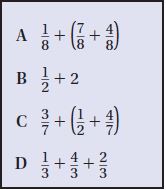
Question 13.
Which property of addition would you use to regroup the addends in Expression A?
______ property
Answer: Associative Property
Explanation:
The associative property states that you can add or multiply regardless of how the numbers are grouped.
Expression A is \(\frac{1}{8}\) + (\(\frac{7}{8}\) + \(\frac{4}{8}\))
The denominators of all three fractions are the same. So, the property for expression A is Associative Property.
Question 14.
Which two expressions have the same value?
________ and _________
Answer: A and C
Explanation:
Expression A is \(\frac{1}{8}\) + (\(\frac{7}{8}\) + \(\frac{4}{8}\))
\(\frac{1}{8}\) + (\(\frac{11}{8}\) = \(\frac{12}{8}\)
Expression B is 1/2 + 2
1/2 + 4/2 = 5/2
Expression C is \(\frac{3}{7}\) + (\(\frac{1}{2}\) + \(\frac{4}{7}\))
\(\frac{1}{2}\) + \(\frac{4}{7}\) = \(\frac{7}{14}\) + \(\frac{8}{14}\) = \(\frac{15}{14}\)
\(\frac{15}{14}\) + \(\frac{3}{7}\) = \(\frac{15}{14}\) + \(\frac{6}{14}\) = \(\frac{21}{14}\)
Thus the expressions A and C has the same value.
Question 15.
Match the equation with the property used.

Type below:
_________
Answer:

Record Subtraction with Renaming – Page No. 438
Pose a Problem
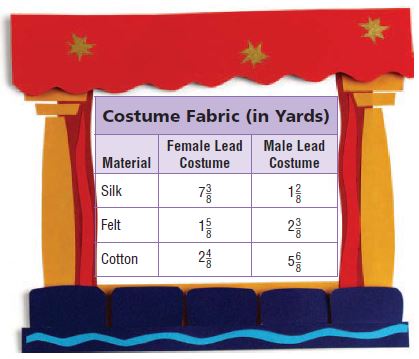
Question 16.
Costumes are being made for the high school musical. The table at the right shows the amount of fabric needed for the costumes of the male and female leads. Alice uses the expression \(7 \frac{3}{8}+1 \frac{5}{8}+2 \frac{4}{8}\) to find the total amount of fabric needed for the costume of the female lead. To find the value of the expression using mental math, Alice used the properties of addition.
\(7 \frac{3}{8}+1 \frac{5}{8}+2 \frac{4}{8}=\left(7 \frac{3}{8}+1 \frac{5}{8}\right)+2 \frac{4}{8}\)
Alice added 7 + 1 and was able to quickly add \(\frac{3}{8}\) and \(\frac{5}{8}\) to the sum of 8 to get 9. She added 2 \(\frac{4}{8}\) to 9, so her answer was 11 \(\frac{4}{8}\).
So, the amount of fabric needed for the costume of the female lead actor is 11 \(\frac{4}{8}\) yards.
Write a new problem using the information for the costume for the male lead actor.
Pose a Problem Solve your problem. Check your solution.
Type below:
_____________
Answer:
Alice used the expressions 1 2/8 + 2 3/8 + 5 6/8 to find the total amount of frabric needed for the costume of the male lead. What is the total amount of fabric needed for the costume?
Answer: Alice wrote the expressions as (1 2/8 + 5 6/8) + 2 3/8 and simplified it by adding the whole number parts and the fraction parts in the parentheses.
Then she added the mixed number: 1 + 5 + 1 + 2 3/8 = 9 3/8.
So, the male leads costume needed 9 3/8 yards of fabric.
Question 16.
Identify Relationships Explain how using the properties of addition makes both problems easier to solve.
Type below:
____________
Answer:
The properties make the properties the easier to solve because you can rearrange the mixed numbers so that their fraction parts add to 1.
Fractions and Properties of Addition – Page No. 439
Use the properties and mental math to find the sum.
Question 1.
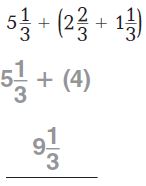
Question 2.
\(10 \frac{1}{8}+\left(3 \frac{5}{8}+2 \frac{7}{8}\right)\)
_______ \(\frac{□}{□}\)
Answer: 16 \(\frac{5}{8}\)
Explanation:
Given,
\(10 \frac{1}{8}+\left(3 \frac{5}{8}+2 \frac{7}{8}\right)\)
First add the whole numbers in the bracket.
3 + 2 = 5
10 \(\frac{1}{8}\) + 5 + \(\frac{5}{8}\) + \(\frac{7}{8}\)
10 \(\frac{1}{8}\) + 5 + \(\frac{12}{8}\)
10 + 5 = 15
15 + \(\frac{1}{8}\) + \(\frac{12}{8}\)
15 + \(\frac{13}{8}\)
16 \(\frac{5}{8}\)
\(10 \frac{1}{8}+\left(3 \frac{5}{8}+2 \frac{7}{8}\right)\) = 16 \(\frac{5}{8}\)
Question 3.
\(8 \frac{1}{5}+\left(3 \frac{2}{5}+5 \frac{4}{5}\right)\)
_______ \(\frac{□}{□}\)
Answer: 17 \(\frac{2}{5}\)
Explanation:
\(8 \frac{1}{5}+\left(3 \frac{2}{5}+5 \frac{4}{5}\right)\)
8 \(\frac{1}{5}\) + 3 \(\frac{2}{5}\) + 5 \(\frac{4}{5}\)
3 + 5 = 8
8 \(\frac{1}{5}\) + 8 + \(\frac{2}{5}\) + \(\frac{4}{5}\)
8 \(\frac{1}{5}\) + 8 + \(\frac{6}{5}\)
8 + 8 = 16
16 + \(\frac{1}{5}\) + \(\frac{6}{5}\)
16 + \(\frac{7}{5}\)
17 \(\frac{2}{5}\)
\(8 \frac{1}{5}+\left(3 \frac{2}{5}+5 \frac{4}{5}\right)\) = 17 \(\frac{2}{5}\)
Question 4.
\(6 \frac{3}{4}+\left(4 \frac{2}{4}+5 \frac{1}{4}\right)\)
_______ \(\frac{□}{□}\)
Answer: 16 \(\frac{1}{2}\)
Explanation:
\(6 \frac{3}{4}+\left(4 \frac{2}{4}+5 \frac{1}{4}\right)\)
First add the whole numbers in the bracket.
6 \(\frac{3}{4}\) + 4 \(\frac{2}{4}\) + 5 \(\frac{1}{4}\)
4 + 5 = 9
6 \(\frac{3}{4}\) + 9 \(\frac{3}{4}\)
6 + 9 = 15
15 + \(\frac{3}{4}\) + \(\frac{3}{4}\)
16 \(\frac{1}{2}\)
\(6 \frac{3}{4}+\left(4 \frac{2}{4}+5 \frac{1}{4}\right)\) = 16 \(\frac{1}{2}\)
Question 5.
\(\left(6 \frac{3}{6}+10 \frac{4}{6}\right)+9 \frac{2}{6}\)
_______ \(\frac{□}{□}\)
Answer: 26 \(\frac{3}{6}\)
Explanation:
\(\left(6 \frac{3}{6}+10 \frac{4}{6}\right)+9 \frac{2}{6}\)
6 \(\frac{3}{6}\) + 10 \(\frac{4}{6}\) + 9 \(\frac{2}{6}\)
First add the whole numbers in the bracket.
6 + 10 = 16
16 + \(\frac{3}{6}\) + \(\frac{4}{6}\) + 9 \(\frac{2}{6}\)
16 + \(\frac{7}{6}\) + 9 \(\frac{2}{6}\)
16 + 9 = 25
25 + \(\frac{7}{6}\) + \(\frac{2}{6}\)
25 + \(\frac{9}{6}\)
= 26 \(\frac{3}{6}\)
\(\left(6 \frac{3}{6}+10 \frac{4}{6}\right)+9 \frac{2}{6}\) = 26 \(\frac{3}{6}\)
Question 6.
\(\left(6 \frac{2}{5}+1 \frac{4}{5}\right)+3 \frac{1}{5}\)
_______ \(\frac{□}{□}\)
Answer: 11 \(\frac{2}{5}\)
Explanation:
\(\left(6 \frac{2}{5}+1 \frac{4}{5}\right)+3 \frac{1}{5}\)
6 \(\frac{2}{5}\) + 1 \(\frac{4}{5}\) + 3 \(\frac{1}{5}\)
First add the whole numbers in the bracket.
6 + 1 = 7
7 \(\frac{2}{5}\) + \(\frac{4}{5}\) + 3 \(\frac{1}{5}\)
7 + \(\frac{6}{5}\) + 3 \(\frac{1}{5}\)
7 + 3 = 10
10 + \(\frac{6}{5}\) + \(\frac{1}{5}\)
10 + \(\frac{7}{5}\) = 11 \(\frac{2}{5}\)
Therefore \(\left(6 \frac{2}{5}+1 \frac{4}{5}\right)+3 \frac{1}{5}\) = 11 \(\frac{2}{5}\)
Question 7.
\(7 \frac{7}{8}+\left(3 \frac{1}{8}+1 \frac{1}{8}\right)\)
_______ \(\frac{□}{□}\)
Answer: 12 \(\frac{1}{8}\)
Explanation:
\(7 \frac{7}{8}+\left(3 \frac{1}{8}+1 \frac{1}{8}\right)\)
7 \(\frac{7}{8}\) + 3 \(\frac{1}{8}\) + 1 \(\frac{1}{8}\)
First add the whole numbers in the bracket.
3 + 1 = 4
7 \(\frac{7}{8}\) + 4 + \(\frac{1}{8}\) + \(\frac{1}{8}\)
7 \(\frac{7}{8}\) + 4 +\(\frac{2}{8}\)
7 + 4 = 11
11 + \(\frac{7}{8}\) + \(\frac{2}{8}\)
11 + \(\frac{9}{8}\) = 12 \(\frac{1}{8}\)
Thus \(7 \frac{7}{8}+\left(3 \frac{1}{8}+1 \frac{1}{8}\right)\) = 12 \(\frac{1}{8}\)
Question 8.
\(14 \frac{1}{10}+\left(20 \frac{2}{10}+15 \frac{7}{10}\right)\)
_______ \(\frac{□}{□}\)
Answer: 50
Explanation:
\(14 \frac{1}{10}+\left(20 \frac{2}{10}+15 \frac{7}{10}\right)\)
First add the whole numbers in the bracket.
14 \(\frac{1}{10}\) + 20 \(\frac{2}{10}\) + 15 \(\frac{7}{10}\)
20 + 15 = 35
14 \(\frac{1}{10}\) + 35 + \(\frac{2}{10}\) + \(\frac{7}{10}\)
14 \(\frac{1}{10}\) + 35 \(\frac{9}{10}\)
49 \(\frac{1}{10}\) + \(\frac{9}{10}\)
49 + 1 = 50
Thus \(14 \frac{1}{10}+\left(20 \frac{2}{10}+15 \frac{7}{10}\right)\) = 50
Question 9.
\(\left(13 \frac{2}{12}+8 \frac{7}{12}\right)+9 \frac{5}{12}\)
_______ \(\frac{□}{□}\)
Answer: 31 \(\frac{2}{12}\)
Explanation:
\(\left(13 \frac{2}{12}+8 \frac{7}{12}\right)+9 \frac{5}{12}\)
13 \(\frac{2}{12}\) + 8 \(\frac{7}{12}\) + 9 \(\frac{5}{12}\)
First add the whole numbers in the bracket.
13 + 8 = 21
21 + \(\frac{2}{12}\) + \(\frac{7}{12}\) + 9 \(\frac{5}{12}\)
21 + \(\frac{9}{12}\) + 9 \(\frac{5}{12}\)
30 + \(\frac{9}{12}\) + \(\frac{5}{12}\) = 31 \(\frac{2}{12}\)
Thus \(\left(13 \frac{2}{12}+8 \frac{7}{12}\right)+9 \frac{5}{12}\) = 31 \(\frac{2}{12}\)
Problem Solving
Question 10.
Nate’s classroom has three tables of different lengths. One has a length of 4 \(\frac{1}{2}\) feet, another has a length of 4 feet, and a third has a length of 2 \(\frac{1}{2}\) feet. What is the length of all three tables when pushed end to end?
_______ \(\frac{□}{□}\)
Answer: 11
Explanation:
Given,
Nate’s classroom has three tables of different lengths. One has a length of 4 \(\frac{1}{2}\) feet, another has a length of 4 feet, and a third has a length of 2 \(\frac{1}{2}\) feet.
4 \(\frac{1}{2}\) + 4 + 2 \(\frac{1}{2}\)
4 + 4 + 2 = 10
\(\frac{1}{2}\) + \(\frac{1}{2}\) = 1
10 + 1 = 11
Therefore the length of all three tables when pushed end to end is 11 feet.
Question 11.
Mr. Warren uses 2 \(\frac{1}{4}\) bags of mulch for his garden and another 4 \(\frac{1}{4}\) bags for his front yard. He also uses \(\frac{3}{4}\) bag around a fountain. How many total bags of mulch does Mr. Warren use?
_______ \(\frac{□}{□}\)
Answer: 7 \(\frac{1}{4}\)
Explanation:
Given,
Mr. Warren uses 2 \(\frac{1}{4}\) bags of mulch for his garden and another 4 \(\frac{1}{4}\) bags for his front yard.
He also uses \(\frac{3}{4}\) bag around a fountain.
2 \(\frac{1}{4}\) + 4 \(\frac{1}{4}\) + \(\frac{3}{4}\)
2 + 4 = 6
6 + \(\frac{1}{4}\) + \(\frac{1}{4}\) + \(\frac{3}{4}\)
= 7 \(\frac{1}{4}\)
Fractions and Properties of Addition – Lesson Check – Page No. 440
Question 1.
A carpenter cut a board into three pieces. One piece was 2 \(\frac{5}{6}\) feet long. The second piece was 3 \(\frac{1}{6}\) feet long. The third piece was 1 \(\frac{5}{6}\) feet long. How long was the board?
Options:
a. 6 \(\frac{5}{6}\) feet
b. 7 \(\frac{1}{6}\) feet
c. 7 \(\frac{5}{6}\) feet
d. 8 \(\frac{1}{6}\) feet
Answer: c. 7 \(\frac{5}{6}\) feet
Explanation:
Given,
A carpenter cut a board into three pieces. One piece was 2 \(\frac{5}{6}\) feet long. The second piece was 3 \(\frac{1}{6}\) feet long.
The third piece was 1 \(\frac{5}{6}\) feet long.
Add three pieces.
2 \(\frac{5}{6}\) + 3 \(\frac{1}{6}\)
= 5 + \(\frac{6}{6}\)
= 5 + 1 = 6
6 + 1 \(\frac{5}{6}\)
= 7 \(\frac{5}{6}\) feet
Thus the correct answer is option c.
Question 2.
Harry works at an apple orchard. He picked 45 \(\frac{7}{8}\) pounds of apples on Monday. He picked 42 \(\frac{3}{8}\) pounds of apples on Wednesday. He picked 54 \(\frac{1}{8}\) pounds of apples on Friday. How many pounds of apples did Harry pick those three days?
Options:
a. 132 \(\frac{3}{8}\) pounds
b. 141 \(\frac{3}{8}\) pounds
c. 142 \(\frac{1}{8}\) pounds
d. 142 \(\frac{3}{8}\) pounds
Answer: 142 \(\frac{3}{8}\) pounds
Explanation:
Given,
Harry works at an apple orchard. He picked 45 \(\frac{7}{8}\) pounds of apples on Monday.
He picked 42 \(\frac{3}{8}\) pounds of apples on Wednesday.
He picked 54 \(\frac{1}{8}\) pounds of apples on Friday.
45 \(\frac{7}{8}\) + 42 \(\frac{3}{8}\) + 54 \(\frac{1}{8}\)
Add the whole numbers first
45 + 42 + 54 = 141
141 + \(\frac{7}{8}\) + \(\frac{3}{8}\) + \(\frac{1}{8}\)
141 + 1 \(\frac{3}{8}\)
= 142 \(\frac{3}{8}\) pounds
Thus the correct answer is option d.
Spiral Review
Question 3.
There were 6 oranges in the refrigerator. Joey and his friends ate 3 \(\frac{2}{3}\) oranges. How many oranges were left?
Options:
a. 2 \(\frac{1}{3}\) oranges
b. 2 \(\frac{2}{3}\) oranges
c. 3 \(\frac{1}{3}\) oranges
d. 9 \(\frac{2}{3}\) oranges
Answer: 9 \(\frac{2}{3}\) oranges
Explanation:
Given,
There were 6 oranges in the refrigerator.
Joey and his friends ate 3 \(\frac{2}{3}\) oranges.
6 + 3 \(\frac{2}{3}\)
= 9 \(\frac{2}{3}\) oranges
Thus the correct answer is option d.
Question 4.
Darlene was asked to identify which of the following numbers is prime. Which number should she choose?
Options:
a. 2
b. 12
c. 21
d. 39
Answer: 2
Explanation:
A prime number is an integer, or whole number, that has only two factors 1 and itself.
In the above options, all are composite numbers except 2.
Therefore 2 is a prime number.
Thus the correct answer is option a.
Question 5.
A teacher has 100 chairs to arrange for an assembly. Which of the following is NOT a way the teacher could arrange the chairs?
Options:
a. 10 rows of 10 chairs
b. 8 rows of 15 chairs
c. 5 rows of 20 chairs
d. 4 rows of 25 chairs
Answer: 8 rows of 15 chairs
Explanation:
A teacher has 100 chairs to arrange for an assembly.
15 × 8 = 120
So, 8 rows of 15 chairs are not the way to arrange the chairs.
Thus the correct answer is option b.
Question 6.
Nic bought 28 folding chairs for $16 each. How much money did Nic spend on chairs?
Options:
a. $196
b. $348
c. $448
d. $600
Answer: c. $448
Explanation:
Given,
Nic bought 28 folding chairs for $16 each.
28 × 16 = 448
Thus the correct answer is option c.
Fractions and Properties of Addition – Lesson Check – Page No. 443
Question 1.
Last week, Sia ran 1 \(\frac{1}{4}\) miles each day for 5 days and then took 2 days off. Did she run at least 6 miles last week? First, model the problem. Describe your model.
Type below:
_________
Answer:
I will model the problem using fraction strips. I need a 1 strip for the whole and a 1/4 part for each of the 5 days. My model has a total of five 1 strops and five 1/4 parts.
Question 1.
Then, regroup the parts in the model to find the number of whole miles Sia ran.
Sia ran ___________ whole miles and ___________ mile.
Finally, compare the total number of miles she ran to 6 miles.
So, Sia ___________ run at least 6 miles last week.
6 \(\frac{1}{4}\) miles _____ 6 miles
Answer:
Sia ran 6 whole miles and 1/4 mile.
So, Sia did run at least 6 miles last week.
6 \(\frac{1}{4}\) miles > 6 miles
Question 2.
What if Sia ran only \(\frac{3}{4}\) mile each day. Would she have run at least 6 miles last week? Explain.
_____
Answer: No
Explanation:
She would have run \(\frac{3}{4}\) + \(\frac{3}{4}\) + \(\frac{3}{4}\) + \(\frac{3}{4}\) + \(\frac{3}{4}\) + \(\frac{3}{4}\) = \(\frac{15}{4}\) or 3 \(\frac{3}{4}\) miles.
Question 3.
A quarter is \(\frac{1}{4}\) dollar. Noah has 20 quarters. How much money does he have? Explain.
$ _____
Answer: 5
Explanation:
Since each quarter is 1/4 dollar, each group of 4 quarters is 1 dollar. Since 4/4 + 4/4 + 4/4 + 4/4 + 4/4 = 20/4, Noah has 1 + 1 + 1 + 1 + 1 = 5 dollars
Question 4.
How many \(\frac{2}{5}\) parts are in 2 wholes?
_____
Answer: 5
Explanation:
\(\frac{2}{5}\)/2 = 5
Fractions and Properties of Addition – Lesson Check – Page No. 444
Question 5.
A company shipped 15,325 boxes of apples and 12,980 boxes of oranges. How many more boxes of apples than oranges did the company ship?
_____ boxes
Answer: 2345 boxes
Explanation:
Given,
A company shipped 15,325 boxes of apples and 12,980 boxes of oranges.
Subtract 12,980 from 15,325 boxes
15,325 – 12,980 = 2,345 boxes.
Question 6.
Analyze A fair sold a total of 3,300 tickets on Friday and Saturday. It sold 100 more on Friday than on Saturday. How many tickets did the fair sell on Friday?
_____ tickets
Answer: 1700 tickets
Explanation:
Given,
Analyze A fair sold a total of 3,300 tickets on Friday and Saturday. It sold 100 more on Friday than on Saturday.
3,300 – 100 = 3,200 tickets
3200/2 = 1,600 tickets
It sold 1600 tickets on saturday and 1700 tickets on Friday.
Question 7.
Emma walked \(\frac{1}{4}\) mile on Monday, \(\frac{2}{4}\) mile on Tuesday, and \(\frac{3}{4}\) mile on Wednesday. If the pattern continues, how many miles will she walk on Friday? Explain how you found the number of miles.
\(\frac{□}{□}\) miles
Answer: \(\frac{5}{4}\) miles
Explanation:
I made a table that shows each day and the distance she walked. Then I looked for a pattern. The pattern showed that she walked 1/4 mile more each day. I continued the pattern to show she walked 4/4 mile on Thursday and 5/4 miles on Friday.
Question 8.
Jared painted a mug \(\frac{5}{12}\) red and \(\frac{4}{12}\) blue. What part of the mug is not red or blue?
\(\frac{□}{□}\)
Answer: \(\frac{3}{12}\)
Explanation:
Given,
Jared painted a mug \(\frac{5}{12}\) red and \(\frac{4}{12}\) blue.
We have to find What part of the mug is not red or blue that means \(\frac{3}{12}\) part is neither red nor blue.
Question 9.
Choose the number that correctly completes the sentence.
Each day, Mrs. Hewes knits \(\frac{1}{3}\) of a scarf in the morning and \(\frac{1}{3}\) of a scarf in the afternoon.
It will take Mrs. Hewes  days to knit 2 scarves.
days to knit 2 scarves.
_____
Answer: 3
Explanation:
Given,
Each day, Mrs. Hewes knits \(\frac{1}{3}\) of a scarf in the morning and \(\frac{1}{3}\) of a scarf in the afternoon.
\(\frac{1}{3}\) + \(\frac{1}{3}\) = \(\frac{2}{3}\)
Thus it takes 3 days to knit 2 scarves.
Fractions and Properties of Addition – Page No. 445
Read each problem and solve.
Question 1.
Each child in the Smith family was given an orange cut into 8 equal sections. Each child ate \(\frac{5}{8}\) of the orange. After combining the leftover sections, Mrs. Smith noted that there were exactly 3 full oranges left. How many children are in the Smith family?

Question 2.
Val walks 2 \(\frac{3}{5}\) miles each day. Bill runs 10 miles once every 4 days. In 4 days, who covers the greater distance?
_________
Answer: Val
Explanation:
Given,
Val walks 2 \(\frac{3}{5}\) miles each day. Bill runs 10 miles once every 4 days.
2 \(\frac{3}{5}\) × 4
Convert from mixed fraction to the improper fraction.
2 \(\frac{3}{5}\) = \(\frac{13}{5}\) × 4 = 10.4
10.4 > 10
Thus Val covers the greater distance.
Question 3.
Chad buys peanuts in 2-pound bags. He repackages them into bags that hold \(\frac{5}{6}\) pound of peanuts. How many 2-pound bags of peanuts should Chad buy so that he can fill the \(\frac{5}{6}\) -pound bags without having any peanuts left over?
_________ 2-pound bags
Answer: 5
Explanation:
Given,
Chad buys peanuts in 2-pound bags. He repackages them into bags that hold \(\frac{5}{6}\) pound of peanuts.
\(\frac{5}{6}\) + \(\frac{5}{6}\) + \(\frac{5}{6}\) + \(\frac{5}{6}\) + \(\frac{5}{6}\)
Thus 5 2-pound bags of peanuts are left.
Question 4.
A carpenter has several boards of equal length. He cuts \(\frac{3}{5}\) of each board. After cutting the boards, the carpenter notices that he has enough pieces left over to make up the same length as 4 of the original boards. How many boards did the carpenter start with?
_________
Answer: 10
Explanation:
Given,
A carpenter has several boards of equal length. He cuts \(\frac{3}{5}\) of each board. After cutting the boards, the carpenter notices that he has enough pieces left over to make up the same length as 4 of the original boards.
4 of the original boards have a summed length of 20 units. 5 x 4 = 20.
Since 2/5 is left from each board, you simply add them until the 2’s add to 20.
So, 2 x 10 = 20. Hence, there are 10 2/5 boards.
That’s just 4 of the boards that the 2/5 make up, but that should also mean that there are 10 3/5 boards as well.
30/5 + 20/5 = 50/5 = 10
Fractions and Properties of Addition – Lesson Check – Page No. 446
Question 1.
Karyn cuts a length of ribbon into 4 equal pieces, each 1 \(\frac{1}{4}\) feet long. How long was the ribbon?
Options:
a. 4 feet
b. 4 \(\frac{1}{4}\) feet
c. 5 feet
d. 5 \(\frac{1}{4}\) feet
Answer: 5 feet
Explanation:
Given,
Karyn cuts a length of ribbon into 4 equal pieces, each 1 \(\frac{1}{4}\) feet long.
1 \(\frac{1}{4}\) × 4
Convert from the mixed fraction to the improper fraction.
1 \(\frac{1}{4}\) = \(\frac{5}{4}\)
\(\frac{5}{4}\) × 4 = 5 feet
Thus the correct answer is option c.
Question 2.
Several friends each had \(\frac{2}{5}\) of a bag of peanuts left over from the baseball game. They realized that they could have bought 2 fewer bags of peanuts between them. How many friends went to the game?
Options:
a. 6
b. 5
c. 4
d. 2
Answer: 5
Explanation:
Given,
Several friends each had \(\frac{2}{5}\) of a bag of peanuts left over from the baseball game.
They realized that they could have bought 2 fewer bags of peanuts between them
2 ÷ \(\frac{2}{5}\) = 5
Thus the correct answer is option b.
Spiral Review
Question 3.
A frog made three jumps. The first was 12 \(\frac{5}{6}\) inches. The second jump was 8 \(\frac{3}{6}\) inches. The third jump was 15 \(\frac{1}{6}\) inches. What was the total distance the frog jumped?
Options:
a. 35 \(\frac{3}{6}\) inches
b. 36 \(\frac{1}{6}\) inches
c. 36 \(\frac{3}{6}\) inches
d. 38 \(\frac{1}{6}\) inches
Answer: 36 \(\frac{3}{6}\) inches
Explanation:
Given,
A frog made three jumps. The first was 12 \(\frac{5}{6}\) inches. The second jump was 8 \(\frac{3}{6}\) inches. The third jump was 15 \(\frac{1}{6}\) inches.
First add the whole numbers
12 + 8 + 15 = 35
Next add the fractions,
\(\frac{5}{6}\) + \(\frac{3}{6}\) + \(\frac{1}{6}\) = 1 \(\frac{3}{6}\)
35 + \(\frac{3}{6}\) = 36 \(\frac{3}{6}\) inches
Thus the correct answer is option c.
Question 4.
LaDanian wants to write the fraction \(\frac{4}{6}\) as a sum of unit fractions. Which expression should he write?
Options:
a. \(\frac{1}{6}+\frac{1}{6}+\frac{1}{6}+\frac{1}{6}\)
b. \(\frac{2}{6}+\frac{2}{6}\)
c. \(\frac{3}{6}+\frac{1}{6}\)
d. \(\frac{1}{6}+\frac{1}{6}+\frac{2}{6}\)
Answer: \(\frac{1}{6}+\frac{1}{6}+\frac{1}{6}+\frac{1}{6}\)
Explanation:
Given,
LaDanian wants to write the fraction \(\frac{4}{6}\) as a sum of unit fractions.
The unit fraction for \(\frac{4}{6}\) is \(\frac{1}{6}+\frac{1}{6}+\frac{1}{6}+\frac{1}{6}\)
Thus the correct answer is option a.
Question 5.
Greta made a design with squares. She colored 8 out of the 12 squares blue. What fraction of the squares did she color blue?
Options:
a. \(\frac{1}{4}\)
b. \(\frac{1}{3}\)
c. \(\frac{2}{3}\)
d. \(\frac{3}{4}\)
Answer: \(\frac{2}{3}\)
Explanation:
Given,
Greta made a design with squares. She colored 8 out of the 12 squares blue.
\(\frac{8}{12}\)
= \(\frac{2}{3}\)
Thus the correct answer is option c.
Question 6.
The teacher gave this pattern to the class: the first term is 5 and the rule is add 4, subtract 1. Each student says one number. The first student says 5. Victor is tenth in line. What number should Victor say?
Options:
a. 17
b. 19
c. 20
d. 21
Answer:
given
a=5
d=4-1=3
to find t10
tn=a + (n-1) d
t10=5 + (10-1) 3
t10=5 + 27
t10 = 32
victor is tenth in line,therefore he should say the number 32
Fractions and Properties of Addition – Page No. 447
Question 1.
A painter mixed \(\frac{1}{4}\) quart of red paint with \(\frac{3}{4}\) blue paint to make purple paint.

How much purple paint did the painter make?
_____ quart of purple paint
Answer: 1
Explanation:
Given,
A painter mixed \(\frac{1}{4}\) quart of red paint with \(\frac{3}{4}\) blue paint to make purple paint.
\(\frac{1}{4}\) + \(\frac{3}{4}\) = \(\frac{4}{4}\) or 1.
Question 2.
Ivan biked 1 \(\frac{2}{3}\) hours on Monday, 2 \(\frac{1}{3}\) hours on Tuesday, and 2 \(\frac{2}{3}\) hours on Wednesday. What is the total number of hours Ivan spent biking?
Ivan spen _______ hours biking.
_____ \(\frac{□}{□}\)
Answer: 6 \(\frac{2}{3}\)
Explanation:
Given,
Ivan biked 1 \(\frac{2}{3}\) hours on Monday, 2 \(\frac{1}{3}\) hours on Tuesday, and 2 \(\frac{2}{3}\) hours on Wednesday.
1 \(\frac{2}{3}\) + 2 \(\frac{1}{3}\) + 2 \(\frac{2}{3}\)
First add the whole numbers,
1 + 2 + 2 = 5
2/3 + 1/3 + 2/3 = 5/3
Convert from improper fraction to the mixed fraction.
5/3 = 1 2/3
5 + 1 1/3 = 6 \(\frac{2}{3}\)
Question 3.
Tricia had 4 \(\frac{1}{8}\) yards of fabric to make curtains. When she finished she had 2 \(\frac{3}{8}\) yards of fabric left. She said she used 2 \(\frac{2}{8}\) yards of fabric for the curtains. Do you agree? Explain.
______
Answer: No
Explanation:
When I subtract 2 \(\frac{3}{8}\) and 4 \(\frac{1}{8}\), the answer is not 2 \(\frac{2}{8}\).
The mixed number 4 \(\frac{1}{8}\) needs to be regrouped as a mixed number with a fraction greater than 1.
4 \(\frac{1}{8}\) = 3 \(\frac{9}{8}\)
So, 3 \(\frac{9}{8}\) – 2 \(\frac{3}{8}\) = 1 \(\frac{6}{8}\) or 1 \(\frac{3}{4}\)
Fractions and Properties of Addition – Page No. 448
Question 4.
Miguel’s class went to the state fair. The fairground is divided into sections. Rides are in \(\frac{6}{10}\) of the fairground. Games are in \(\frac{2}{10}\) of the fairground. Farm exhibits are in \(\frac{1}{10}\) of the fairground.
Part A
Use the model. What fraction of the fairground is rides and games?
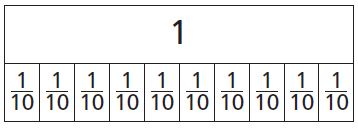
The fraction of the fairground with games and rides is ______ .
\(\frac{□}{□}\)
Answer: \(\frac{8}{10}\)
Explanation:
Given,
Miguel’s class went to the state fair. The fairground is divided into sections. Rides are in \(\frac{6}{10}\) of the fairground.
Games are in \(\frac{2}{10}\) of the fairground.
\(\frac{6}{10}\) + \(\frac{2}{10}\) = \(\frac{8}{10}\)
Question 4.
Part B
How much greater is the part of the fairground with rides than with farm exhibits? Explain how the model could be used to find the answer.
\(\frac{□}{□}\)
Answer: \(\frac{5}{10}\)
Explanation:
I could shade 6 sections to represent the section with the rides, and then I could cross out 1 section to represent the farm exhibits. This leaves 5 sections, so the part of the fairground with rides is 5/10 or 1/2 greater than the part with farm exhibits.
Question 5.
Rita is making chili. The recipe calls for 2 \(\frac{3}{4}\) cups of tomatoes. How many cups of tomatoes, written as a fraction greater than one, are used in the recipe?
_____ cups
Answer: 11/4 cups
Explanation:
Given,
Rita is making chili. The recipe calls for 2 \(\frac{3}{4}\) cups of tomatoes.
Convert from the mixed fraction to the improper fraction.
2 \(\frac{3}{4}\) = 11/4 cups
Question 6.
Lamar’s mom sells sports equipment online. She sold \(\frac{9}{10}\) of the sports equipment. Select a way \(\frac{9}{10}\) can be written as a sum of fractions. Mark all that apply.
Options:
a. \(\frac{1}{10}+\frac{1}{10}+\frac{1}{10}+\frac{1}{10}+\frac{2}{10}\)
b. \(\frac{3}{10}+\frac{2}{10}+\frac{3}{10}+\frac{1}{10}\)
c. \(\frac{2}{10}+\frac{2}{10}+\frac{2}{10}+\frac{2}{10}\)
d. \(\frac{4}{10}+\frac{1}{10}+\frac{1}{10}+\frac{3}{10}\)
e. \(\frac{4}{10}+\frac{3}{10}+\frac{1}{10}+\frac{1}{10}+\frac{1}{10}\)
f. \(\frac{2}{10}+\frac{2}{10}+\frac{2}{10}+\frac{3}{10}\)
Answer: \(\frac{3}{10}+\frac{2}{10}+\frac{3}{10}+\frac{1}{10}\)
Explanation:
a. \(\frac{1}{10}+\frac{1}{10}+\frac{1}{10}+\frac{1}{10}+\frac{2}{10}\) = 6/10 ≠ 9/10
b. \(\frac{3}{10}+\frac{2}{10}+\frac{3}{10}+\frac{1}{10}\) = 9/10
c. \(\frac{2}{10}+\frac{2}{10}+\frac{2}{10}+\frac{2}{10}\) = 8/10
d. \(\frac{4}{10}+\frac{1}{10}+\frac{1}{10}+\frac{3}{10}\) = 9/10
e. \(\frac{4}{10}+\frac{3}{10}+\frac{1}{10}+\frac{1}{10}+\frac{1}{10}\) = 10/10 ≠ 9/10
f. \(\frac{2}{10}+\frac{2}{10}+\frac{2}{10}+\frac{3}{10}\) = 9/10
Thus the suitable answers are b, d, f.
Fractions and Properties of Addition – Page No. 449
Question 7.
Bella brought \(\frac{8}{10}\) gallon of water on a hiking trip. She drank \(\frac{6}{10}\) gallon of water. How much water is left?
\(\frac{□}{□}\) gallons
Answer: \(\frac{2}{10}\) gallons
Explanation:
Given,
Bella brought \(\frac{8}{10}\) gallon of water on a hiking trip.
She drank \(\frac{6}{10}\) gallon of water.
To find how much water is left we have to subtract the two fractions.
\(\frac{8}{10}\) – \(\frac{6}{10}\) = \(\frac{2}{10}\) gallons
Question 8.
In a survey, \(\frac{6}{10}\) of the students chose Saturday and \(\frac{1}{10}\) chose Monday as their favorite day of the week. What fraction shows the students who chose Saturday or Monday as their favorite day?
Part A
Shade the model to show your answer.
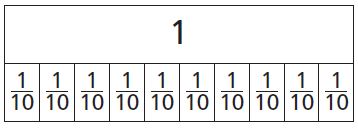
\(\frac{□}{□}\)
Answer: \(\frac{7}{10}\)
Explanation:
Given,
In a survey, \(\frac{6}{10}\) of the students chose Saturday and \(\frac{1}{10}\) chose Monday as their favorite day of the week.
\(\frac{6}{10}\) + \(\frac{1}{10}\) = \(\frac{7}{10}\)
Question 8.
Part B
How are the numerator and denominator of your answer related to the model? Explain.
Type below:
___________
Answer:
The numerator shows the number of parts shaded. The denominator shows the size of the parts.
Question 9.
Match the equation with the property used.

Type below:
__________________
Answer:

Fractions and Properties of Addition – Page No. 450
Question 10.
For numbers 10a–10e, select Yes or No to show if the sum or difference is correct.
(a) \(\frac{2}{8}+\frac{1}{8}=\frac{3}{8}\)
i. yes
ii. no
Answer: Yes
Explanation:
Denominators are the same but the numerators are different. So, add the numerators.
\(\frac{2}{8}+\frac{1}{8}=\frac{3}{8}\)
Thus the above statement is true.
Question 10.
(b) \(\frac{4}{5}+\frac{1}{5}=\frac{5}{5}\)
i. yes
ii. no
Answer: Yes
Explanation:
Denominators are the same but the numerators are different. So, add the numerators.
\(\frac{4}{5}+\frac{1}{5}=\frac{5}{5}\)
Thus the above statement is true.
Question 10.
(c) \(\frac{4}{6}+\frac{1}{6}=\frac{5}{12}\)
i. yes
ii. no
Answer: No
Explanation:
Denominators are the same but the numerators are different. So, add the numerators.
\(\frac{4}{6}+\frac{1}{6}=\frac{5}{6}\)
Thus the above statement is false.
Question 10.
(d) \(\frac{6}{12}-\frac{4}{12}=\frac{2}{12}\)
i. yes
ii. no
Answer: Yes
Explanation:
Denominators are the same but the numerators are different. So, subtract the numerators.
\(\frac{6}{12}-\frac{4}{12}=\frac{2}{12}\)
Thus the above statement is true.
Question 10.
(e) \(\frac{7}{9}-\frac{2}{9}=\frac{9}{9}\)
i. yes
ii. no
Answer: No
Explanation:
Denominators are the same but the numerators are different. So, subtract the numerators.
\(\frac{7}{9}-\frac{2}{9}=\frac{5}{9}\)
Thus the above statement is false.
Question 11.
Gina has 5 \(\frac{2}{6}\) feet of silver ribbon and 2 \(\frac{4}{6}\) of gold ribbon. How much more silver ribbon does Gina have than gold ribbon?
______ \(\frac{□}{□}\) feet more silver ribbon.
Answer: 2 \(\frac{4}{6}\) feet more silver ribbon.
Explanation:
Given,
Gina has 5 \(\frac{2}{6}\) feet of silver ribbon and 2 \(\frac{4}{6}\) of gold ribbon.
5 \(\frac{2}{6}\) – 2 \(\frac{4}{6}\)
= \(\frac{32}{6}\) – \(\frac{16}{6}\)
= \(\frac{16}{6}\)
Convert from improper fraction to the mixed fraction.
2 \(\frac{4}{6}\) feet more silver ribbon
Therefore Gina has 2 \(\frac{4}{6}\) feet more silver ribbon than gold ribbon.
Question 12.
Jill is making a long cape. She needs 4 \(\frac{1}{3}\) yards of blue fabric for the outside of the cape. She needs 3 \(\frac{2}{3}\) yards of purple fabric for the lining of the cape.
Part A
Jill incorrectly subtracted the two mixed numbers to find how much more blue fabric than purple fabric she should buy. Her work is shown below.
\(4 \frac{1}{3}-3 \frac{2}{3}=\frac{12}{3}-\frac{9}{3}=\frac{3}{3}\)
Why is Jill’s work incorrect?
Type below:
__________________
Answer:
Jill changed only the whole number parts of the mixed number to thirds. She forgot to add the fraction part of the mixed number.
Question 12.
Part B
How much more blue fabric than purple fabric should Jill buy? Show your work.
\(\frac{□}{□}\)
Answer:
4 \(\frac{1}{3}\) – 3 \(\frac{2}{3}\)
= \(\frac{13}{3}\) – \(\frac{11}{3}\) = \(\frac{2}{3}\)
Jill should buy \(\frac{2}{3}\) yard more blue fabric than purple fabric.
Fractions and Properties of Addition – Page No. 451
Question 13.
Russ has two jars of glue. One jar is \(\frac{1}{5}\) full. The other jar is \(\frac{2}{5}\) full.

Use the fractions to write an equation to find the amount of glue Russ has.

Type below:
_________________
Answer:
![]()
Explanation:
Given,
Russ has two jars of glue. One jar is \(\frac{1}{5}\) full.
The other jar is \(\frac{2}{5}\) full.
\(\frac{1}{5}\) + \(\frac{2}{5}\) = \(\frac{3}{5}\)
Question 14.
Gertie ran \(\frac{3}{4}\) mile during physical education class. Sarah ran \(\frac{2}{4}\) mile during the same class. How much farther did Gertie run than Sarah? Shade the model to show your answer.

\(\frac{□}{□}\)
Answer: \(\frac{1}{4}\)
Explanation:
Given that,
Gertie ran \(\frac{3}{4}\) mile during physical education class.
Sarah ran \(\frac{2}{4}\) mile during the same class.
\(\frac{3}{4}\) – \(\frac{2}{4}\) = \(\frac{1}{4}\)
Question 15.
Teresa planted marigolds in \(\frac{2}{8}\) of her garden and petunias in \(\frac{3}{8}\) of her garden. What fraction of the garden has marigolds and petunias?
\(\frac{□}{□}\)
Answer: \(\frac{5}{8}\)
Explanation:
Given,
Teresa planted marigolds in \(\frac{2}{8}\) of her garden and petunias in \(\frac{3}{8}\) of her garden.
Add both the fractions 2/8 and 3/8 to find the fraction of the garden has marigolds and petunias.
\(\frac{2}{8}\) + \(\frac{3}{8}\) = \(\frac{5}{8}\)
Question 16.
Draw a line to show the mixed number and fraction that have the same value.

Answer:

Question 17.
Each day, Tally’s baby sister eats \(\frac{1}{4}\) cup of rice cereal in the morning and \(\frac{1}{4}\) cup of rice cereal in the afternoon. It will take Tally’s sister  days to eat 2 cups of rice cereal.
days to eat 2 cups of rice cereal.
Type below:
_________________
Answer: 4
Explanation:
Each day she eats 1/2 cups of rice. But we want to know how long it will take to each 2 cups worth. so lets make an equation.
1/2 × x = 2
x = 4
Thus It will take 4 days to eat 2 cups of rice cereal.
Fractions and Properties of Addition – Page No. 452
Question 18.
Three girls are selling cases of popcorn to earn money for a band trip. In week 1, Emily sold 2 \(\frac{3}{4}\) cases, Brenda sold 4 \(\frac{1}{4}\) cases, and Shannon sold 3 \(\frac{1}{2}\) cases.
Part A
How many cases of popcorn have the girls sold in all? Explain how you found your answer.
______ \(\frac{□}{□}\)
Answer: 10 \(\frac{1}{2}\) cases
Explanation:
Given,
Three girls are selling cases of popcorn to earn money for a band trip. In week 1, Emily sold 2 \(\frac{3}{4}\) cases, Brenda sold 4 \(\frac{1}{4}\) cases, and Shannon sold 3 \(\frac{1}{2}\) cases.
First I add the whole numbers 2 + 4 + 3 = 9 cases. Then I add the fractions by combining 3/4 + 1/4 into one whole.
So, 9 + 1 + 1/2 = 10 \(\frac{1}{2}\) cases
Question 18.
Part B
The girls must sell a total of 35 cases in order to have enough money for the trip. Suppose they sell the same amount in week 2 and week 3 of the sale as in week 1. Will the girls have sold enough cases of popcorn to go on the trip? Explain.
______
Answer: No
Explanation:
Given,
The girls must sell a total of 35 cases in order to have enough money for the trip.
Suppose they sell the same amount in week 2 and week 3 of the sale as in week 1.
If I add the sales from the 3 weeks, or 10 1/2 + 10 1/2 + 10 1/2, the sum is only 31 1/2 cases of popcorn. Thus is less than 35 cases.
Question 19.
Henry ate \(\frac{3}{8}\) of a sandwich. Keith ate \(\frac{4}{8}\) of the same sandwich. How much more of the sandwich did Keith eat than Henry?
\(\frac{□}{□}\) of the sandwich
Answer: \(\frac{1}{8}\) of the sandwich
Explanation:
Given,
Henry ate \(\frac{3}{8}\) of a sandwich.
Keith ate \(\frac{4}{8}\) of the same sandwich.
\(\frac{4}{8}\) – \(\frac{3}{8}\) = \(\frac{1}{8}\) of the sandwich
Question 20.
For numbers 20a–20d, choose True or False for each sentence.
a. \(1 \frac{4}{9}+2 \frac{6}{9}\) is equal to 4 \(\frac{1}{9}\)
i. True
ii. False
Answer: True
Explanation:
\(1 \frac{4}{9}+2 \frac{6}{9}\) = 4 \(\frac{1}{9}\)
First add the whole numbers
1 + 2 = 3
4/9 + 6/9 = 10/9
Convert it into the mixed fractions
10/9 = 1 \(\frac{1}{9}\)
3 + 1 \(\frac{1}{9}\) = 4 \(\frac{1}{9}\)
Thus the above statement is true.
Question 20.
b. \(3 \frac{5}{6}+2 \frac{3}{6}\) is equal to 5 \(\frac{2}{6}\)
i. True
ii. False
Answer: False
Explanation:
First add the whole numbers
3 + 2 = 5
5/6 + 3/6 = 8/6
Convert it into the mixed fractions
8/6 = 1 \(\frac{2}{6}\)
5 + 1 \(\frac{2}{6}\) = 6 \(\frac{2}{6}\)
Thus the above statement is false.
Question 20.
c. \(4 \frac{5}{8}-2 \frac{4}{8}\) is equal to 2 \(\frac{3}{8}\)
i. True
ii. False
Answer: False
Explanation:
\(4 \frac{5}{8}-2 \frac{4}{8}\)
First subtract the whole numbers
4 – 2 = 2
5/8 – 4/8 = 1/8
= 2 \(\frac{1}{8}\)
Thus the above statement is false.
Question 20.
d. \(5 \frac{5}{8}-3 \frac{2}{8}\) is equal to 2 \(\frac{3}{8}\)
i. True
ii. False
Answer: True
Explanation:
\(5 \frac{5}{8}-3 \frac{2}{8}\)
5 – 3 = 2
5/8 – 2/8 = 3/8
= 2 \(\frac{3}{8}\)
\(5 \frac{5}{8}-3 \frac{2}{8}\) = 2 \(\frac{3}{8}\)
Thus the above statement is true.
Question 21.
Justin lives 4 \(\frac{3}{5}\) miles from his grandfather’s house. Write the mixed number as a fraction greater than one.
4 \(\frac{3}{5}\) = \(\frac{□}{□}\)
Answer: \(\frac{23}{5}\)
Explanation:
Justin lives 4 \(\frac{3}{5}\) miles from his grandfather’s house.
Convert from mixed fractions to an improper fraction.
4 \(\frac{3}{5}\) = \(\frac{23}{5}\)
Fractions and Properties of Addition – Page No. 457
Question 1.
Use the picture to complete the equations.

\(\frac{3}{4}\) = _ + _ + _
\(\frac{3}{4}\) = _ × \(\frac{1}{4}\)
Type below:
___________
Answer: 3
Explanation:
\(\frac{3}{4}\)
The unit fraction of \(\frac{3}{4}\) is \(\frac{1}{4}\) + \(\frac{1}{4}\) + \(\frac{1}{4}\)
\(\frac{3}{4}\) = 3 × \(\frac{1}{4}\)
Thus the whole number is 3.
Write the fraction as a product of a whole number and a unit fraction.
Question 2.
\(\frac{4}{5}\) = ______ × \(\frac{1}{5}\)
Answer: 4
Explanation:
The unit fraction for \(\frac{4}{5}\) is \(\frac{1}{5}\) + \(\frac{1}{5}\) + \(\frac{1}{5}\) + \(\frac{1}{5}\)
\(\frac{4}{5}\) = 4 × \(\frac{1}{5}\)
Thus the whole number is 4.
Question 3.
\(\frac{3}{10}\) = ______ × \(\frac{1}{10}\)
Answer: 3
Explanation:
The unit fraction for \(\frac{3}{10}\) is \(\frac{1}{10}\) + \(\frac{1}{10}\) + \(\frac{1}{10}\)
\(\frac{3}{10}\) = 3 × \(\frac{1}{10}\)
Thus the whole number is 3.
Question 4.
\(\frac{8}{3}\) = ______ × \(\frac{1}{3}\)
Answer: 8
Explanation:
The unit fraction for \(\frac{8}{3}\) is \(\frac{1}{3}\) + \(\frac{1}{3}\) + \(\frac{1}{3}\) + \(\frac{1}{3}\) + \(\frac{1}{3}\) + \(\frac{1}{3}\) + \(\frac{1}{3}\) + \(\frac{1}{3}\)
\(\frac{8}{3}\) = 8 × \(\frac{1}{3}\)
Thus the whole number is 8.
List the next four multiples of the unit fraction.
Question 5.
\(\frac{1}{6}\) ,
Type below:
___________
Answer: 2/6, 3/6, 4/6, 5/6
Explanation:
The next four multiples of \(\frac{1}{6}\) is \(\frac{2}{6}\) , \(\frac{3}{6}\) , \(\frac{4}{6}\) , \(\frac{5}{6}\)
Question 6.
\(\frac{1}{3}\) ,
Type below:
___________
Answer: 2/3, 3/3, 4/3, 5/3
Explanation:
The next four multiples of \(\frac{1}{3}\) is \(\frac{2}{3}\), \(\frac{3}{3}\), \(\frac{4}{3}\) and \(\frac{5}{3}\)
Write the fraction as a product of a whole number and a unit fraction.
Question 7.
\(\frac{5}{6}\) = ______ × \(\frac{1}{6}\)
Answer: 5
Explanation:
The unit fraction for \(\frac{5}{6}\) is \(\frac{1}{6}\) + \(\frac{1}{6}\) + \(\frac{1}{6}\) + \(\frac{1}{6}\) + \(\frac{1}{6}\)
\(\frac{5}{6}\) = 5 × \(\frac{1}{6}\)
Thus the whole number is 5.
Question 8.
\(\frac{9}{4}\) = ______ × \(\frac{1}{4}\)
Answer: 9
Explanation:
The unit fraction for \(\frac{9}{4}\) is \(\frac{1}{4}\) + \(\frac{1}{4}\) + \(\frac{1}{4}\) + \(\frac{1}{4}\) + \(\frac{1}{4}\) + \(\frac{1}{4}\) + \(\frac{1}{4}\) + \(\frac{1}{4}\) + \(\frac{1}{4}\)
\(\frac{9}{4}\) = 9 × \(\frac{1}{4}\)
Thus the whole number is 9.
Question 9.
\(\frac{3}{100}\) = ______ × \(\frac{1}{100}\)
Answer: 3
Explanation:
The unit fraction for \(\frac{3}{100}\) is \(\frac{1}{100}\) + \(\frac{1}{100}\) + \(\frac{1}{100}\)
\(\frac{3}{100}\) = 3 × \(\frac{1}{100}\)
Thus the whole number is 3.
List the next four multiples of the unit fraction.
Question 10.
\(\frac{1}{10}\) ,
Type below:
___________
Answer: 2/10, 3/10, 4/10, 5/10
Explanation:
The next four multiples of \(\frac{1}{10}\) is 2/10, 3/10, 4/10, 5/10
Question 11.
\(\frac{1}{8}\) ,
Type below:
___________
Answer: 2/8, 3/8, 4/8, 5/8
Explanation:
The next four multiples of \(\frac{1}{8}\) is 2/8, 3/8, 4/8, 5/8.
Question 12.
Robyn uses \(\frac{1}{2}\) cup of blueberries to make each loaf of blueberry bread. Explain how many loaves of blueberry bread she can make with 2 \(\frac{1}{2}\) cups of blueberries.
_____ loaves of blueberry bread
Answer: 5 loaves of blueberry bread
Explanation:
Given,
Robyn uses \(\frac{1}{2}\) cup of blueberries to make each loaf of blueberry bread.
The unit fraction for 2 \(\frac{1}{2}\) is \(\frac{1}{2}\) + \(\frac{1}{2}\) + \(\frac{1}{2}\) + \(\frac{1}{2}\) + \(\frac{1}{2}\)
= 5 loaves of blueberry bread
Question 13.
Nigel cut a loaf of bread into 12 equal slices. His family ate some of the bread and now \(\frac{5}{12}\) of the loaf is left. Nigel wants to put each of the leftover slices in its own bag. How many bags does Nigel need?
_____ bags
Answer: 5 bags
Explanation:
Given,
Nigel cut a loaf of bread into 12 equal slices. His family ate some of the bread and now \(\frac{5}{12}\) of the loaf is left.
Nigel wants to put each of the leftover slices in its own bag.
\(\frac{5}{12}\) = \(\frac{1}{12}\) + \(\frac{1}{12}\) + \(\frac{1}{12}\) + \(\frac{1}{12}\) + \(\frac{1}{12}\)
= 5 bags
Question 14.
Which fraction is a multiple of \(\frac{1}{5}\)? Mark all that apply.
Options:
a. \(\frac{4}{5}\)
b. \(\frac{5}{7}\)
c. \(\frac{5}{9}\)
d. \(\frac{3}{5}\)
Answer: \(\frac{4}{5}\), \(\frac{3}{5}\)
Explanation:
The multiples of the \(\frac{1}{5}\) is \(\frac{4}{5}\), \(\frac{3}{5}\).
Fractions and Properties of Addition – Page No. 458
Sense or Nonsense?
Question 15.
Whose statement makes sense? Whose statement is nonsense? Explain your reasoning.
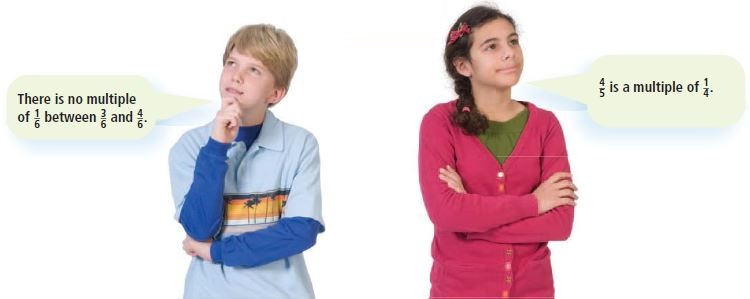
Type below:
_________________
Answer: The boy’s statement makes sense. Because 4/5 is not the multiple of 1/4.
Question 15.
For the statement that is nonsense, write a new statement that makes sense.
Type below:
_________________
Answer: 4/5 is the multiple of 1/5.
Conclusion:
Use the practice and Homework pages to provide 4th grade students with more practice of the concepts of add and subtract fractions. Encourage students to use our Go Math Answer Key to record the answers. To solve more questions go through the Go Math Grade 4 Answer Key Chapter 7 Add and Subtract Fractions Homework Practice FL pdf.
